
Italy
Italy
Cruise overview
WHY BOOK WITH US?
- ✔ The Deluxe Cruises’ team has extensive experience in ultra-luxury cruising.
- ✔ Call now to speak to our helpful and experienced Cruise Concierge team.
- ✔ Enjoy our Unique Deluxe Cruises Bonus for substantial savings.
- ✔ Our team will tailor your holiday to your exacting requirements.
- ✔ As agents, we work under the protection of each cruise lines ABTA / ATOL licences
About Barcelona
The infinite variety of street life, the nooks and crannies of the medieval Barri Gòtic, the ceramic tile and stained glass of Art Nouveau facades, the art and music, the throb of street life, the food (ah, the food!)—one way or another, Barcelona will find a way to get your full attention. The capital of Catalonia is a banquet for the senses, with its beguiling mix of ancient and modern architecture, tempting cafés and markets, and sun-drenched Mediterranean beaches. A stroll along La Rambla and through waterfront Barceloneta, as well as a tour of Gaudí's majestic Sagrada Famíliaand his other unique creations, are part of a visit to Spain's second-largest city. Modern art museums and chic shops call for attention, too. Barcelona's vibe stays lively well into the night, when you can linger over regional wine and cuisine at buzzing tapas bars.
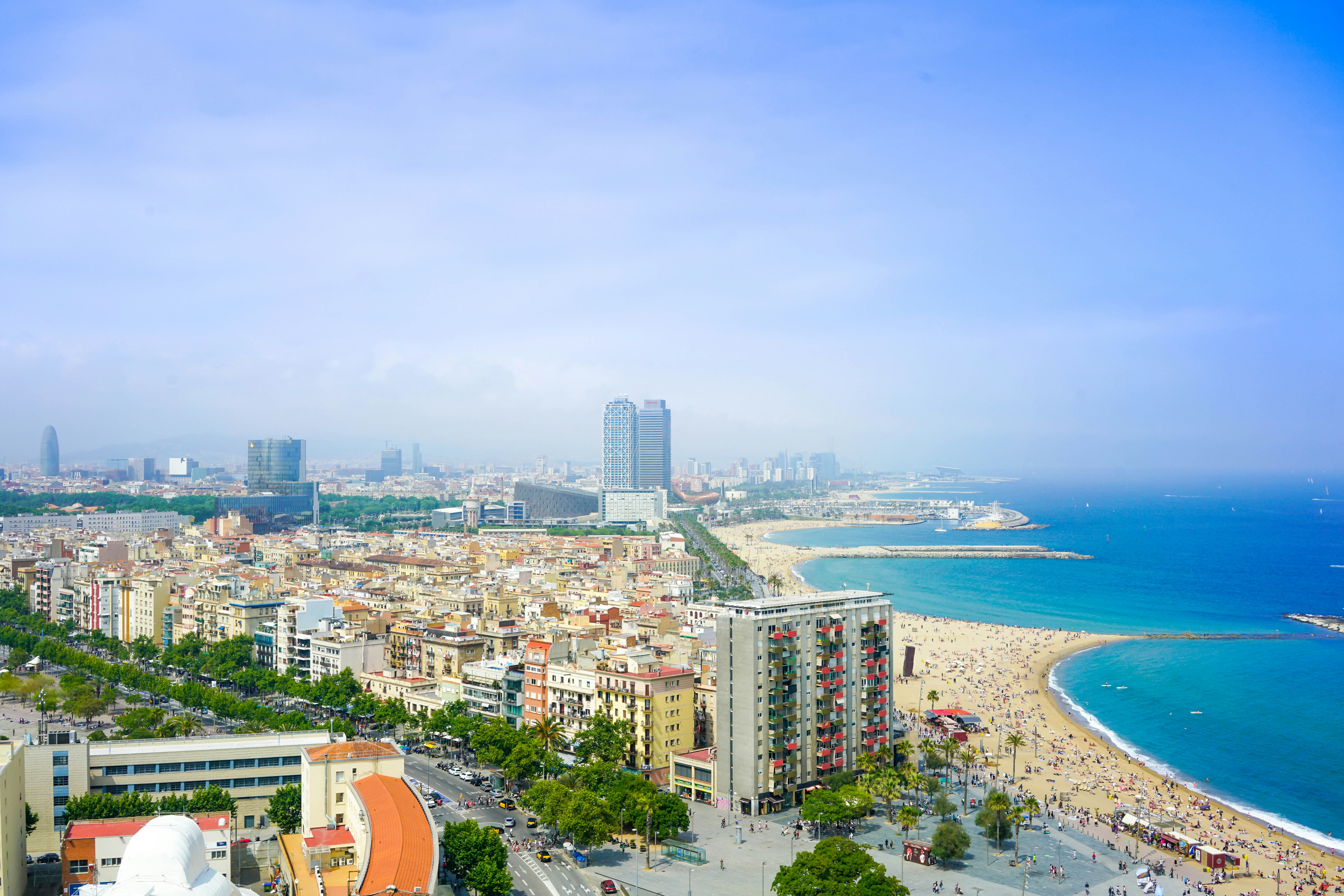



About Ibiza
Hedonistic and historic, Eivissa (Ibiza, in Castilian) is a city jam-packed with cafés, nightspots, and trendy shops; looming over it are the massive stone walls of Dalt Vila —the medieval city declared a UNESCO World Heritage site in 1999—and its Gothic cathedral. Squeezed between the north walls of the old city and the harbor is Sa Penya, a long labyrinth of stone-paved streets that offer some of the city's best offbeat shopping, snacking, and exploring. The tourist information office on Vara de Rey has a useful map of walks through the old city.
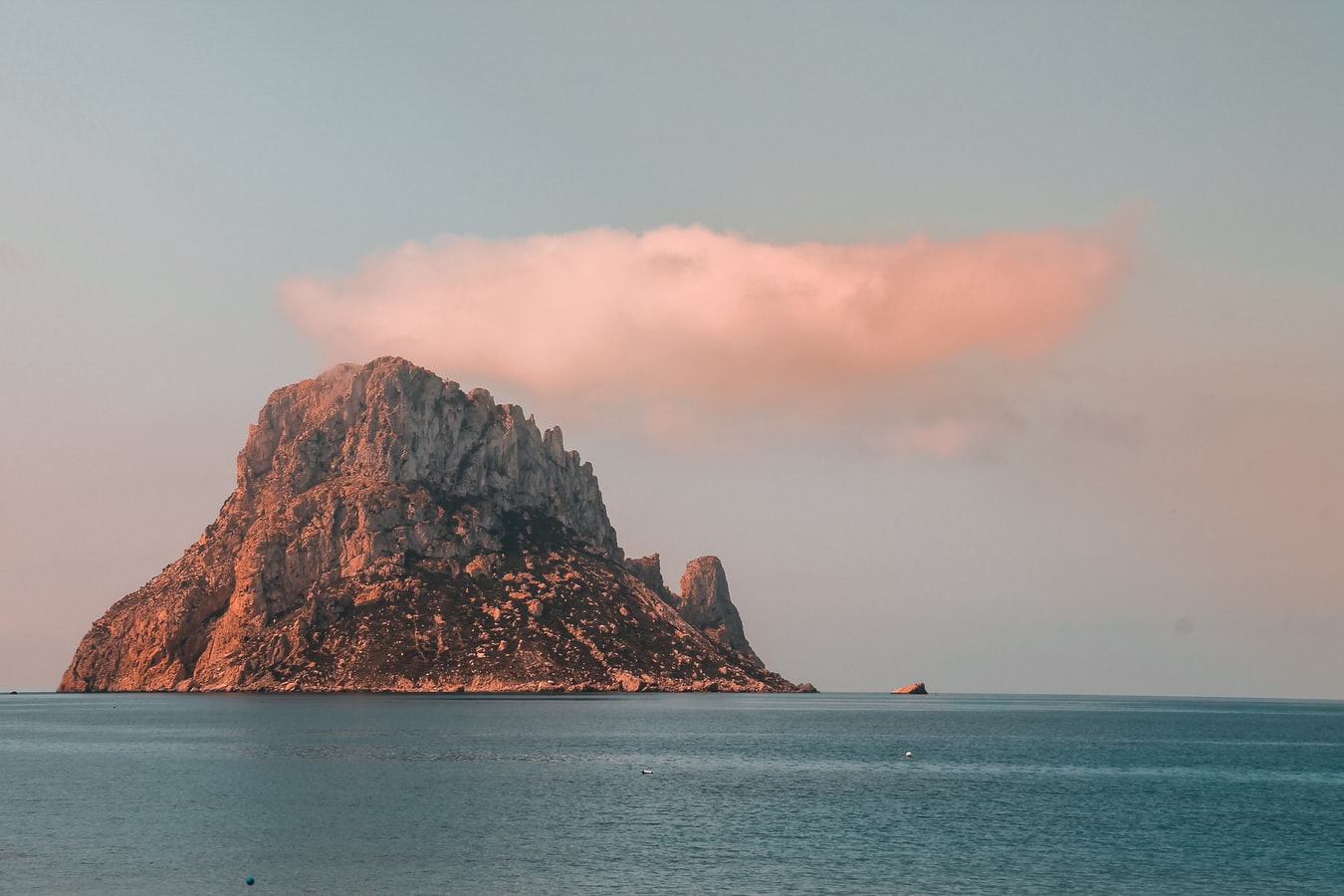
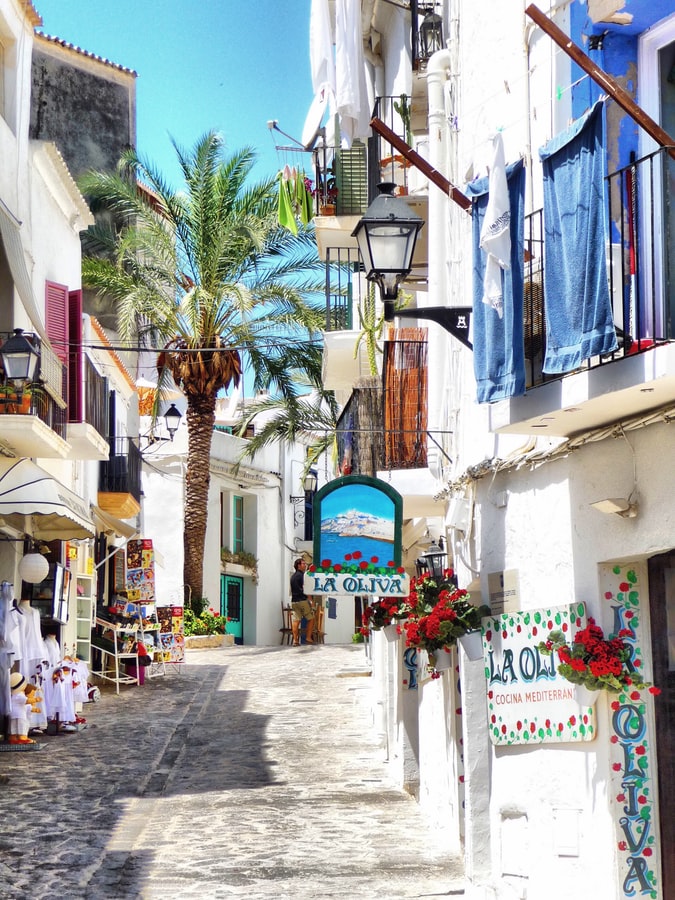
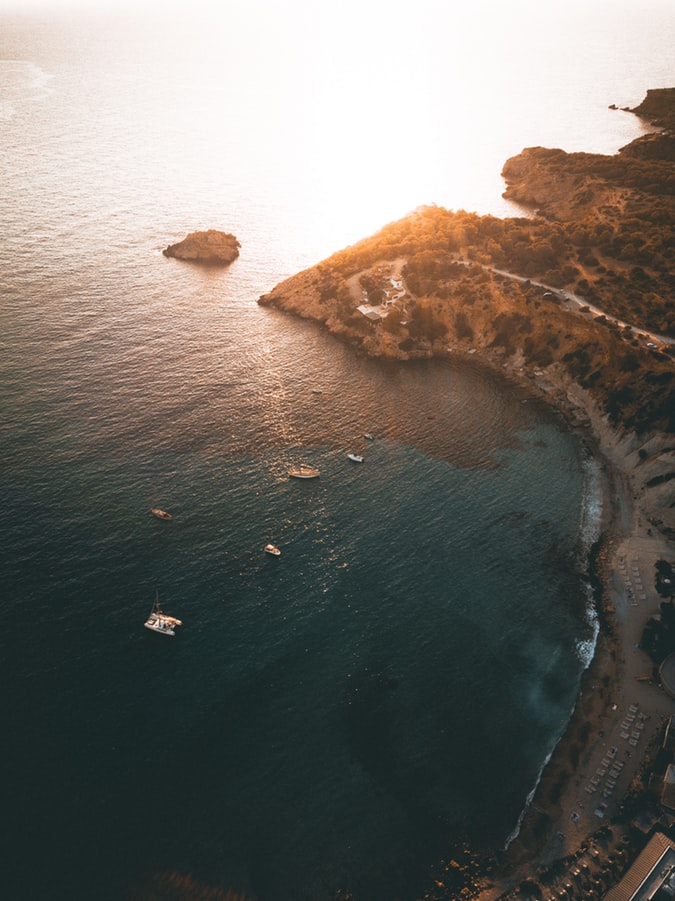
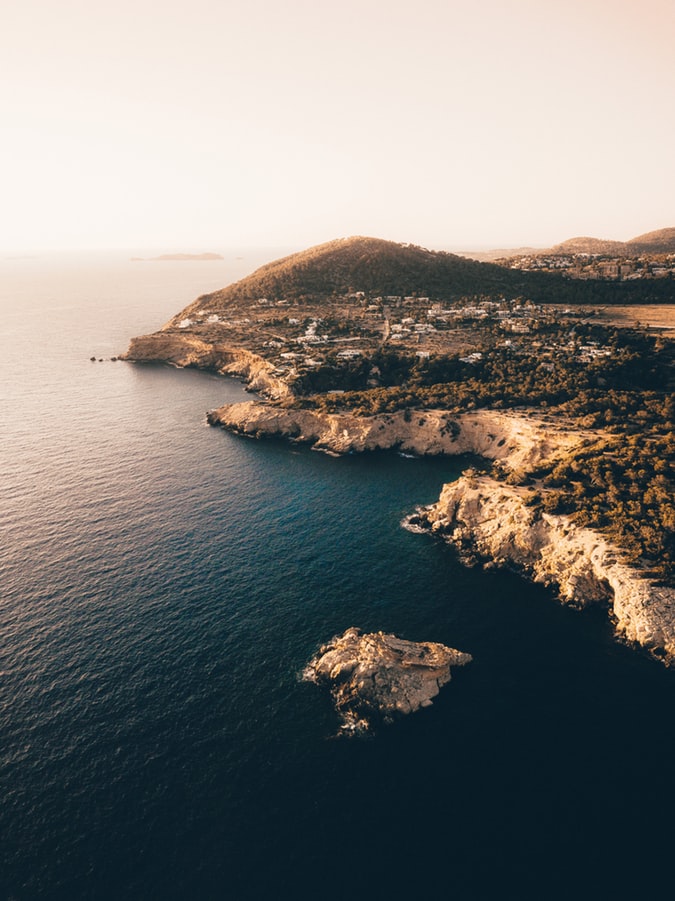
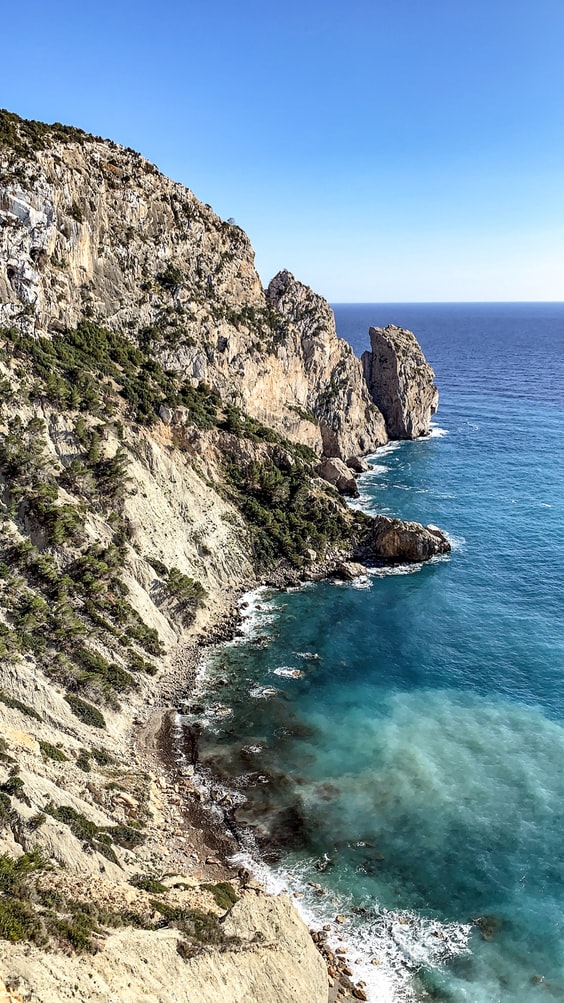
About Cagliari
Known in Sardinia as Casteddu, the island's capital has steep streets and impressive Italianate architecture, from modern to medieval. This city of nearly 160,000 people is characterized by a busy commercial center and waterfront with broad avenues and arched arcades, as well as by the typically narrow streets of the old hilltop citadel (called, simply, “Castello”). The Museo Archeologico makes a good starting point to a visit. The imposing Bastione di Saint Remy and Mercato di San Benedetto (one of the best fish markets in Italy) are both musts.
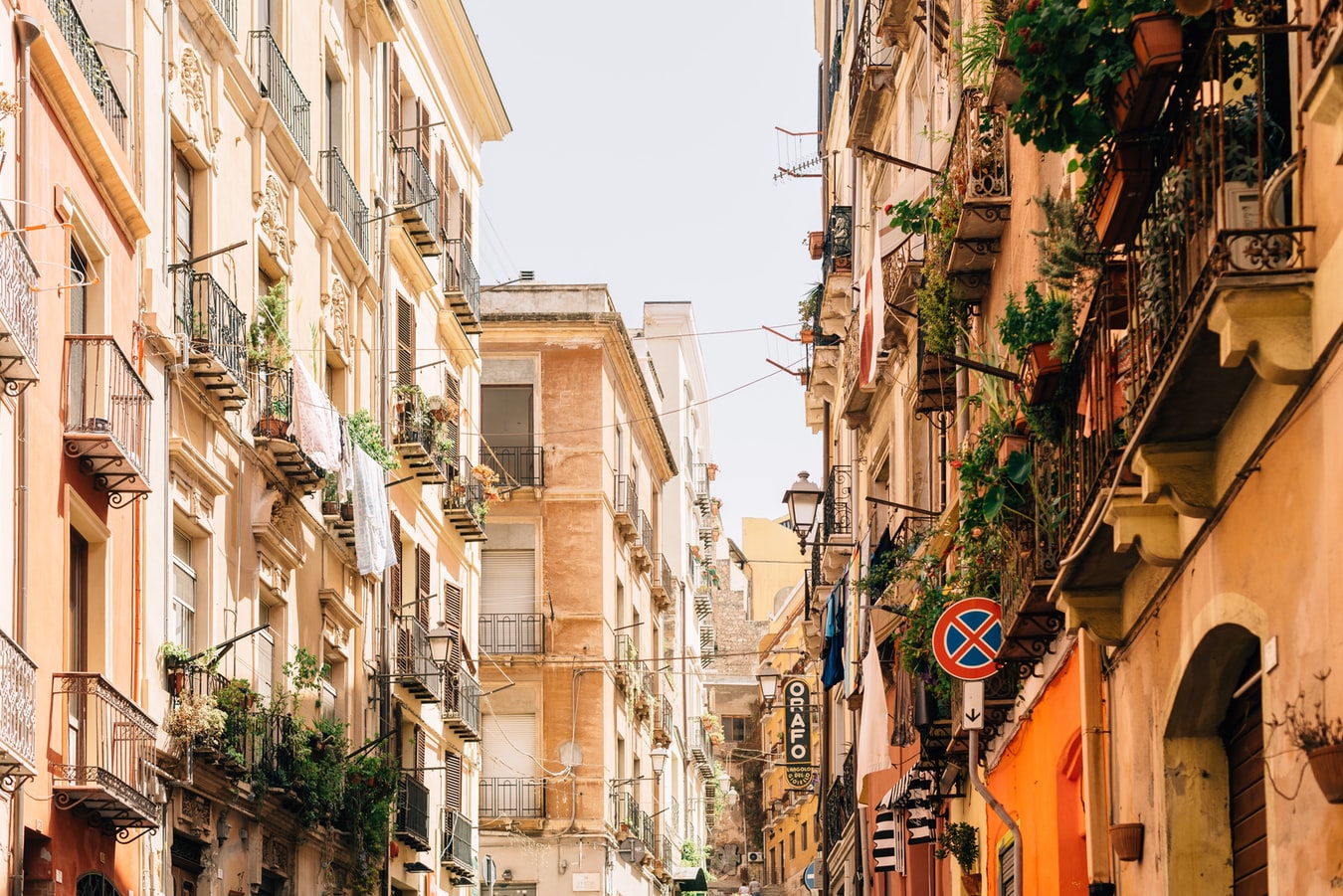
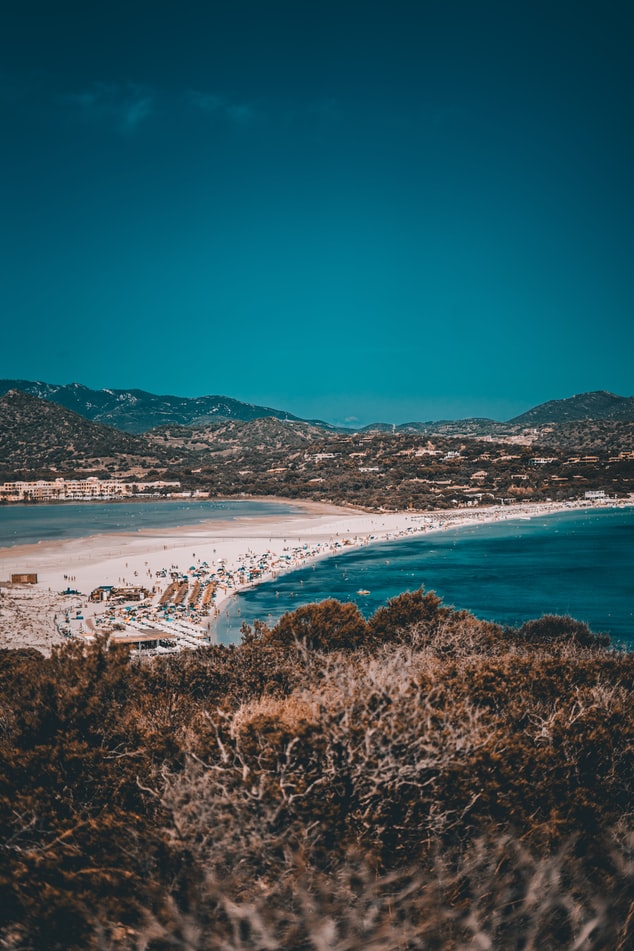
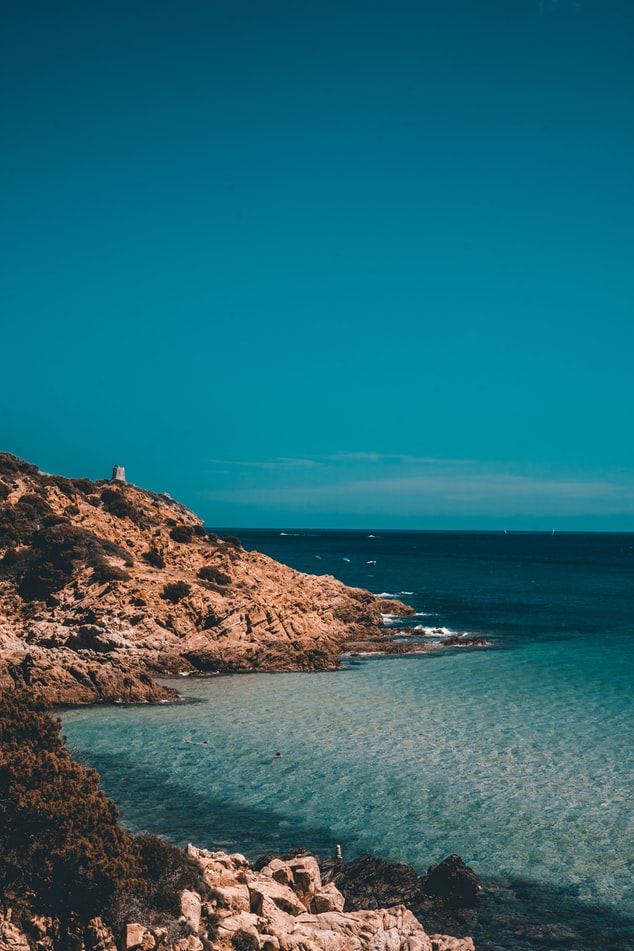
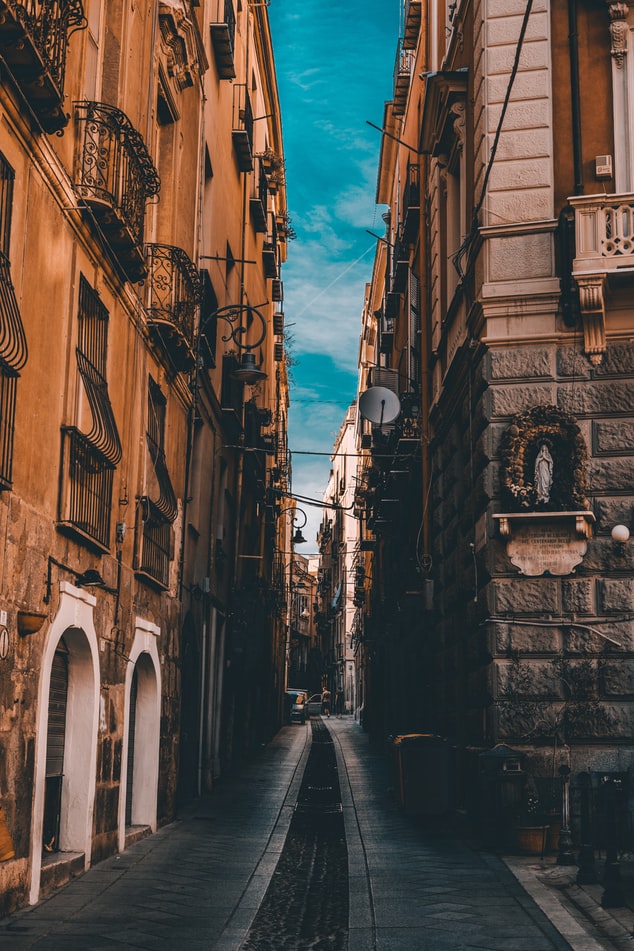
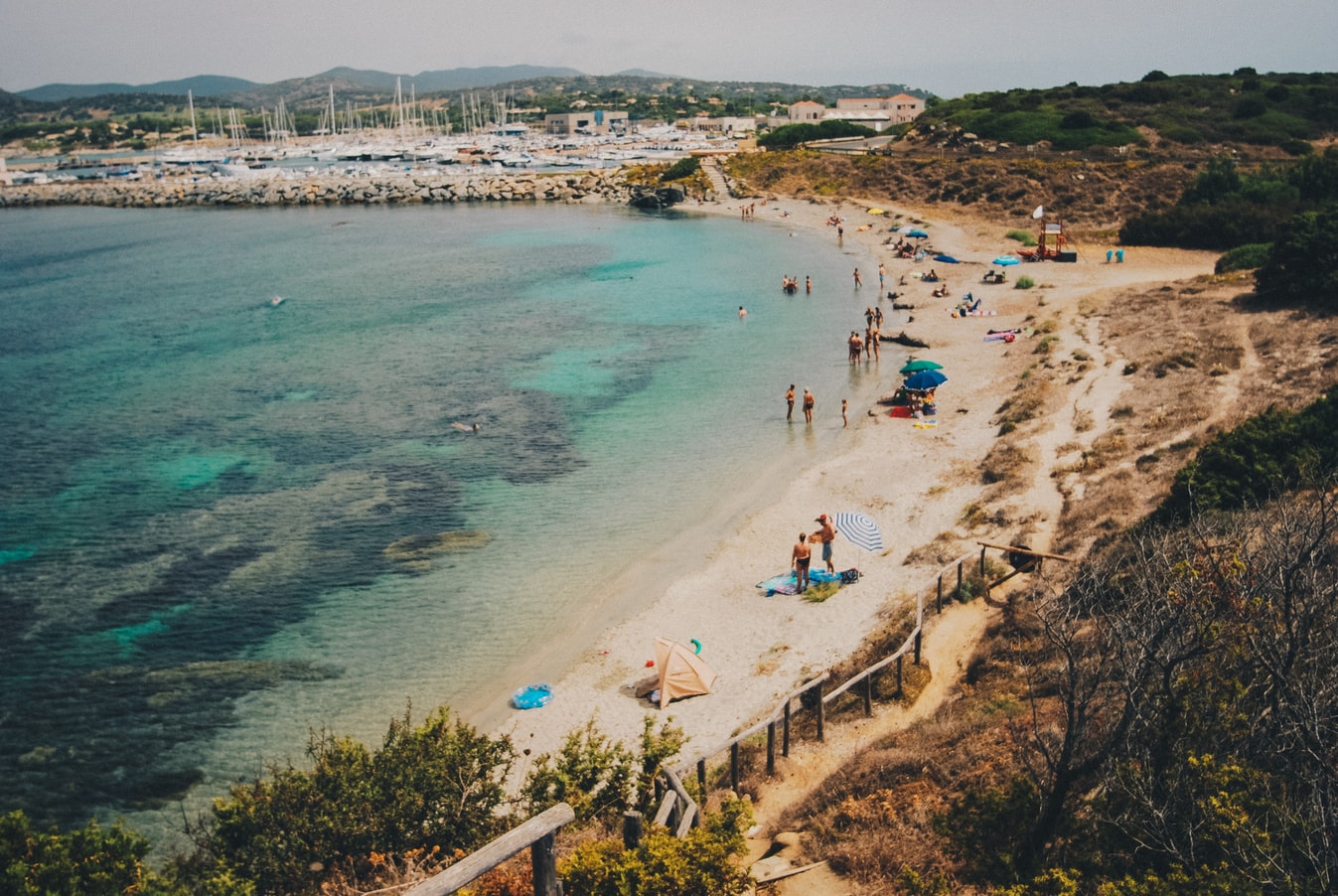
About Messina Strait
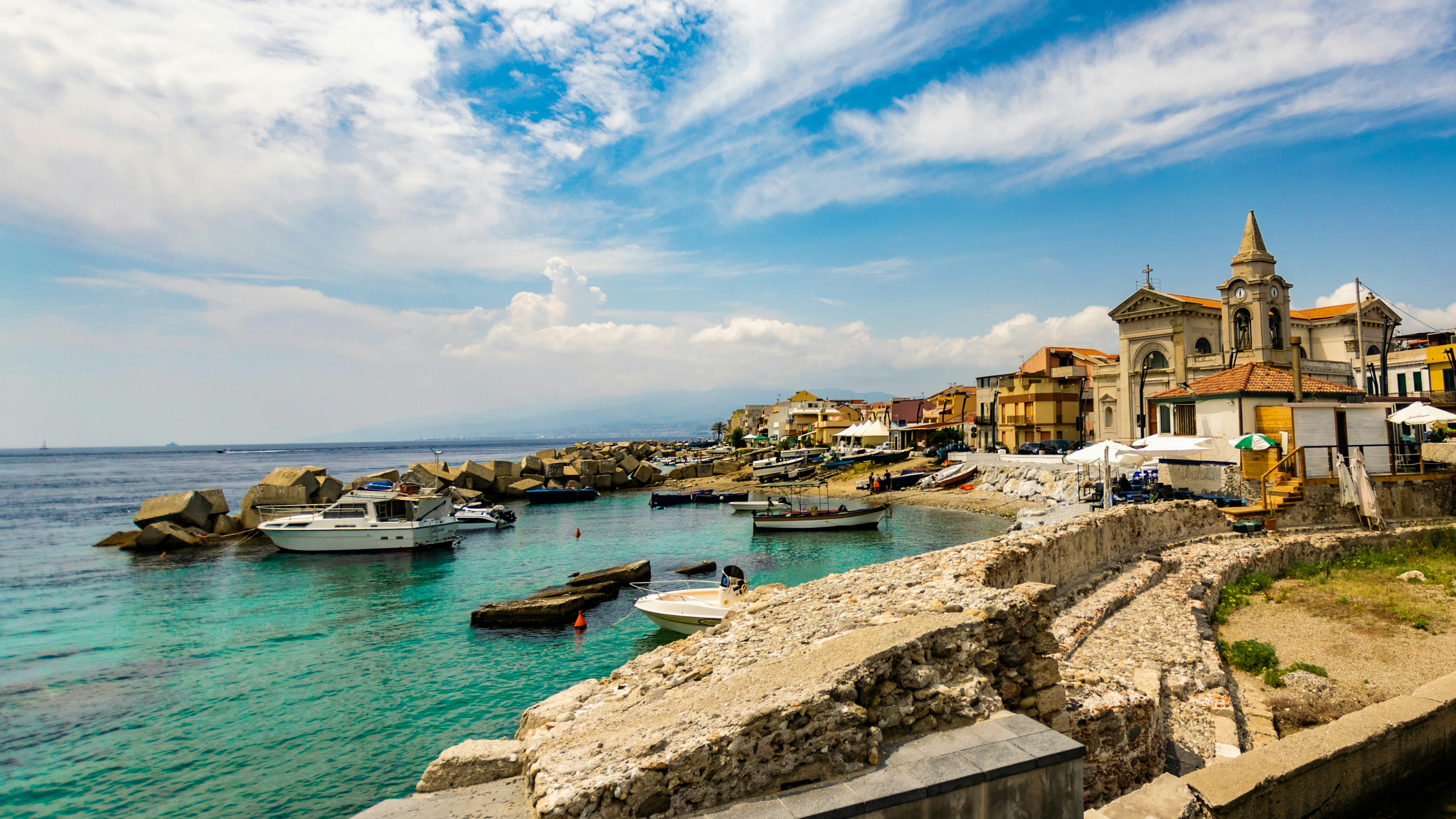
About Messina
Home to the Museo Regionale of Messina, known for featuring two of Caravaggio's paintings, the city is also famous for having been the capital of the ancient kingdom of Sicily.
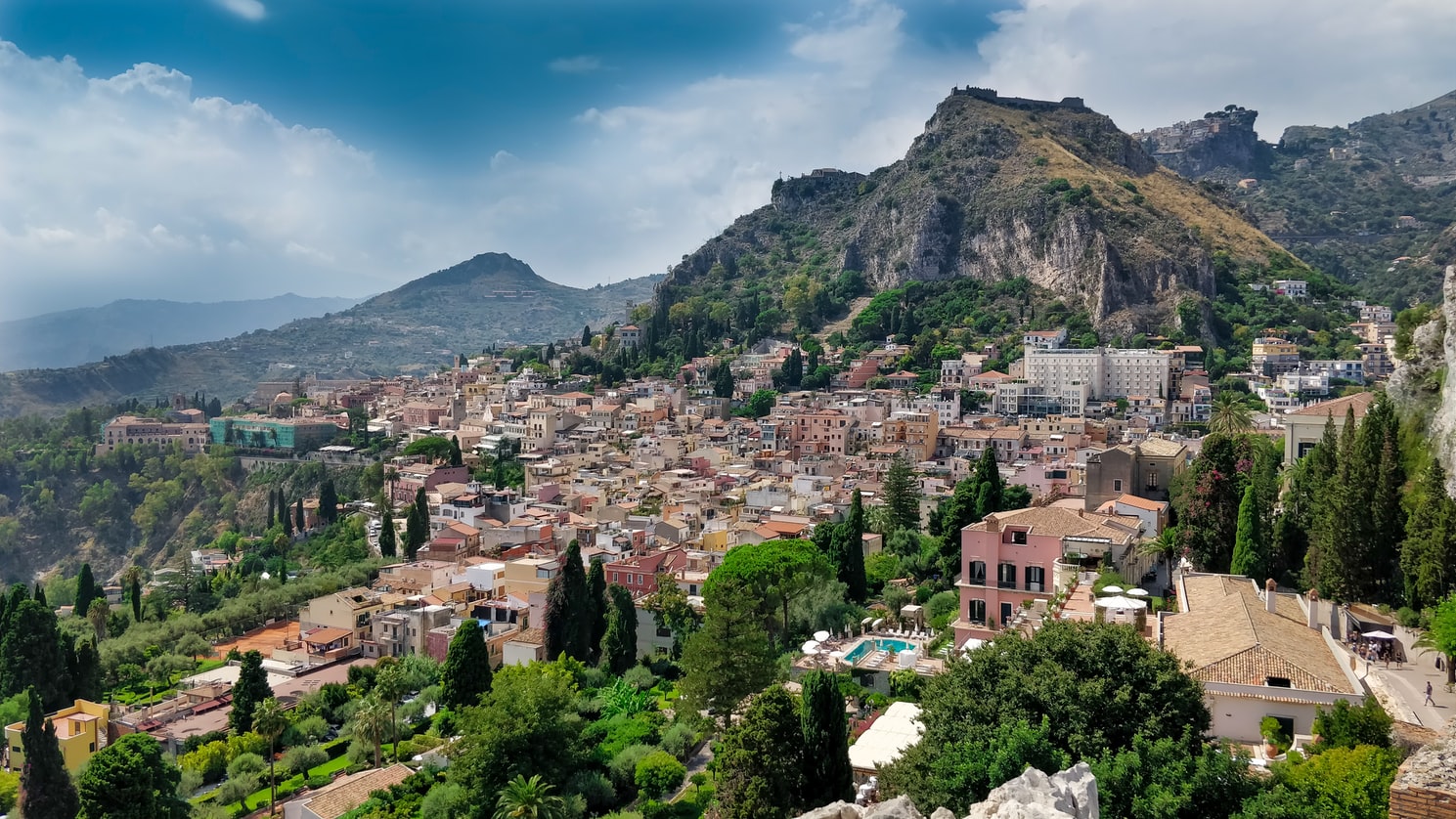
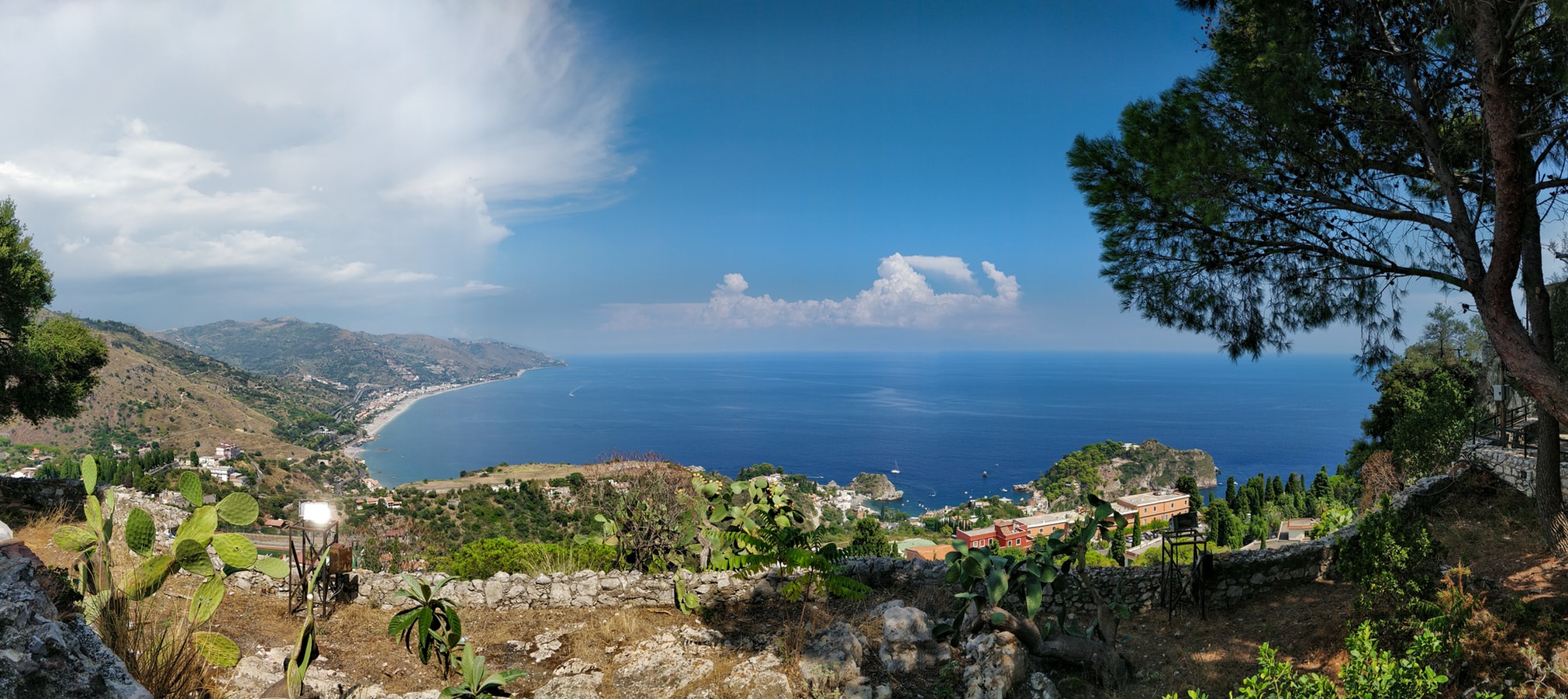
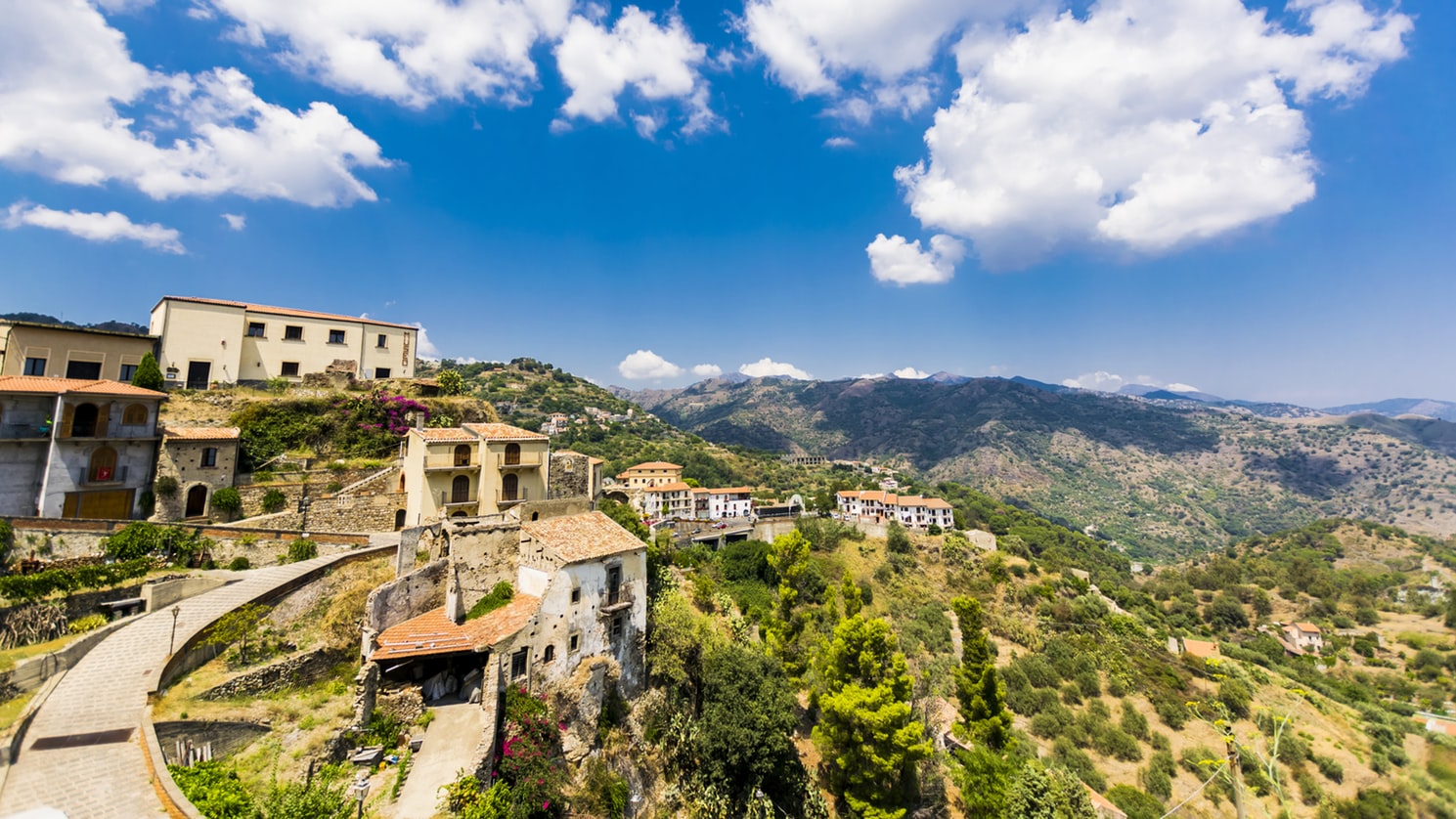
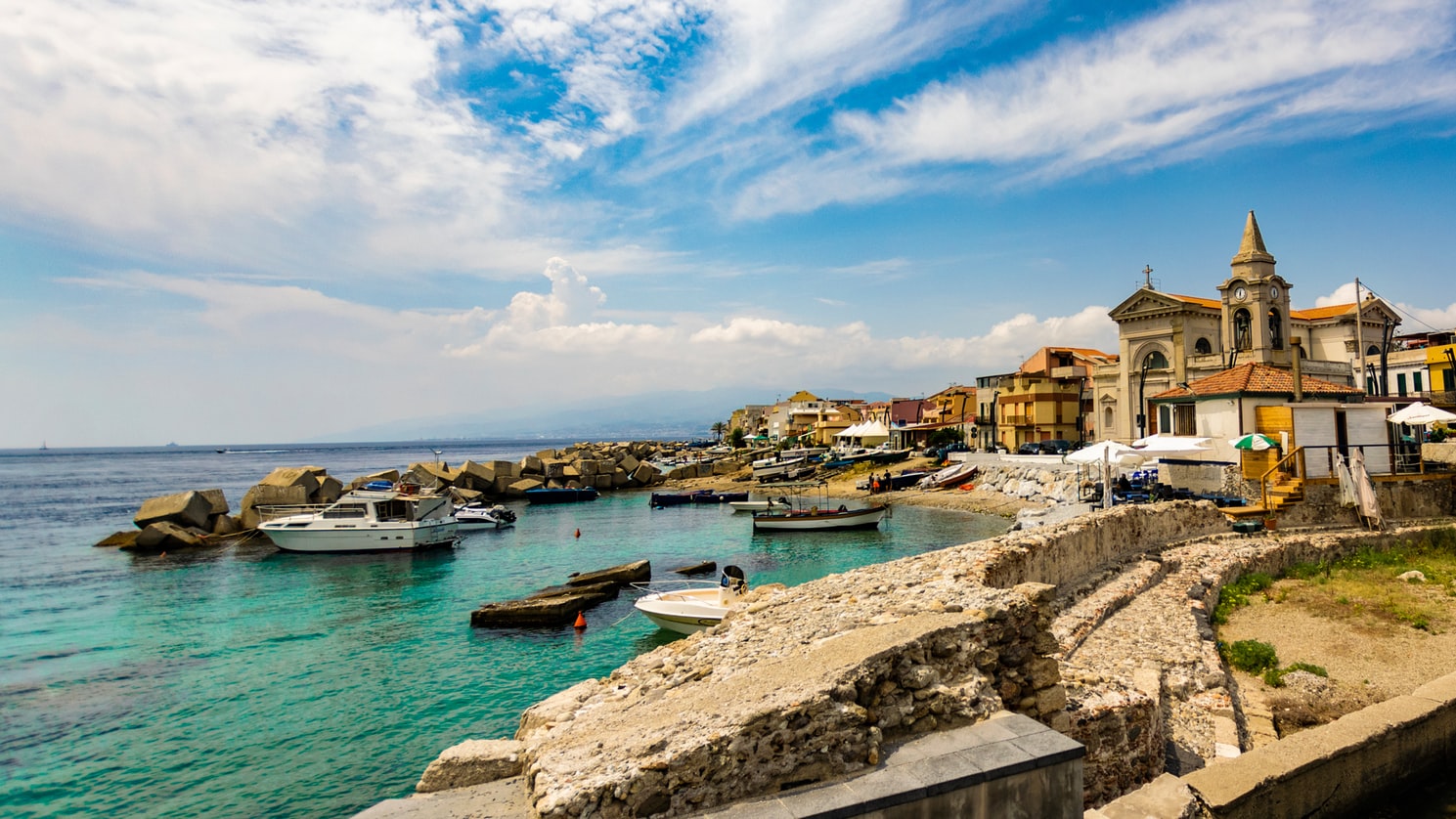
About Salerno
Salerno is an Italian city located on the Gulf of Salerno. Famous for being home to the first medical university, Salerno is a great destination for anyone looking for gorgeous sea views filled with sunshine and Italian food.
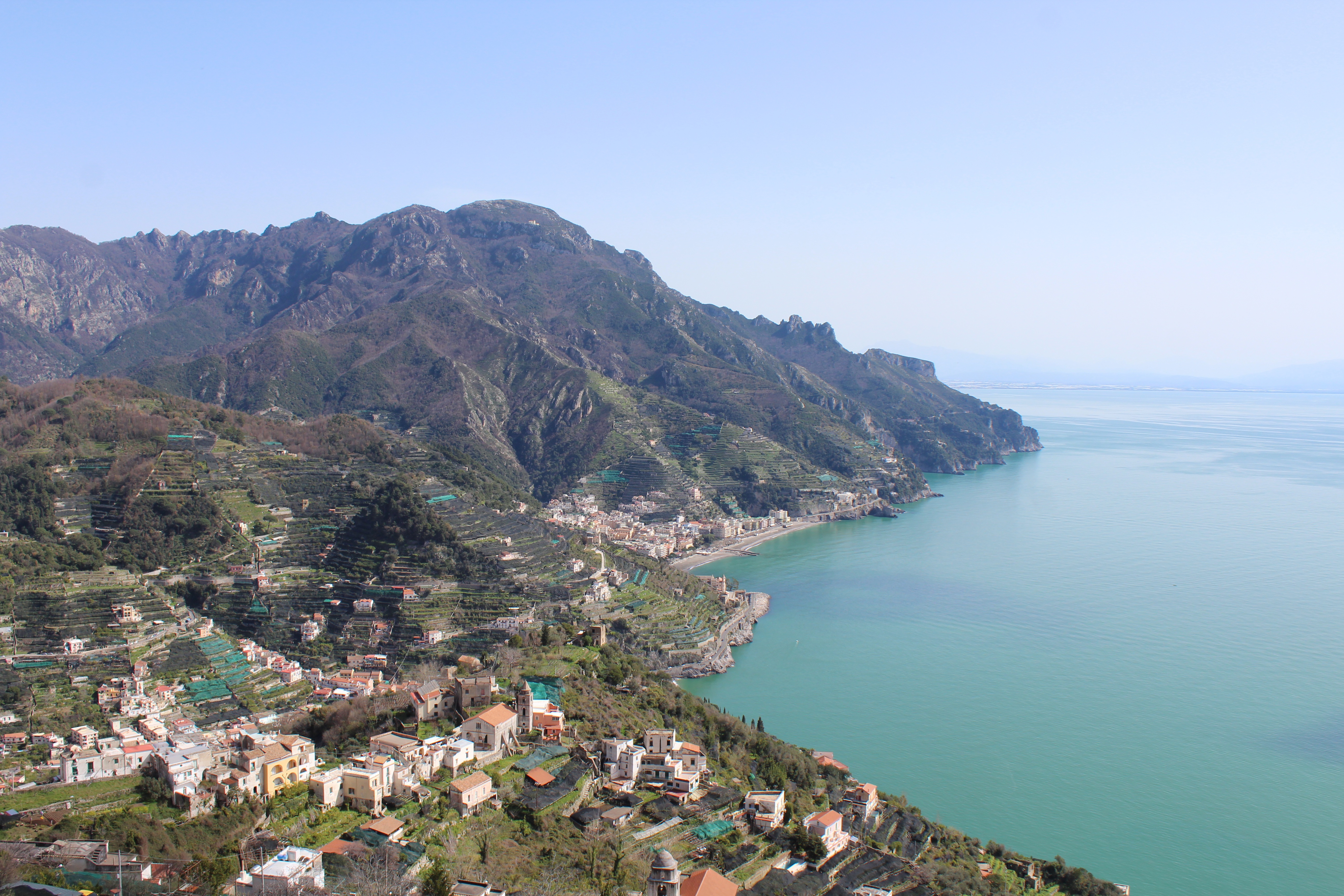
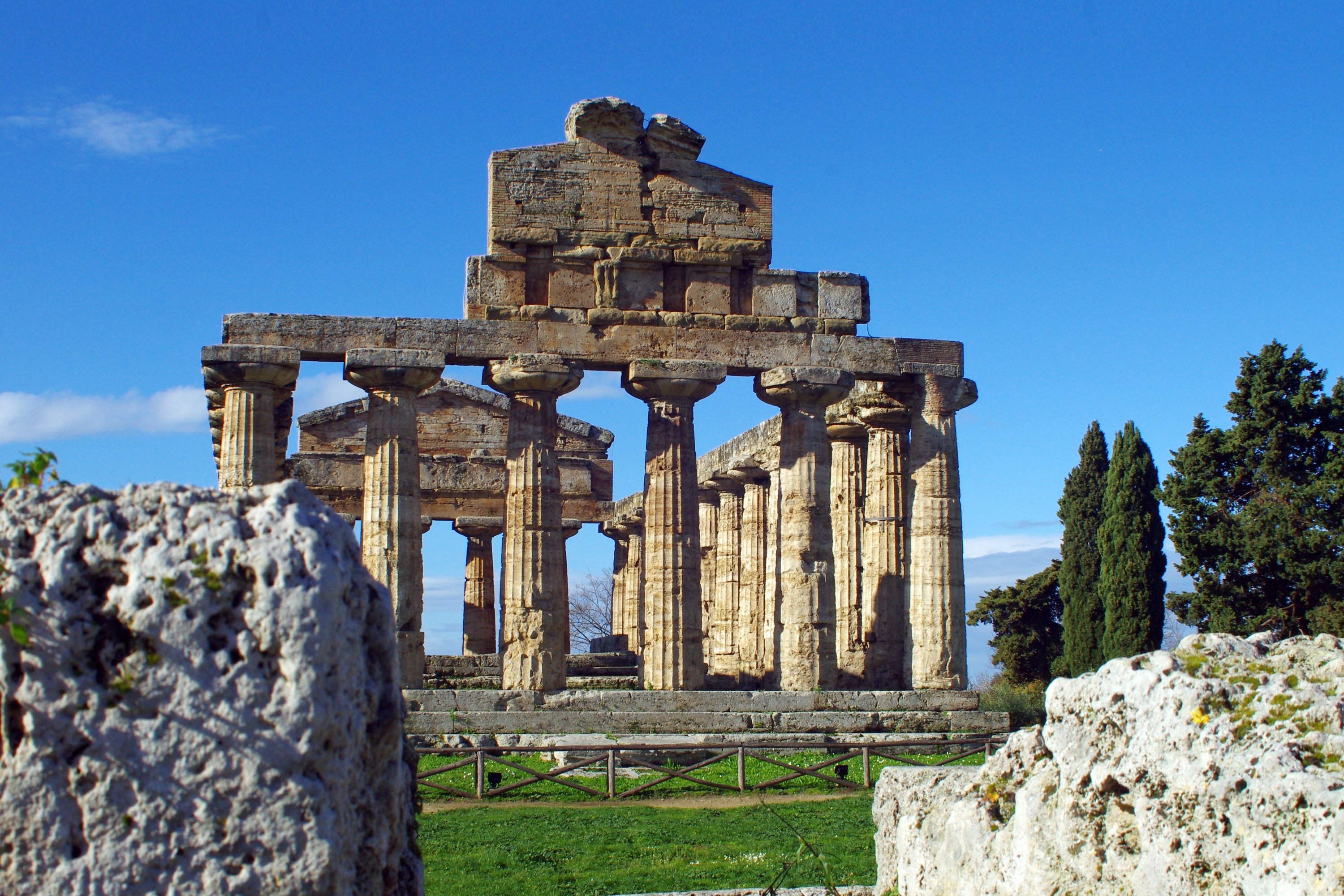
About Civitavecchia
Italy's vibrant capital lives in the present, but no other city on earth evokes its past so powerfully. For over 2,500 years, emperors, popes, artists, and common citizens have left their mark here. Archaeological remains from ancient Rome, art-stuffed churches, and the treasures of Vatican City vie for your attention, but Rome is also a wonderful place to practice the Italian-perfected il dolce far niente, the sweet art of idleness. Your most memorable experiences may include sitting at a caffè in the Campo de' Fiori or strolling in a beguiling piazza.



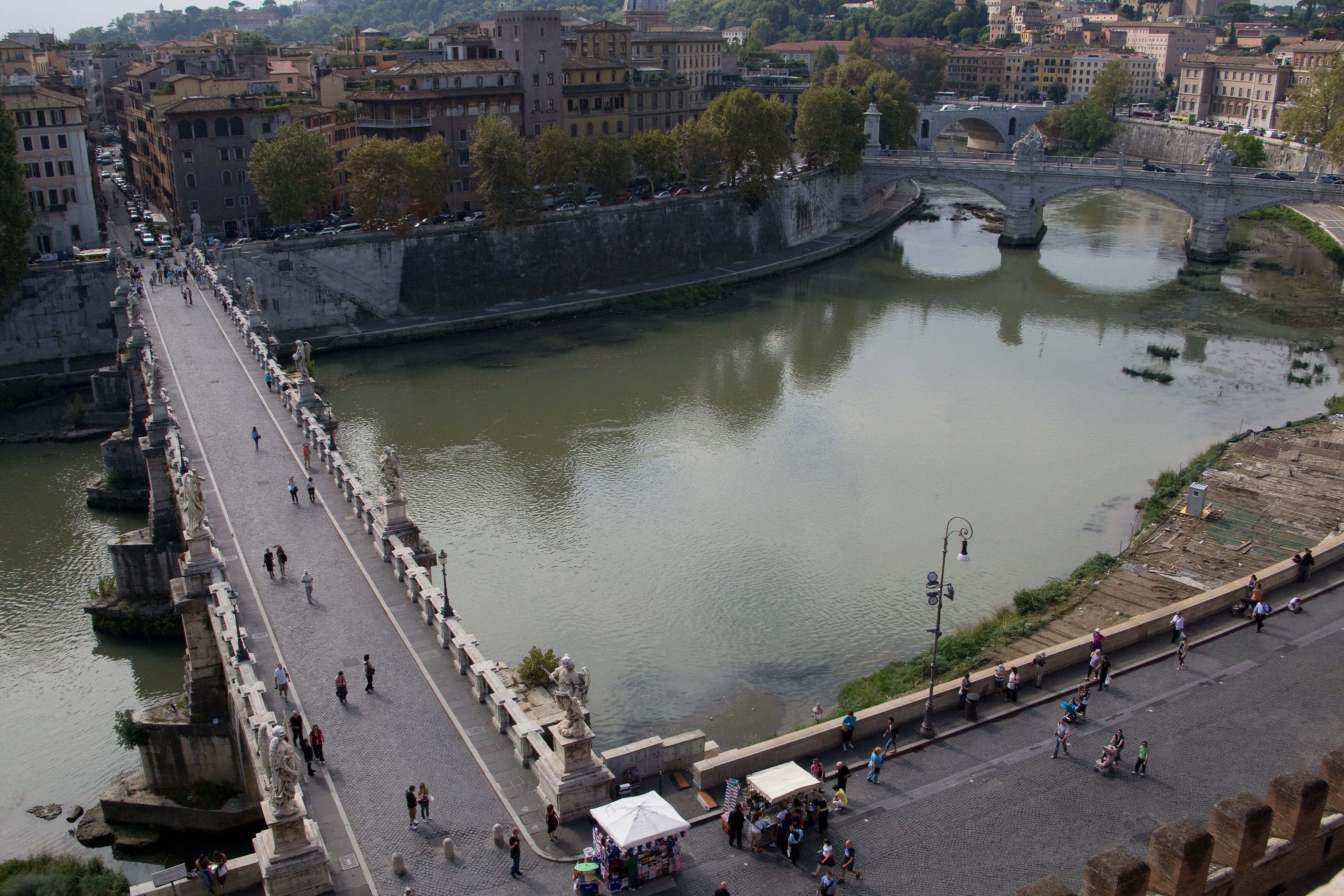
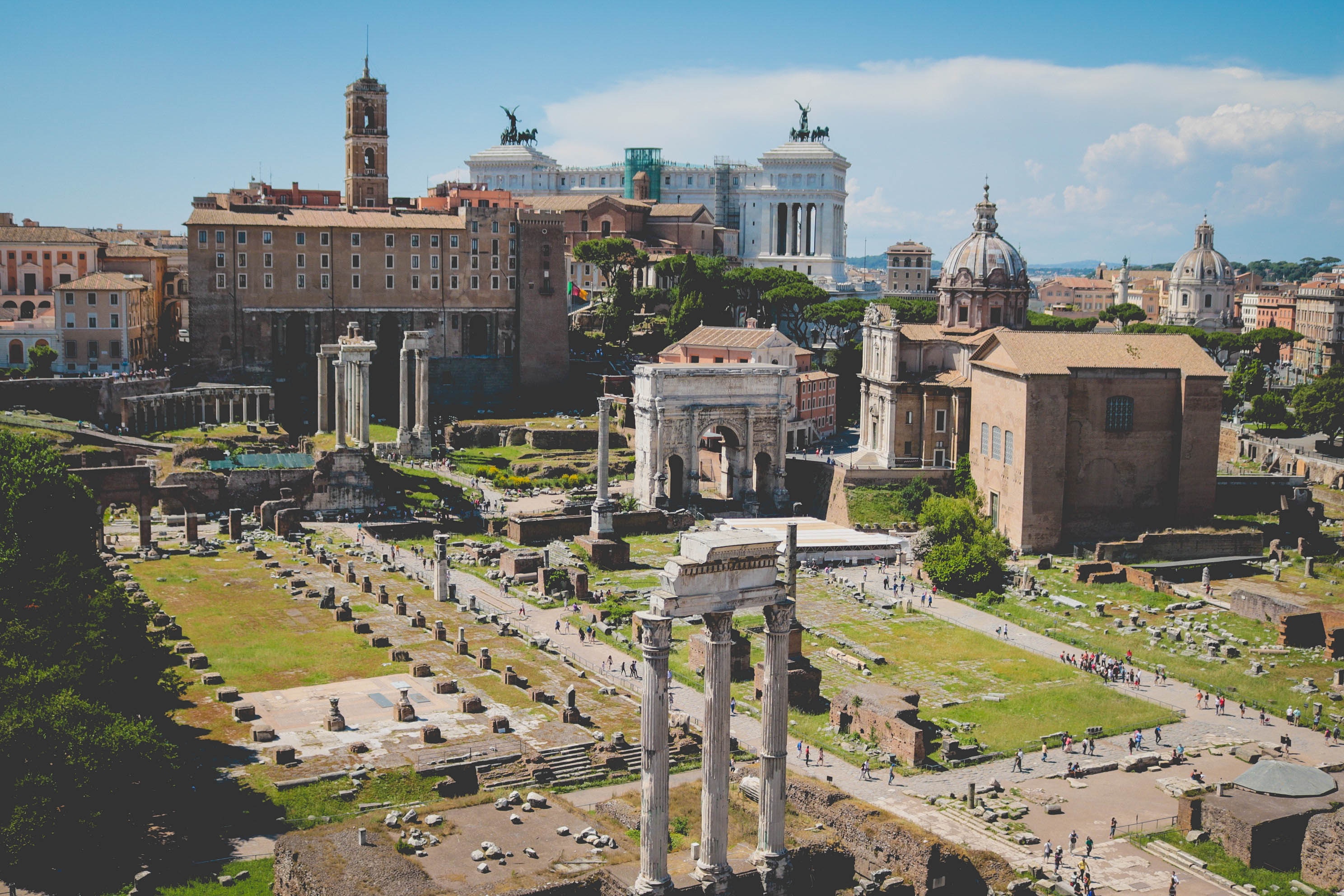
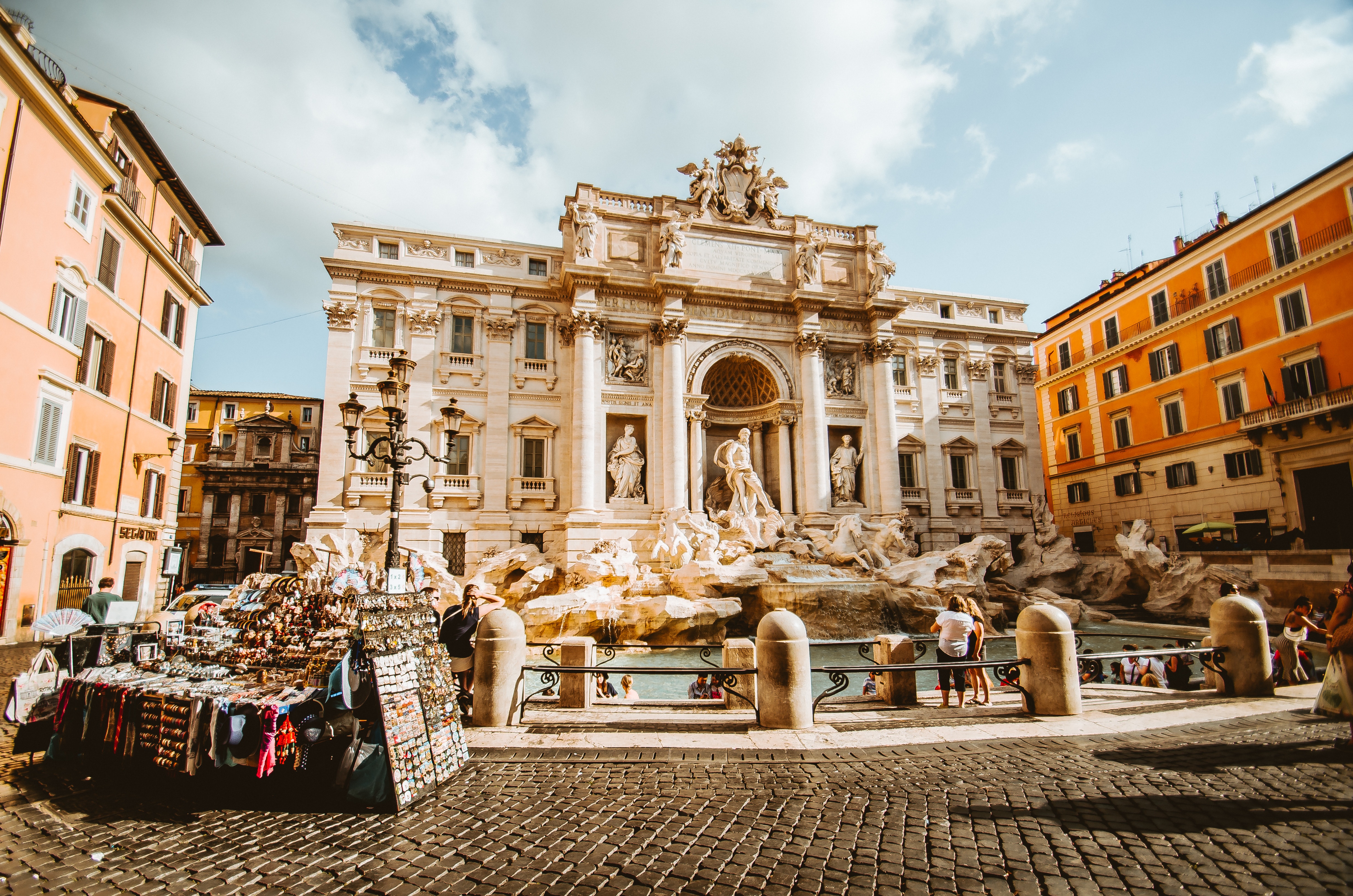


About Messina Strait

About Cephalonia
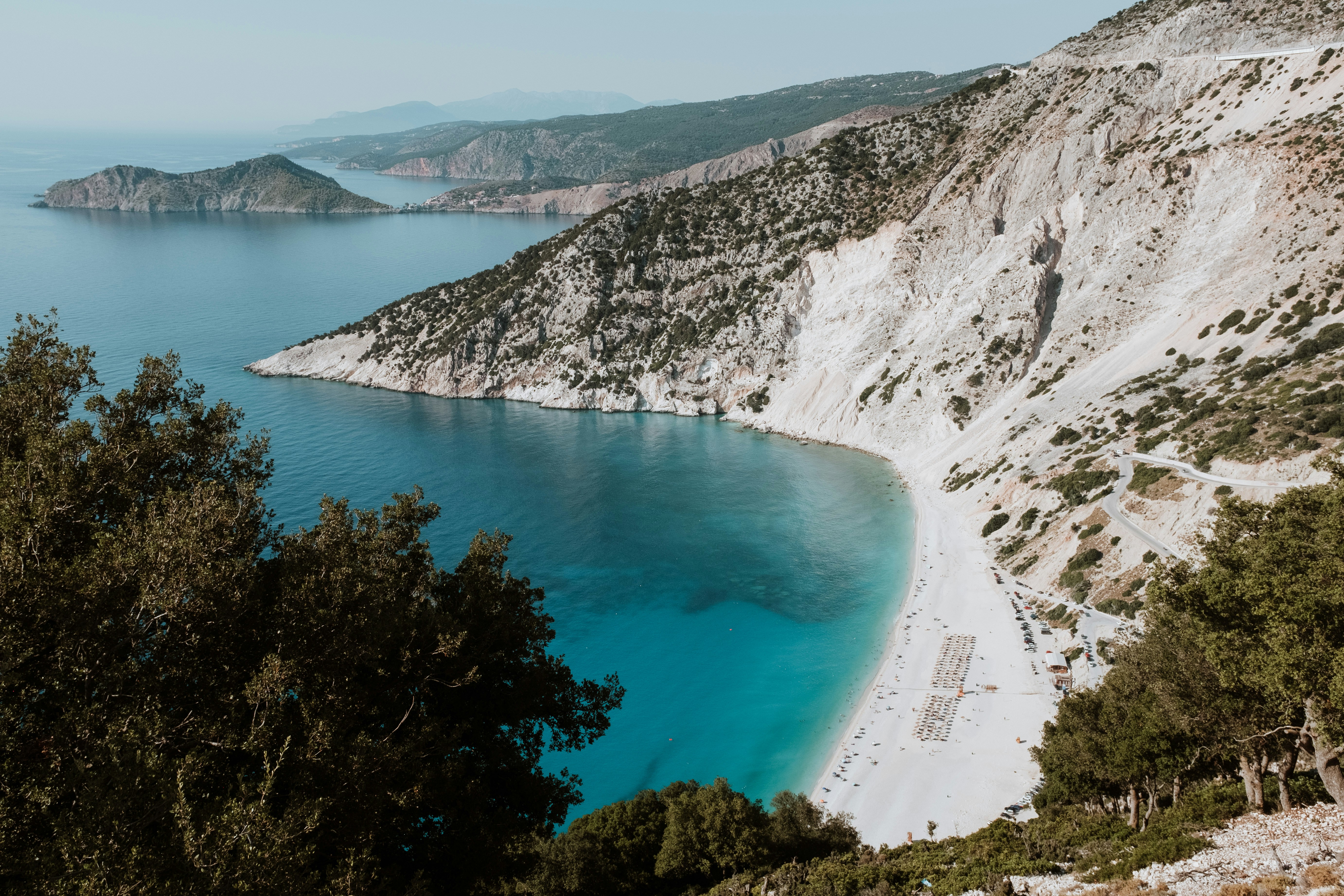
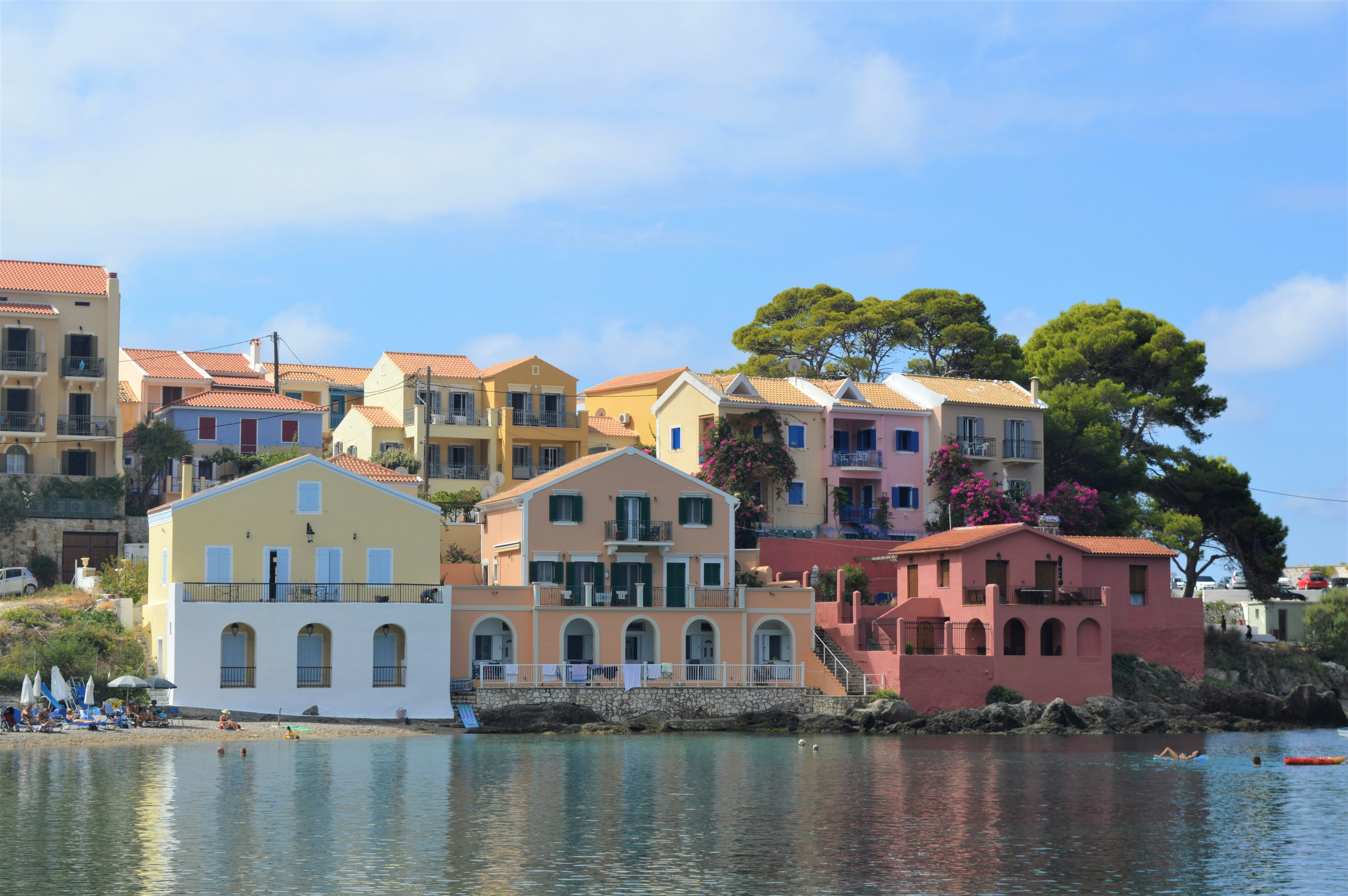
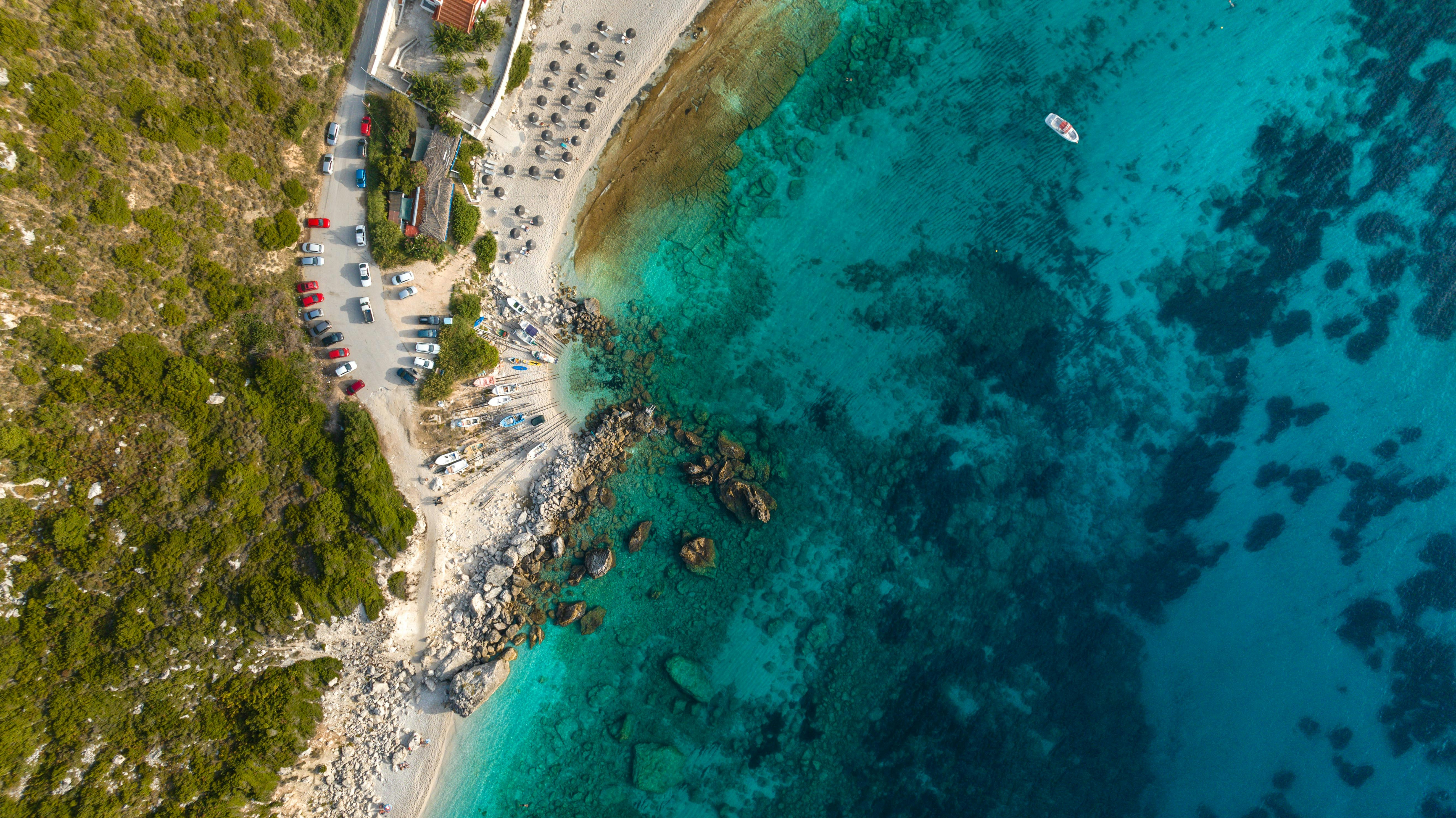
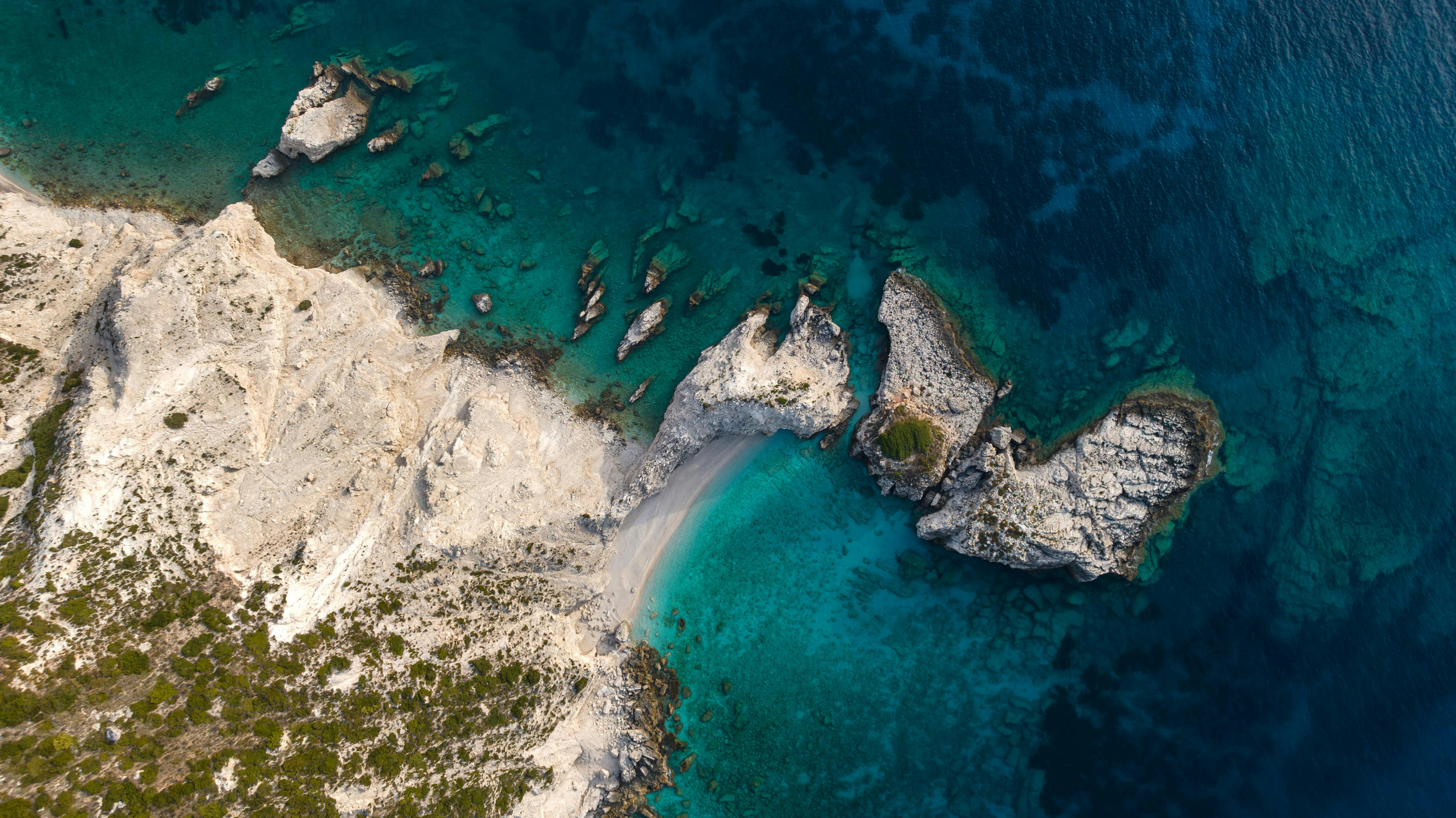
About Corfu
Corfu town today is a vivid tapestry of cultures—a sophisticated weave, where charm, history, and natural beauty blend. Located about midway along the island's east coast, this spectacularly lively capital is the cultural heart of Corfu and has a remarkable historic center that UNESCO designated as a World Heritage Site in 2007. All ships and planes dock or land near Corfu town, which occupies a small peninsula jutting into the Ionian Sea.Whether arriving by ferry from mainland Greece or Italy, from another island, or directly by plane, catch your breath by first relaxing with a coffee or a gelato in Corfu town's shaded Liston Arcade, then stroll the narrow lanes of its pedestrians-only quarter. For an overview of the immediate area, and a quick tour of Mon Repos palace, hop on the little tourist train that runs from May to September. Corfu town has a different feel at night, so book a table at one of its famed tavernas to savor the island's unique cuisine.The best way to get around Corfu town is on foot. The town is small enough so that you can easily walk to every sight. There are local buses, but they do not thread their way into the streets (many now car-free) of the historic center. If you are arriving by ferry or plane, it's best to take a taxi to your hotel. Expect to pay about €10 from the airport or ferry terminal to a hotel in Corfu town. If there are no taxis waiting, you can call for one.
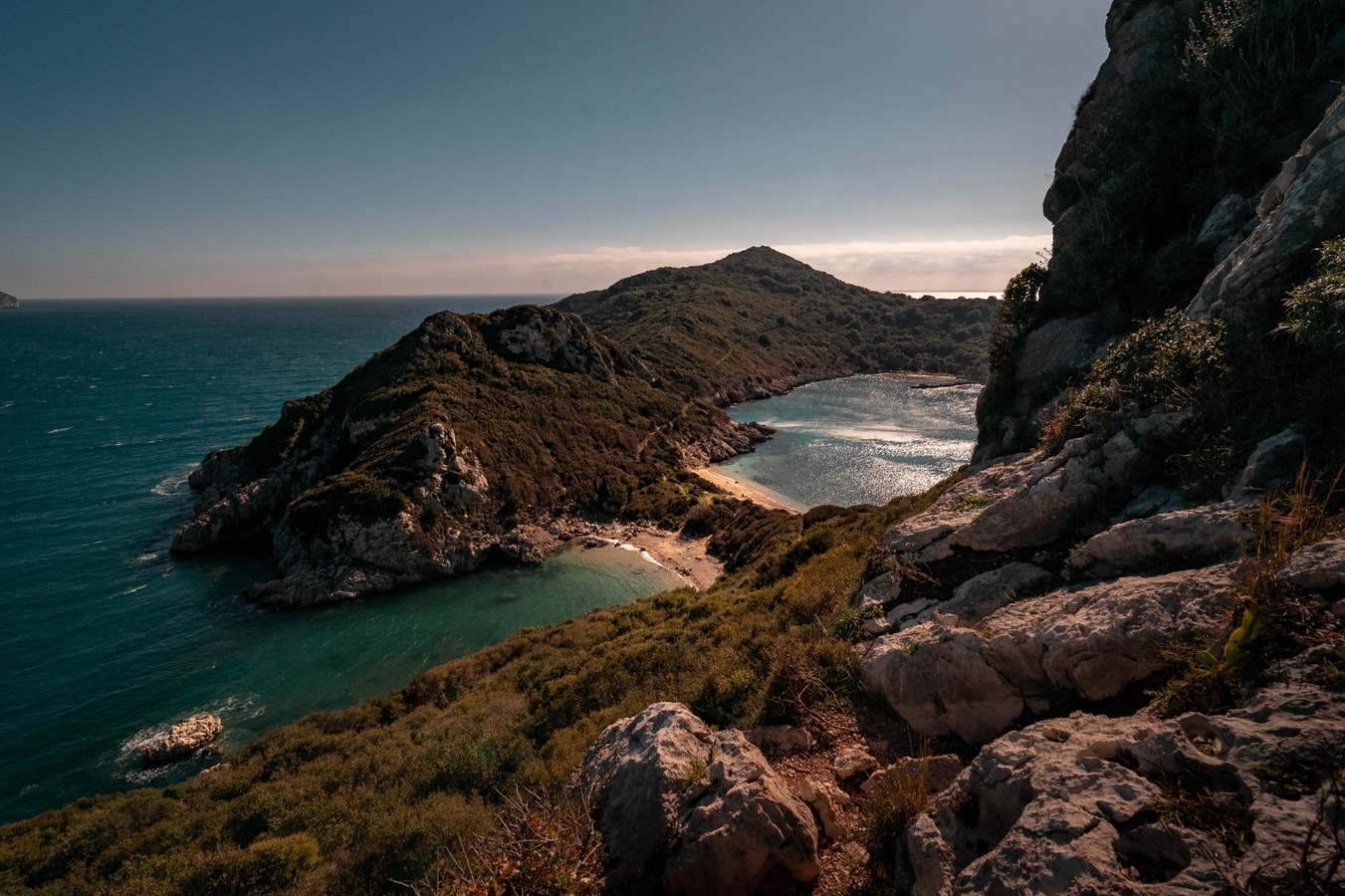
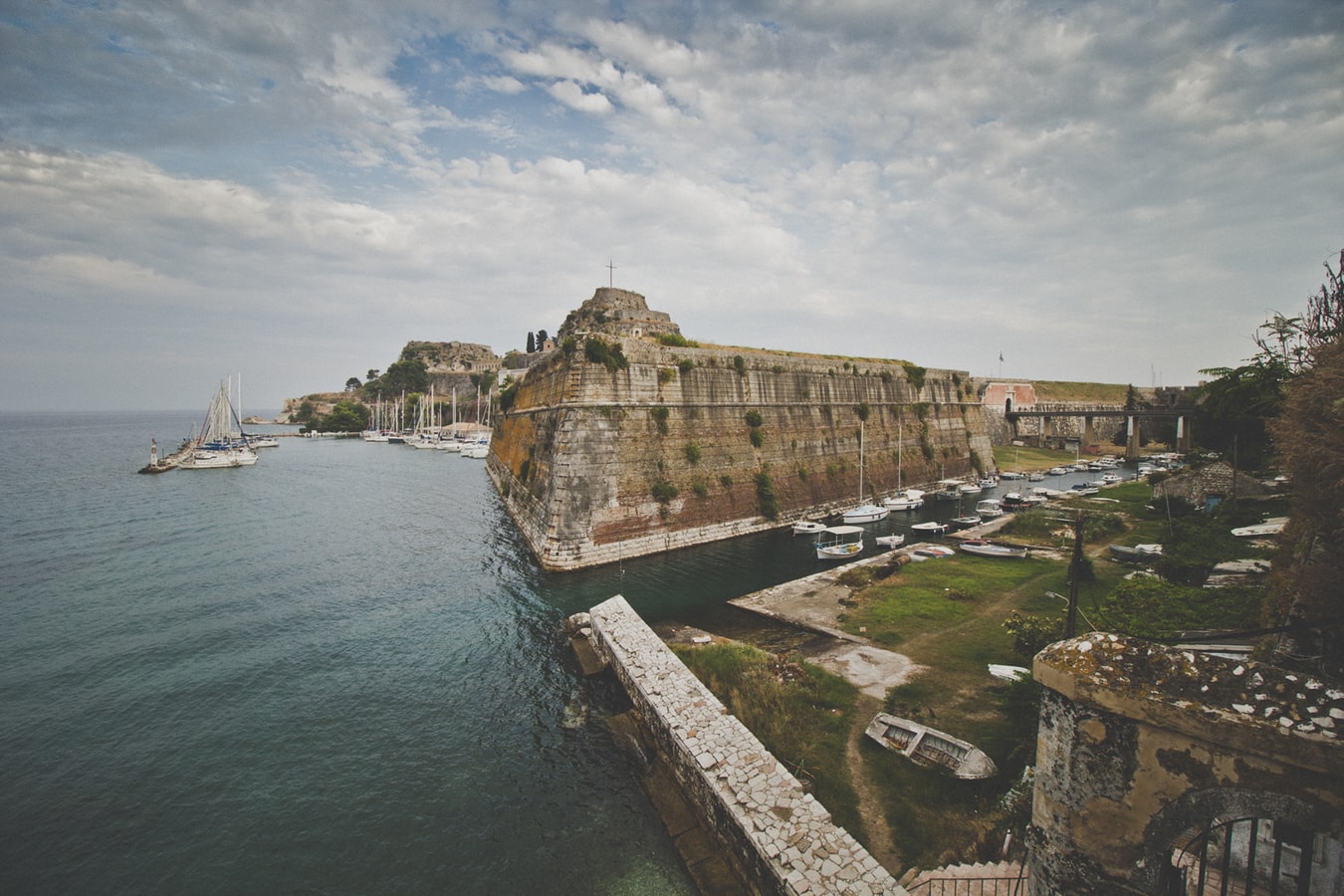
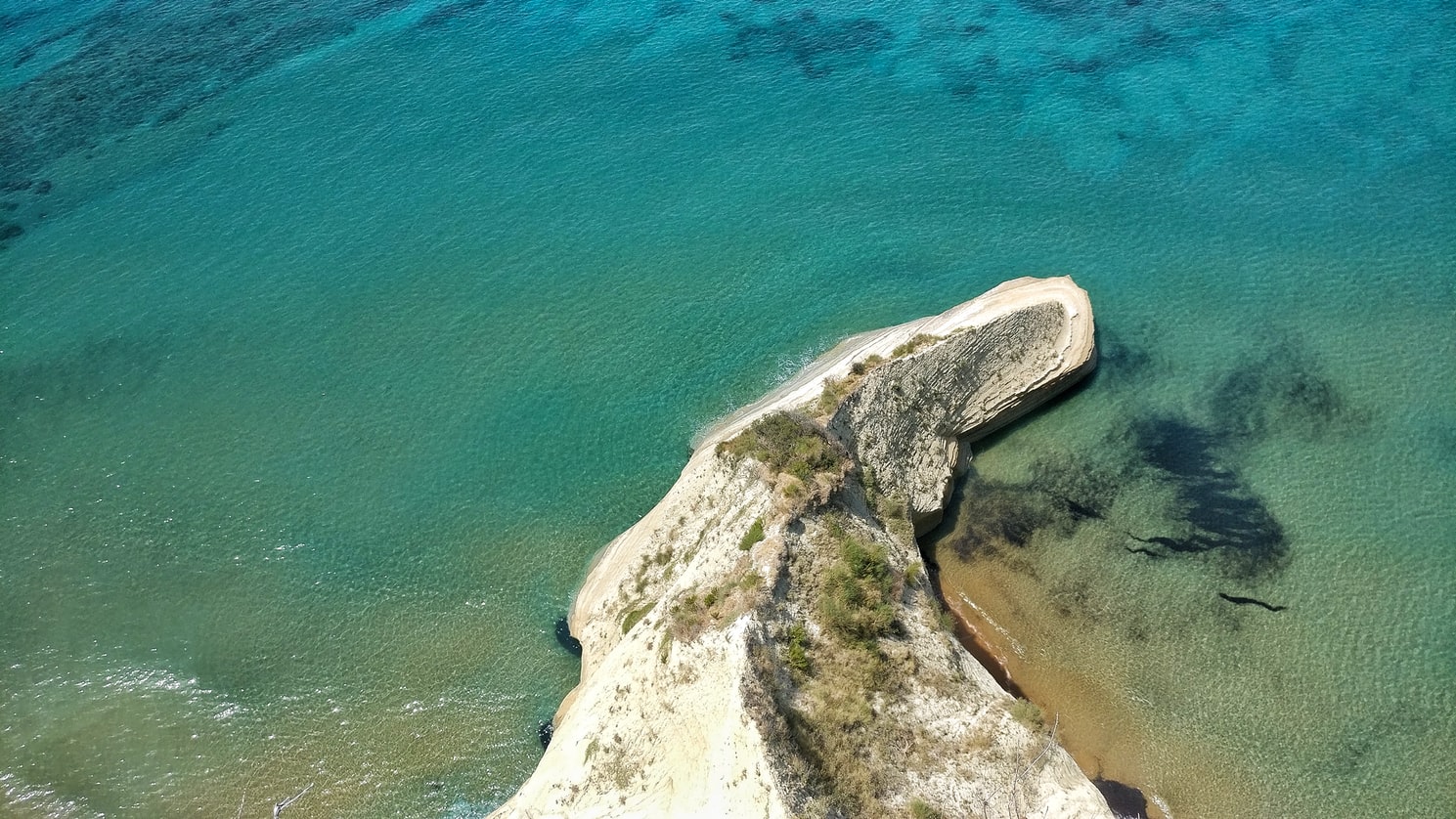
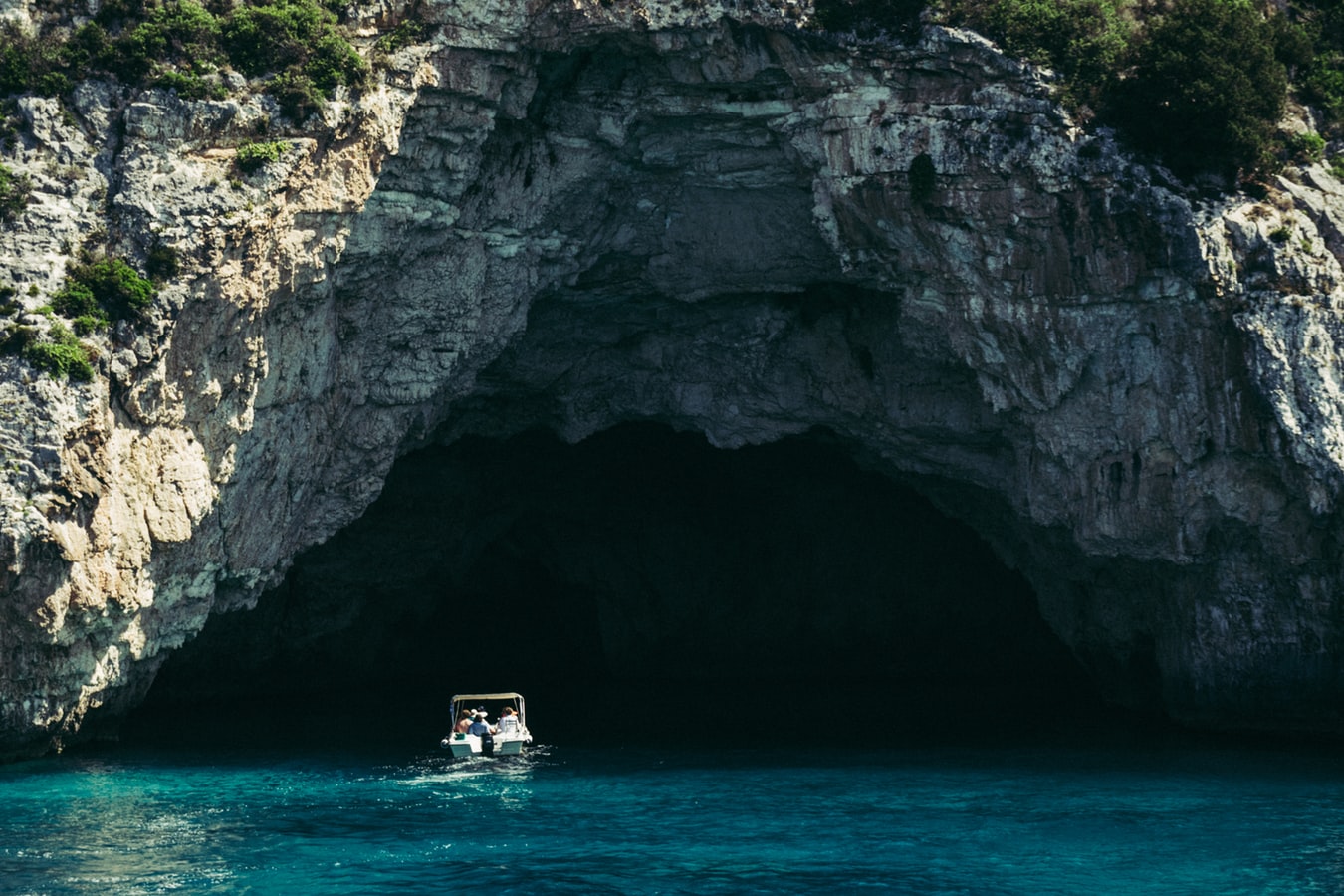
About Kotor
Backed by imposing mountains, tiny Kotor lies hidden from the open sea, tucked into the deepest channel of the Bokor Kotorska (Kotor Bay), which is Europe's most southerly fjord. To many, this town is more charming than its sister UNESCO World Heritage Site, Dubrovnik, retaining more authenticity, but with fewer tourists and spared the war damage and subsequent rebuilding which has given Dubrovnik something of a Disney feel.Kotor's medieval Stari Grad (Old Town) is enclosed within well-preserved defensive walls built between the 9th and 18th centuries and is presided over by a proud hilltop fortress. Within the walls, a labyrinth of winding cobbled streets leads through a series of splendid paved piazzas, rimmed by centuries-old stone buildings. The squares are now haunted by strains from buskers but although many now house trendy cafés and chic boutiques, directions are still given medieval-style by reference to the town’s landmark churches.In the Middle Ages, as Serbia's chief port, Kotor was an important economic and cultural center with its own highly regarded schools of stonemasonry and iconography. From 1391 to 1420 it was an independent city-republic and later, it spent periods under Venetian, Austrian, and French rule, though it was undoubtedly the Venetians who left the strongest impression on the city's architecture. Since the breakup of Yugoslavia, some 70% of the stone buildings in the romantic Old Town have been snapped up by foreigners, mostly Brits and Russians. Porto Montenegro, a new marina designed to accommodate some of the world’s largest super yachts, opened in nearby Tivat in 2011, and along the bay are other charming seaside villages, all with better views of the bay than the vista from Kotor itself where the waterside is congested with cruise ships and yachts. Try sleepy Muo or the settlement of Prčanj in one direction around the bay, or Perast and the Roman mosaics of Risan in the other direction.
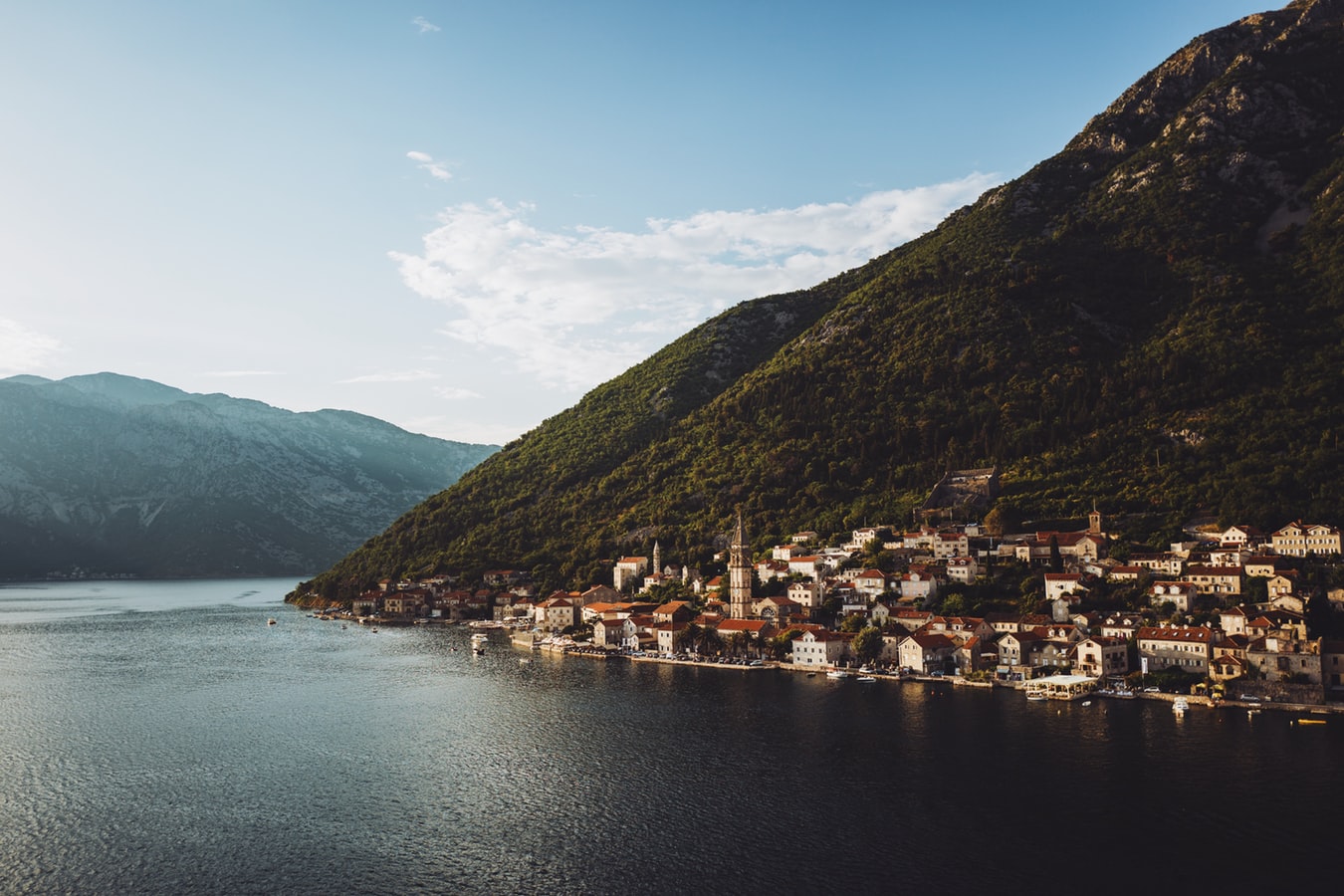
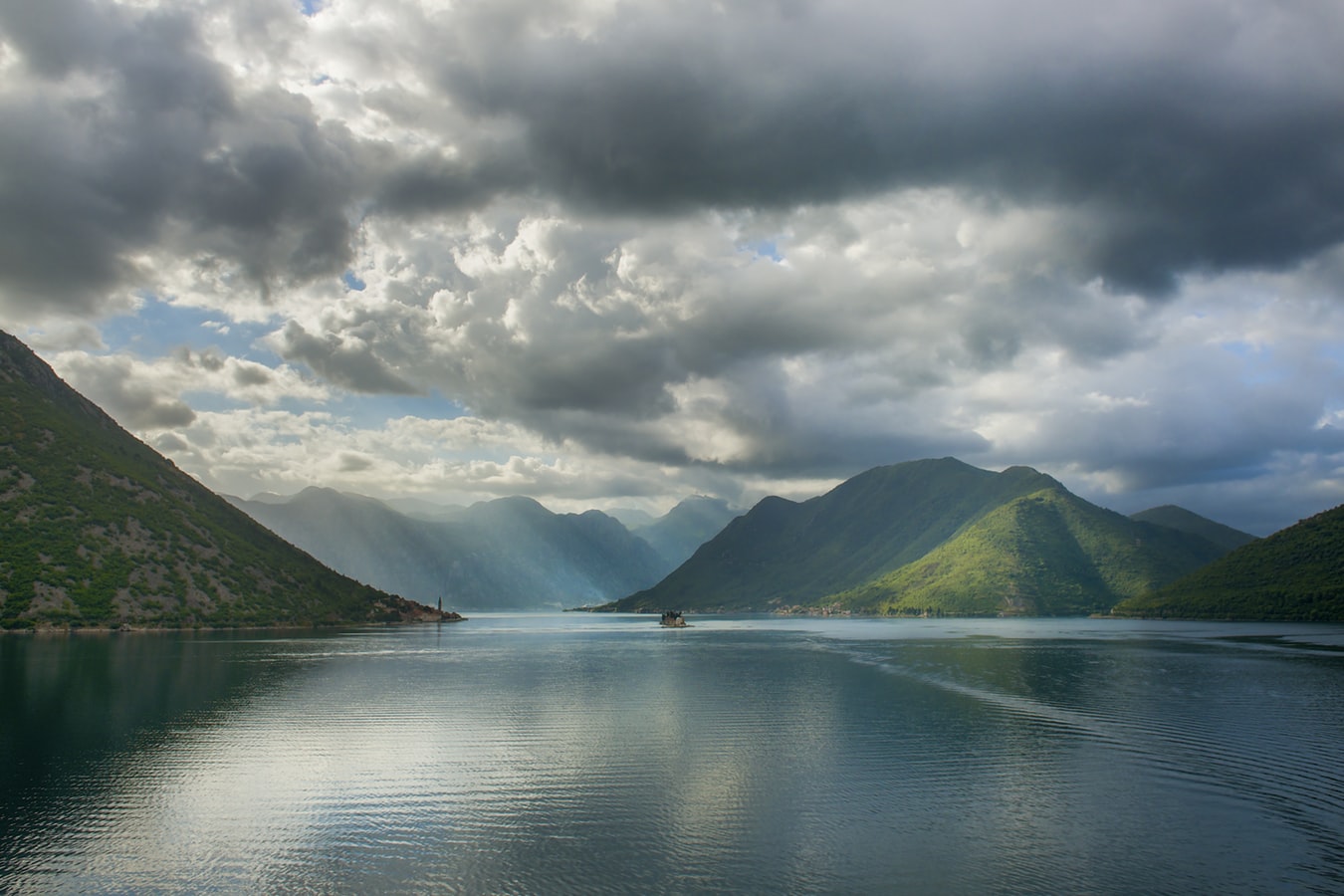
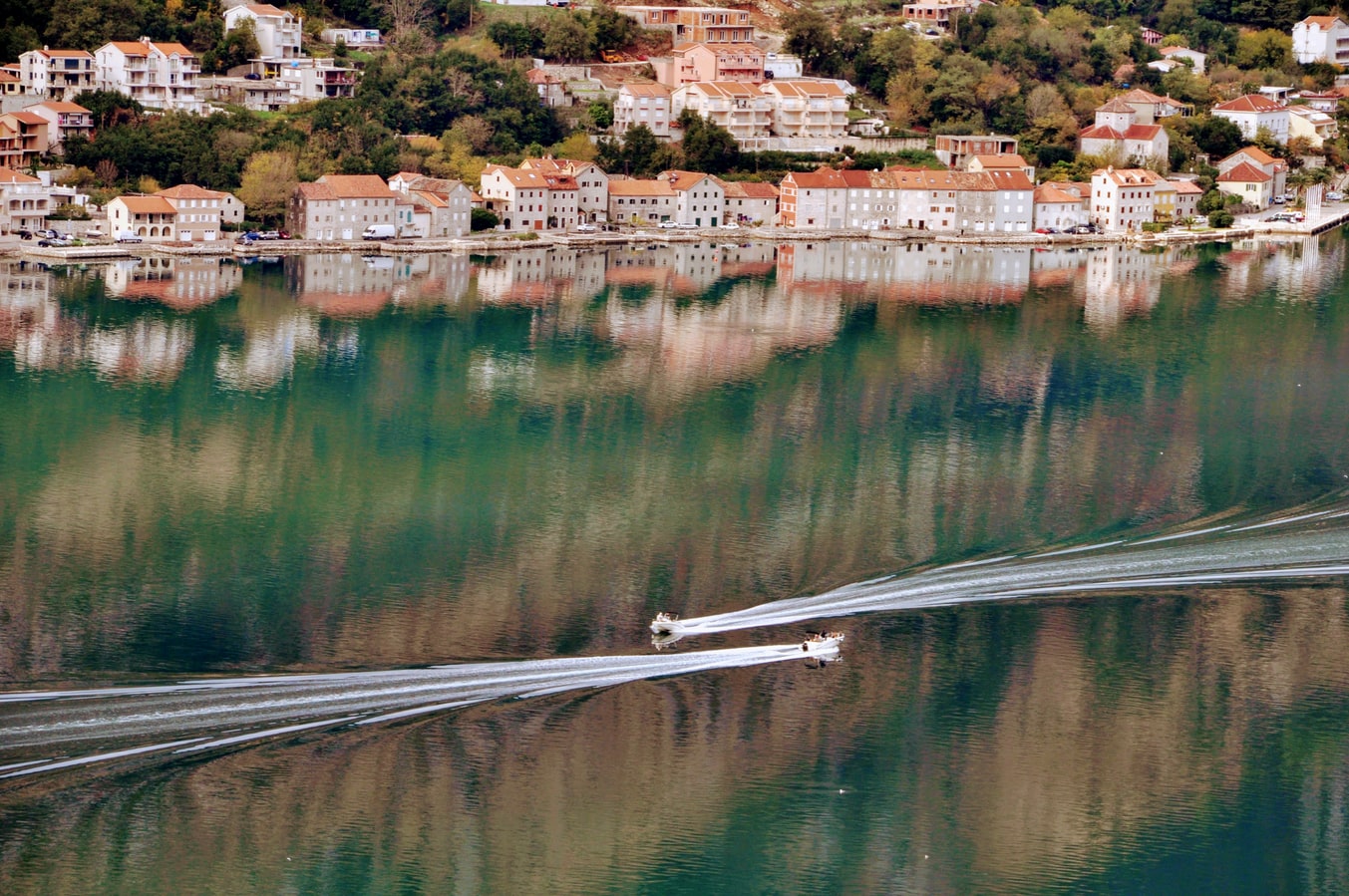
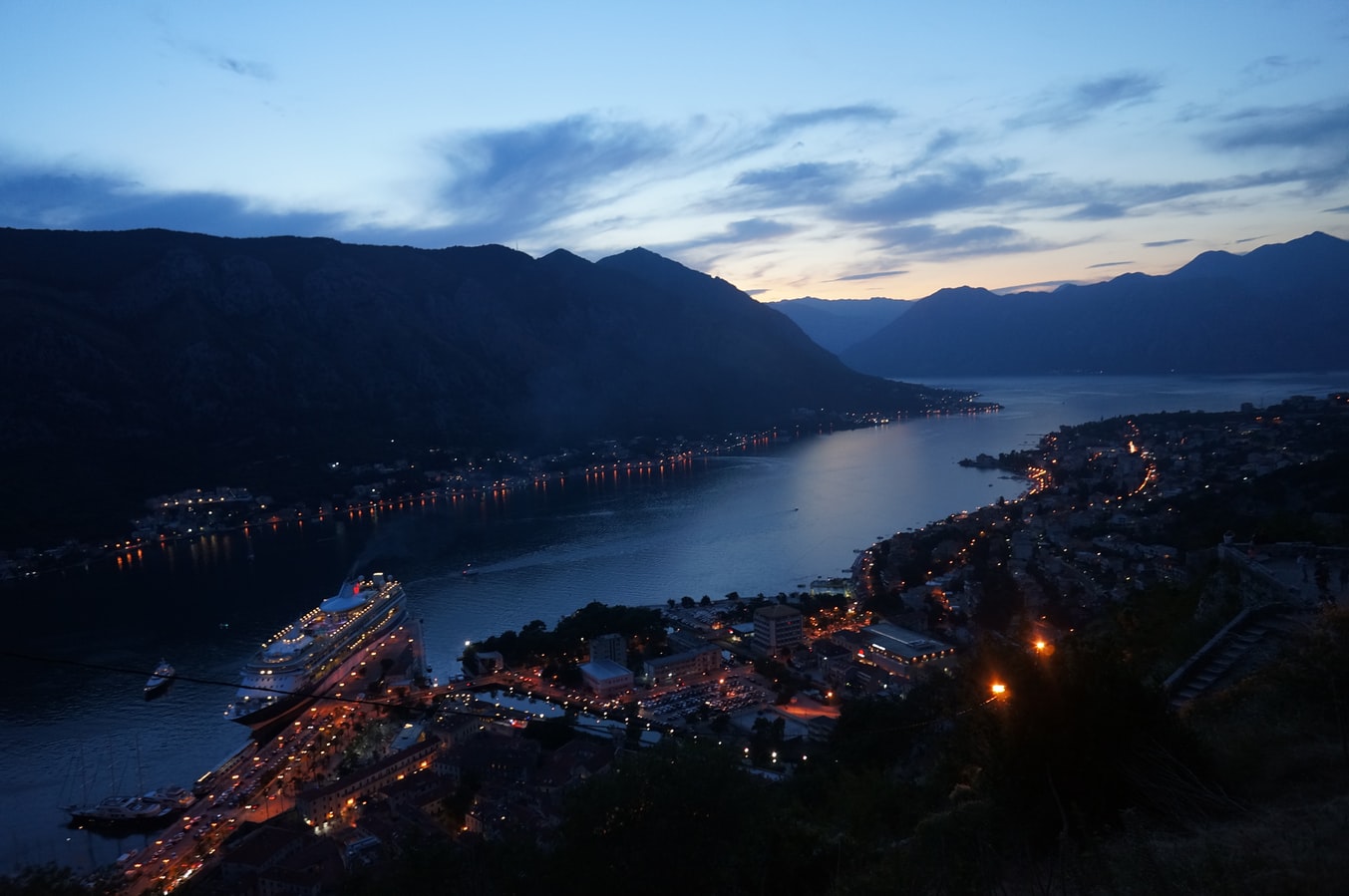
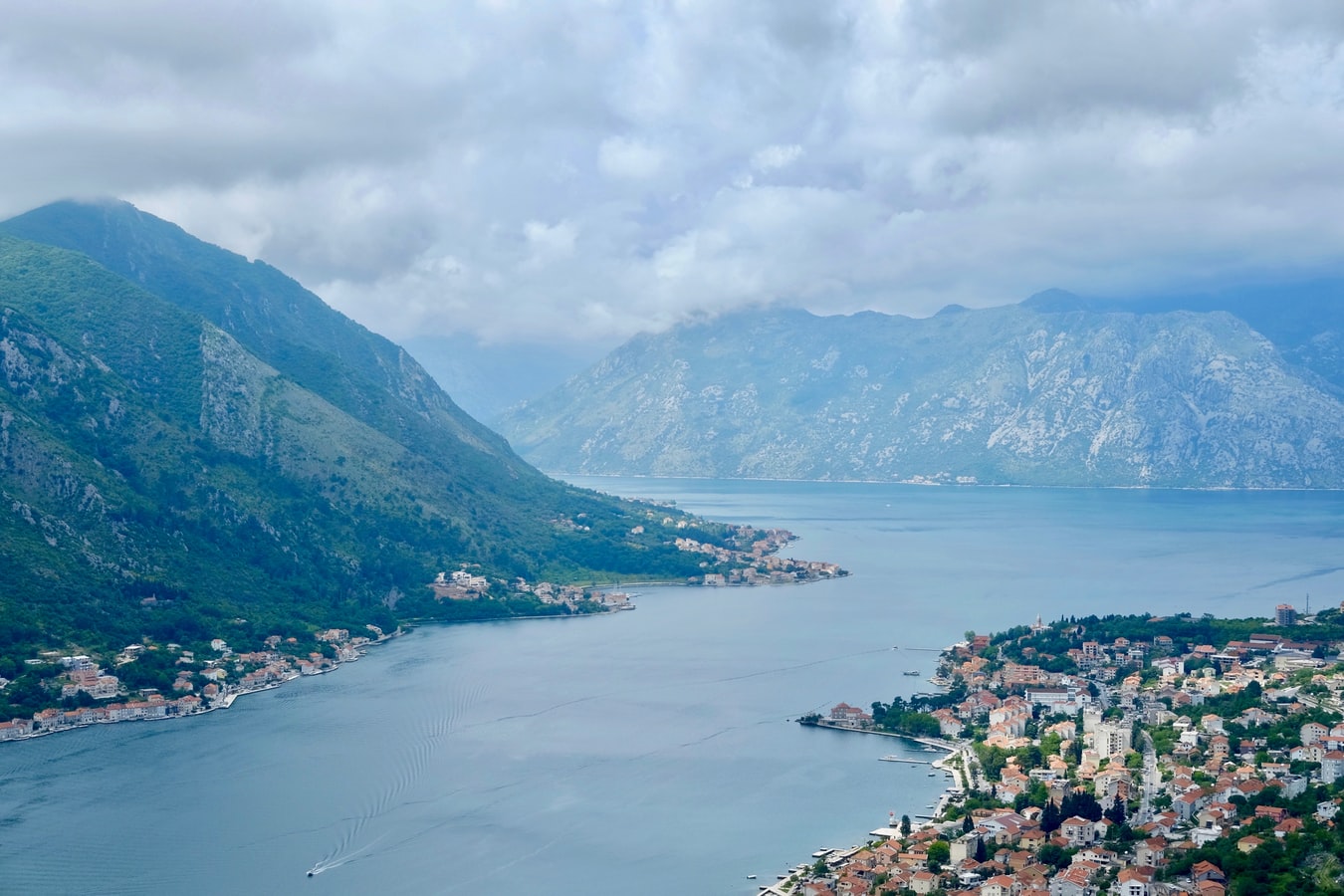
About Split
Split's ancient core is so spectacular and unusual that a visit is more than worth your time. The heart of the city lies within the walls of Roman emperor Diocletian's retirement palace, which was built in the 3rd century AD. Diocletian, born in the nearby Roman settlement of Salona in AD 245, achieved a brilliant career as a soldier and became emperor at the age of 40. In 295 he ordered this vast palace to be built in his native Dalmatia, and when it was completed he stepped down from the throne and retired to his beloved homeland. Upon his death, he was laid to rest in an octagonal mausoleum, around which Split's magnificent cathedral was built.In 615, when Salona was sacked by barbarian tribes, those fortunate enough to escape found refuge within the stout palace walls and divided up the vast imperial apartments into more modest living quarters. Thus, the palace developed into an urban center, and by the 11th century the settlement had expanded beyond the ancient walls.Under the rule of Venice (1420–1797), Split—as a gateway to the Balkan interior—became one of the Adriatic's main trading ports, and the city's splendid Renaissance palaces bear witness to the affluence of those times. When the Habsburgs took control during the 19th century, an overland connection to Central Europe was established by the construction of the Split–Zagreb–Vienna railway line.After World War II, the Tito years saw a period of rapid urban expansion: industrialization accelerated and the suburbs extended to accommodate high-rise apartment blocks. Today the historic center of Split is included on UNESCO's list of World Heritage Sites.

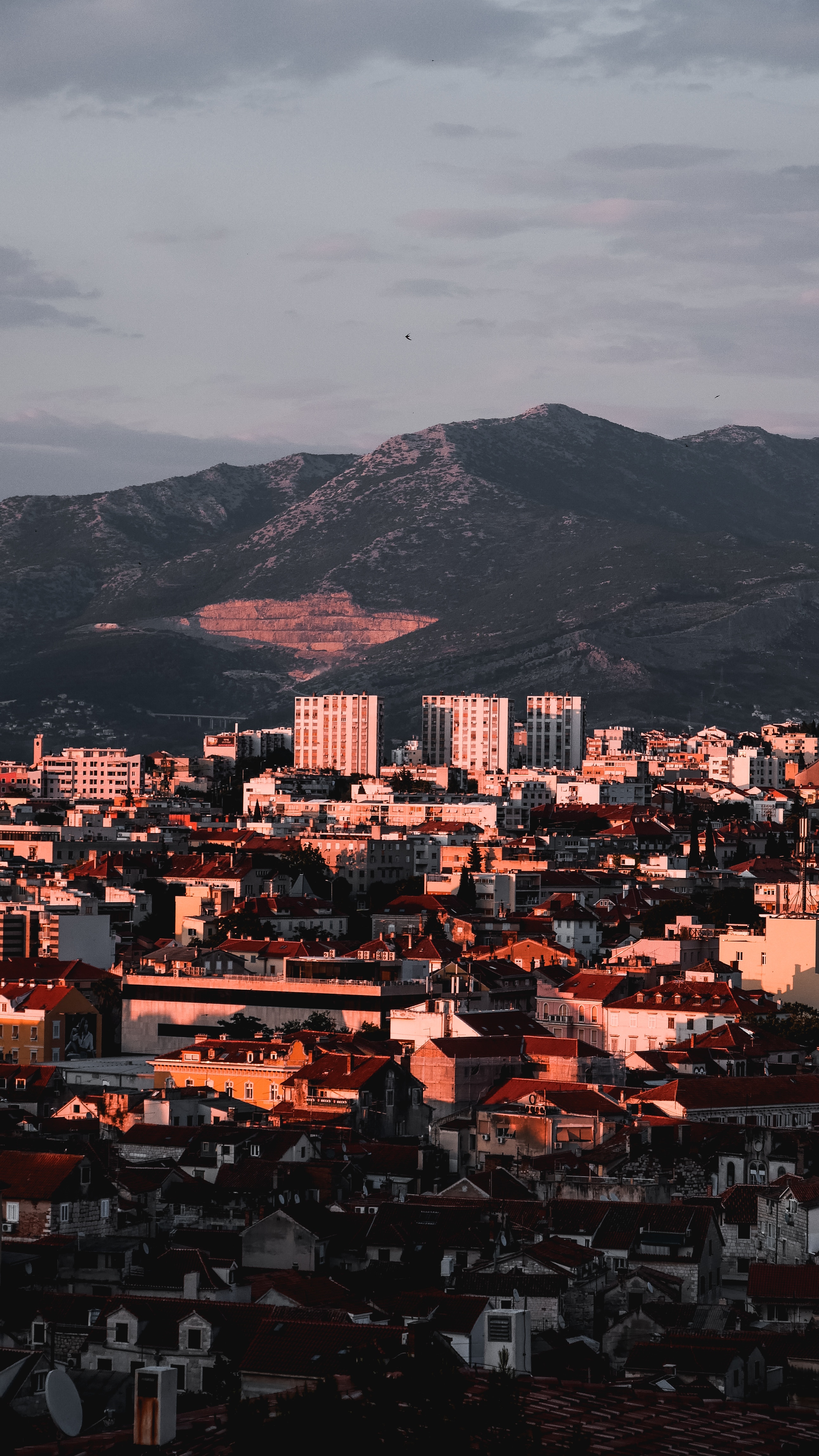
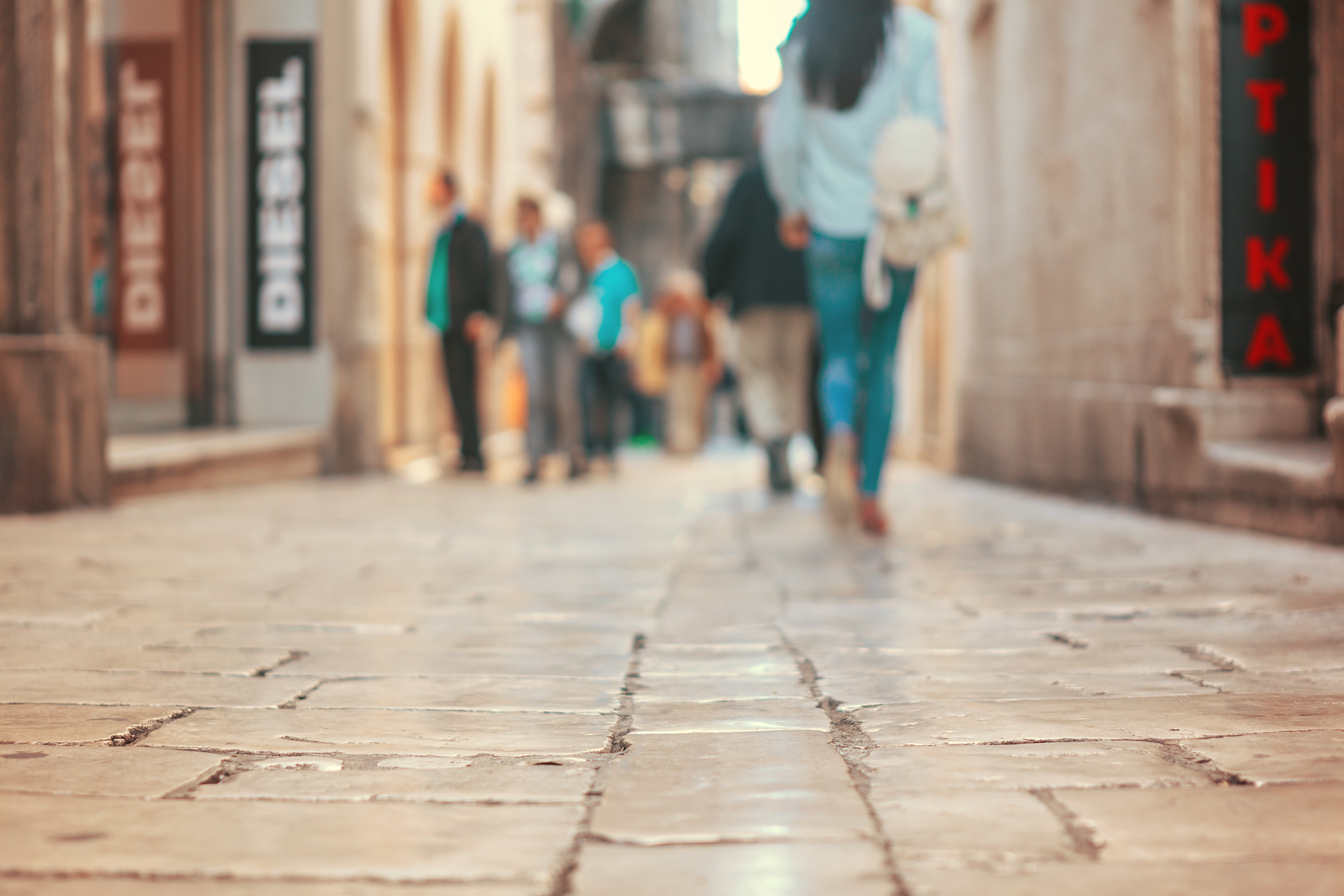
About Trieste
Up until the end of World War I, Trieste was the only port of the vast Austro-Hungarian Empire and therefore a major industrial and financial center. In the early years of the 20th century, Trieste and its surroundings also became famous by their association with some of the most important names of Italian literature, such as Italo Svevo, and English and German letters. James Joyce drew inspiration from the city's multiethnic population, and Rainer Maria Rilke was inspired by the seacoast west of the city. Although it has lost its importance as a port and a center of finance, it has never fully lost its roll as an intellectual center. The streets hold a mix of monumental, neoclassical, and art-nouveau architecture built by the Austrians during Trieste's days of glory, granting an air of melancholy stateliness to a city that lives as much in the past as the present.
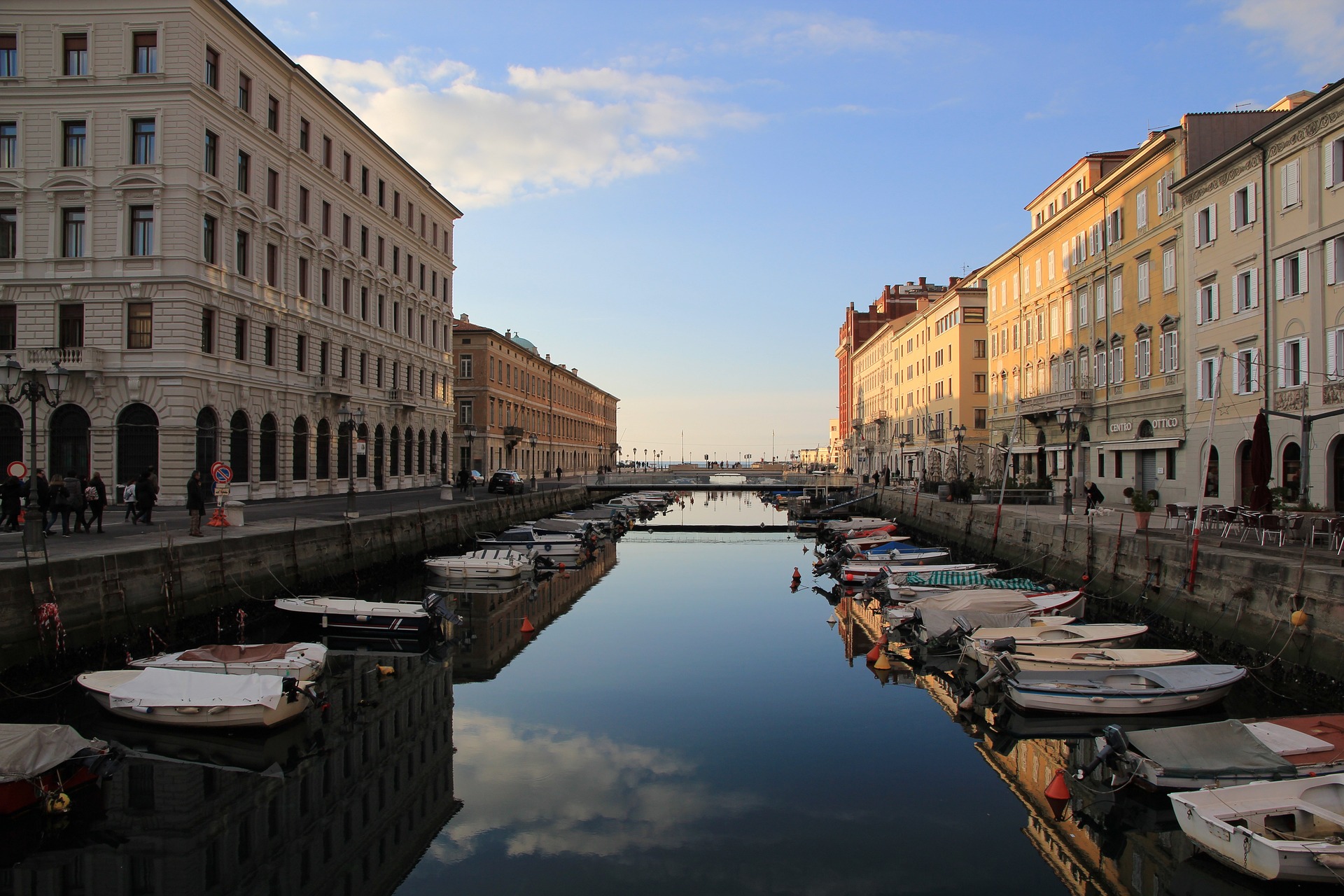
Approximately 1319-1555 sq. ft.
Retreat to an exclusive world of luxury with your own private residence at sea. Striking interior designs bring each space in your suite to life, indulging your senses with a rich tapestry of colours, materials, and art. An attentive butler is on hand at all times to truly customise your voyage experience.
The Queens Grill Grand Suite includes:
- Access to the exclusive Queens Grill restaurant, where you can dine any time at your reserved table.
- Separate room customisable to snug or bedroom.
- Dedicated dining area.
- Spacious lounge area with seating and space to host guests.
- Bedroom area with Cunarder bed configurable to king-size or two single beds.
- Pillow concierge menu with seven pillow types to choose from.
- Twin marble bathrooms and dressing area.
- Spacious private balcony with seating and sea views.
- Satellite TV with movie and music channels in bedroom and lounge areas.
- Feature vanity with hairdryer.
- Workspace with a set of personalised stationery.
- Fresh flowers.
- Binoculars and world atlas to track your travels.
- UK, USA and European power sockets.
- Penhaligon's toiletries.
- Luxury bathrobes and slippers.
- Butler’s pantry.
- Complimentary mini-bar stocked with your choice of beer, wine, spirts and soft drinks.
- Speciality tea and coffee making facilities.
- Daily fresh fruit.
- Pre-dinner canapés.
- Welcome bottle of Champagne.
- Complimentary room service menu.
- Dine in-suite from the exclusive Queens Grill menu.
- Exclusive access to the Grills Lounge and outside Grills Terrace.
- Concierge service for on board reservations and shore experiences.
- A dedicated butler and steward to keep your suite in fine order day and night and host the perfect soirée.
- Priority embarkation and disembarkation.
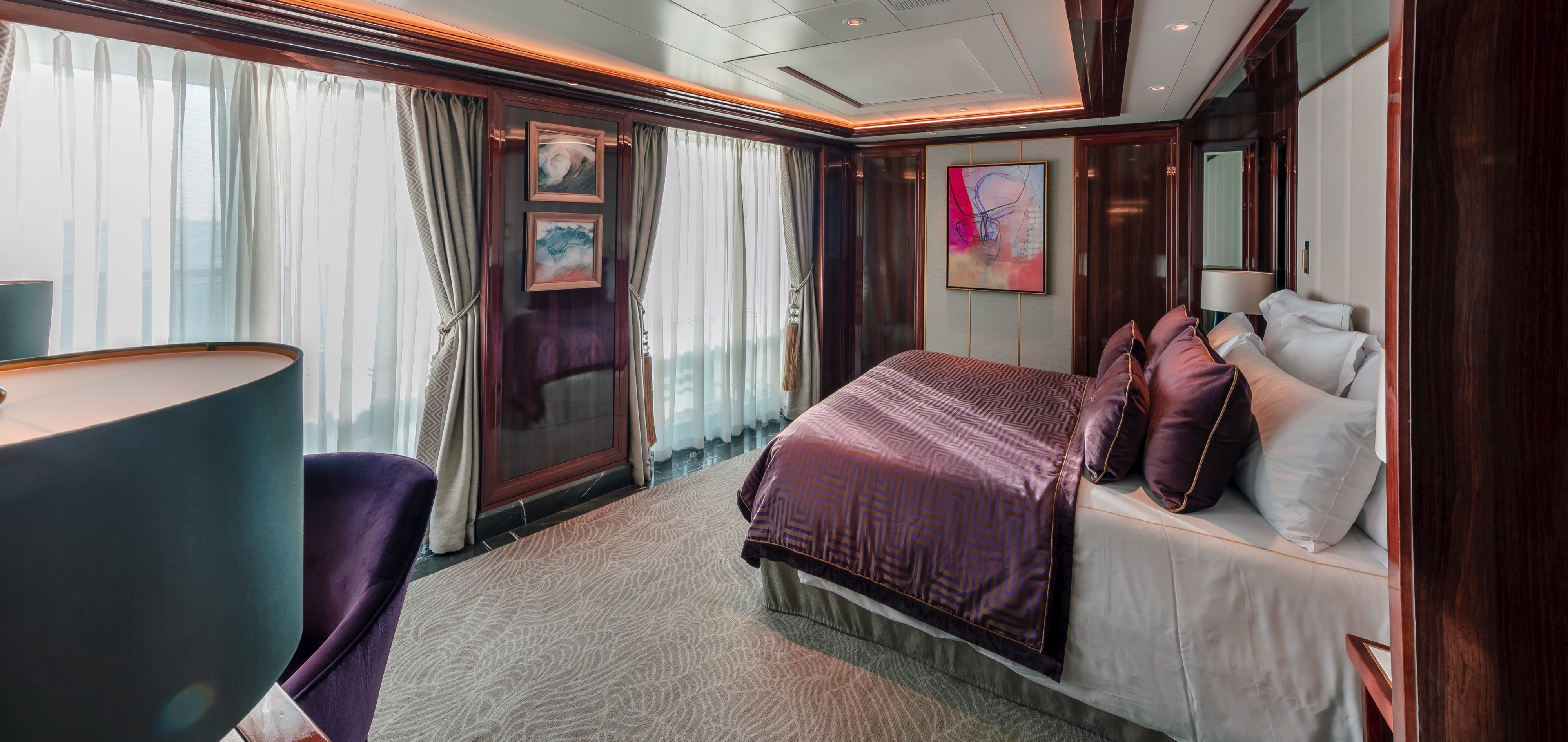
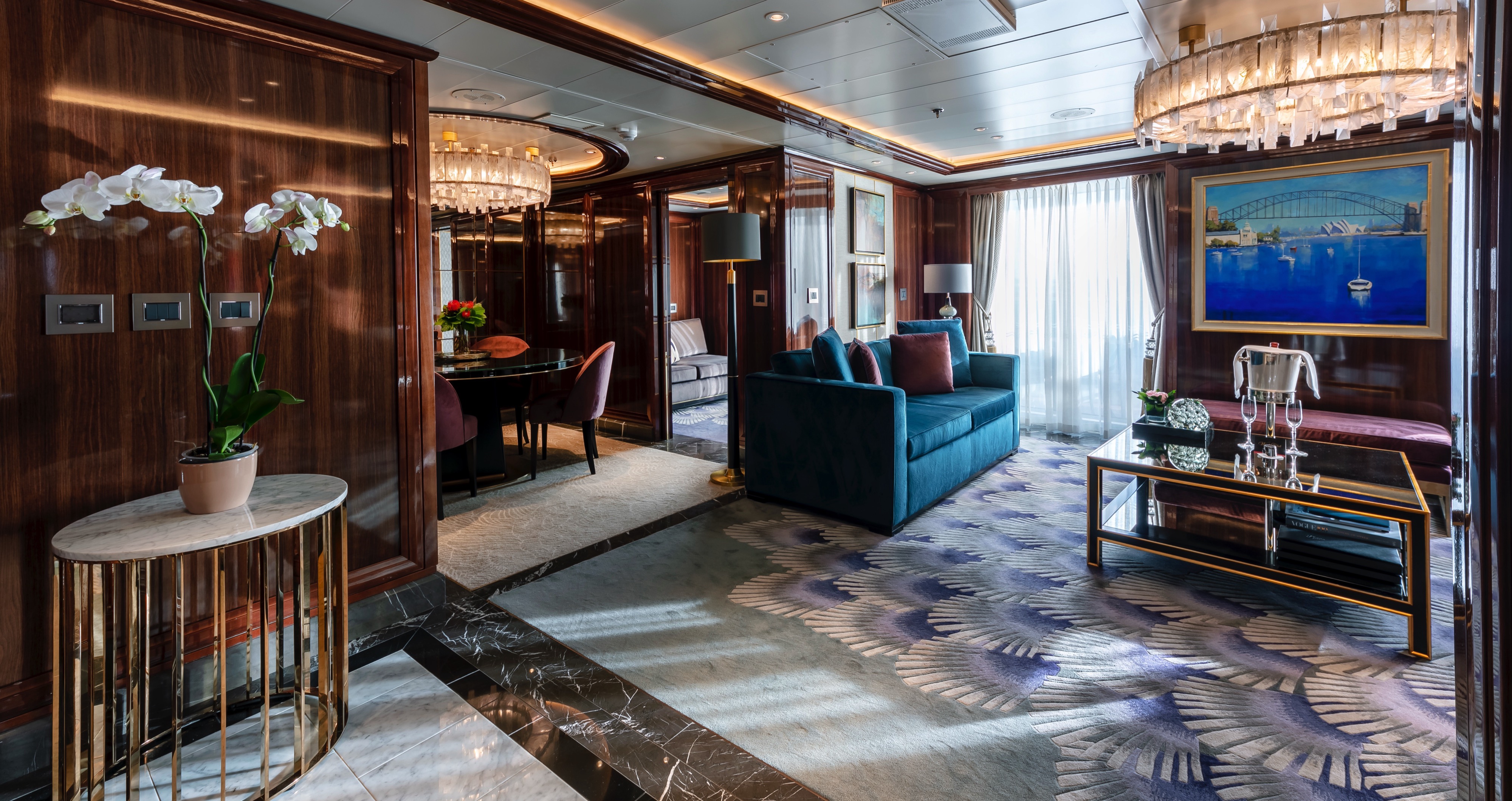
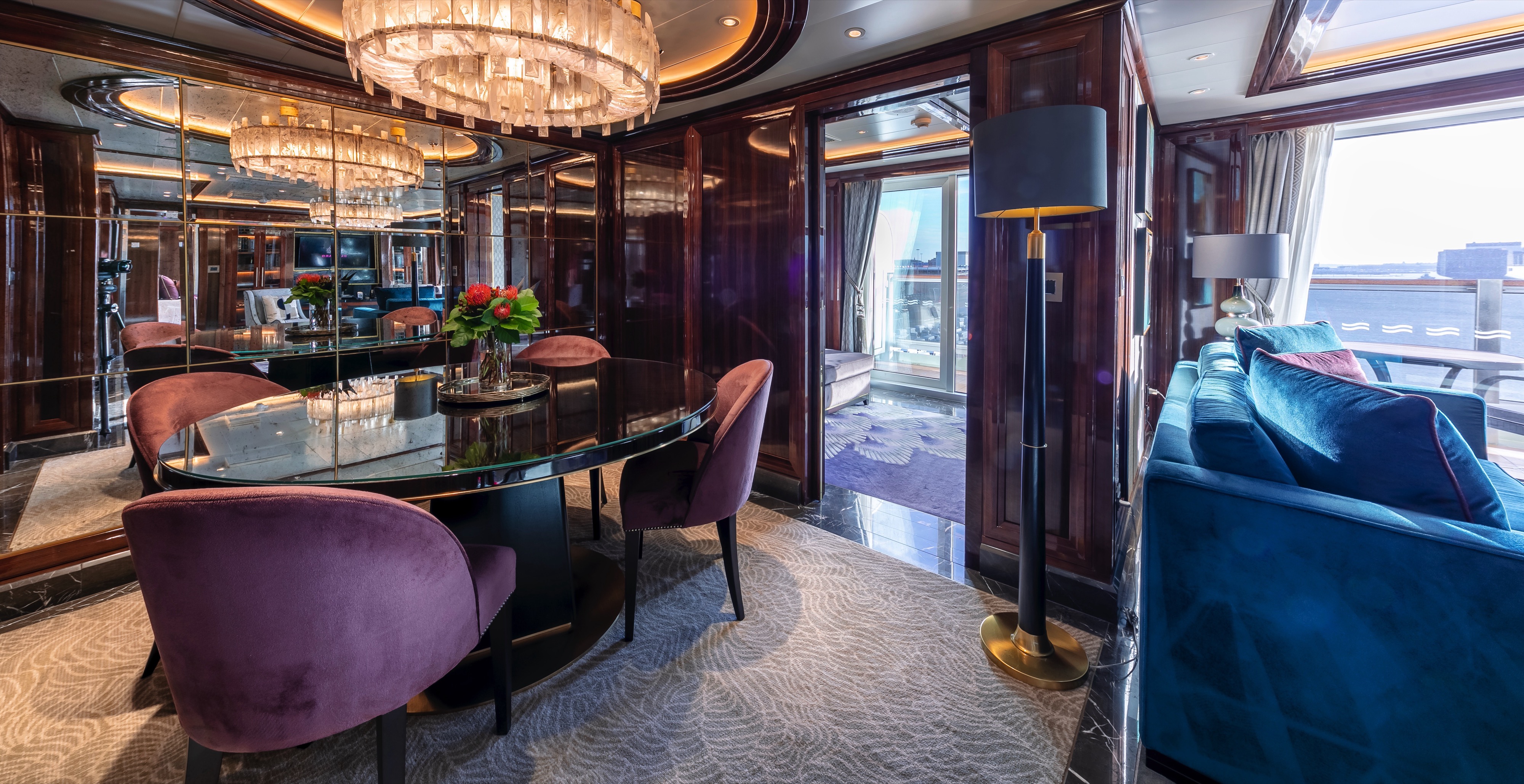
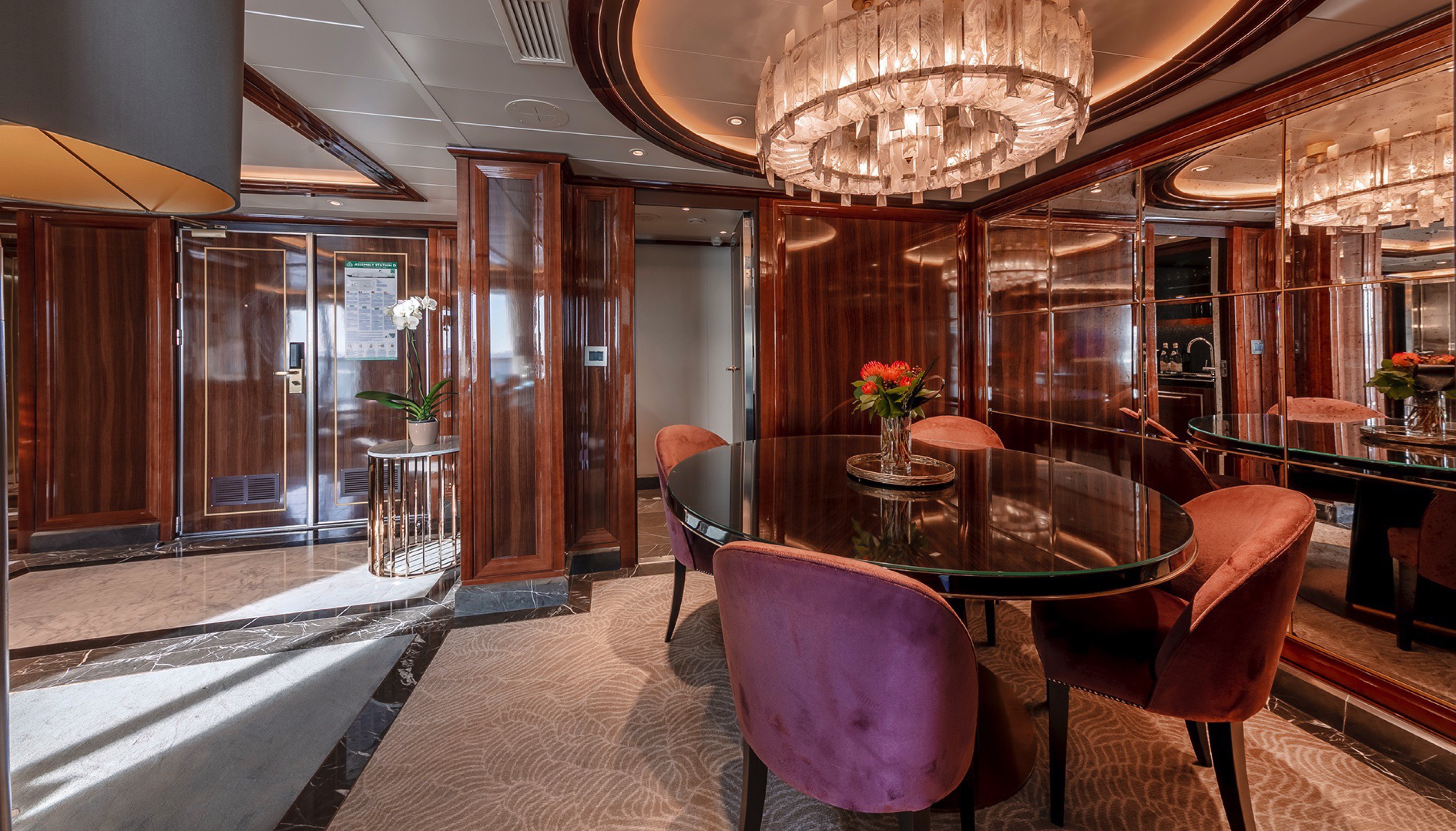
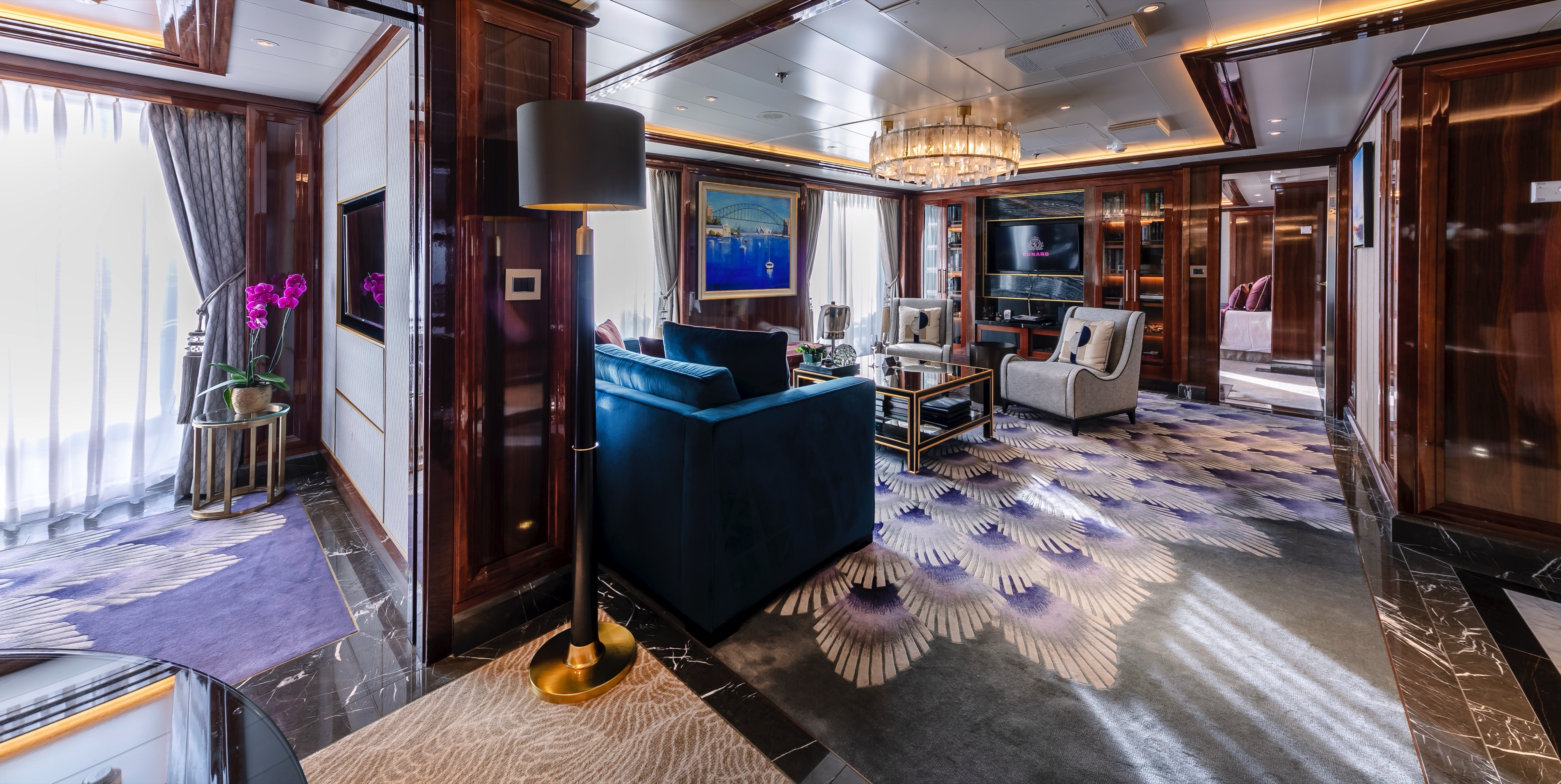
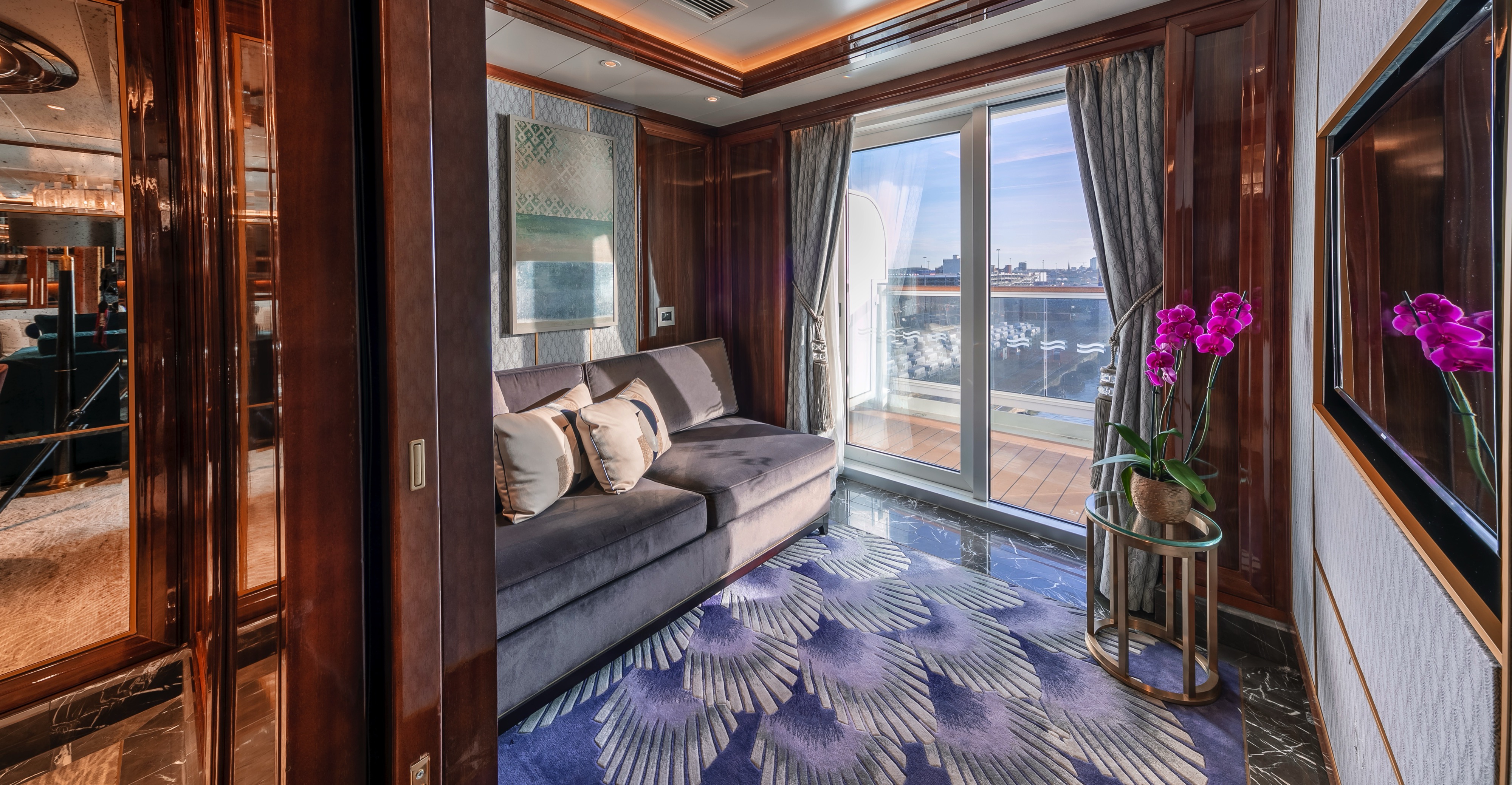
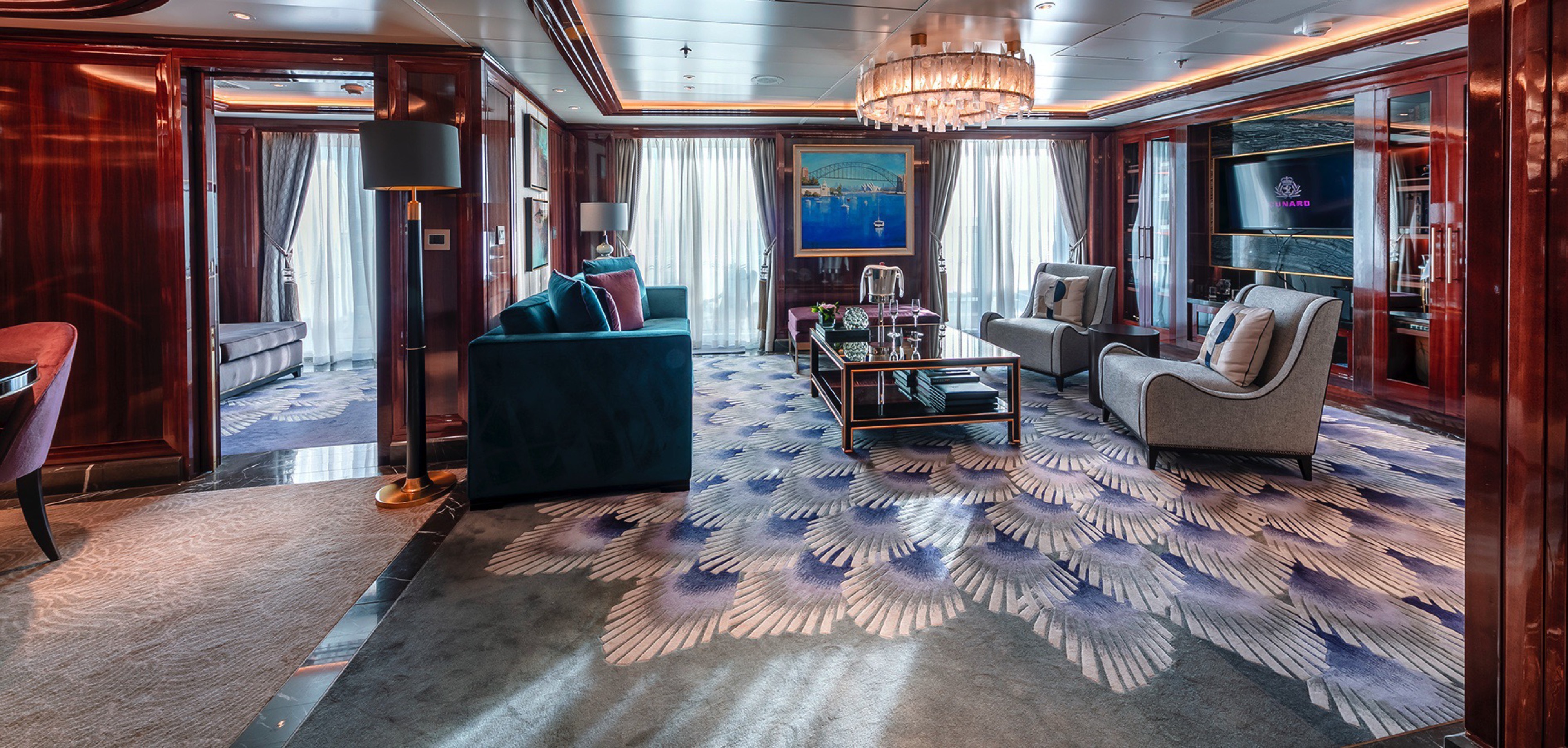
Approximately 1100 sq. ft.
Retreat to an exclusive world of luxury with your own private residence at sea. Bold Cunard accent colours and thoughtful designs bring each space in your suite to life. An attentive butler is on hand at all times to truly customise your voyage experience.
Each Queens Grill Master Suite includes:
- Access to the exclusive Queens Grill restaurant, where you can dine any time at your reserved table.
- Spacious lounge with seating and dedicated dining area.
- Bedroom with Cunarder bed configurable to king-size or two single beds.
- Pillow concierge menu with seven pillow types to choose from.
- Marble bathroom with twin washbasins, bathtub and walk-in shower.
- Spacious private balcony with seating and sea views.
- Satellite TV with movie and music channels in bedroom and lounge areas.
- Feature vanity with hairdryer.
- Writing desk with a set of personalised stationery.
- Fresh flowers.
- Binoculars and world atlas to track your travels.
- UK, USA and European power sockets.
- Penhaligon's toiletries.
- Luxury bathrobes and slippers.
- Complimentary mini-bar stocked with your choice of beer, wine, spirting and soft drinks.
- Speciality tea and coffee making facilities.
- Daily fresh fruit.
- Pre-dinner canapés.
- Welcome bottle of Champagne.
- Complimentary room service menu.
- Dine in-suite from the exclusive Queens Grill menu.
- Exclusive access to the Grills Lounge and outside Grills Terrace.
- Concierge service for on board reservations and shore experiences.
- A dedicated butler and steward to keep your suite in fine order day and night and host the perfect soirée.
- Priority embarkation and disembarkation.
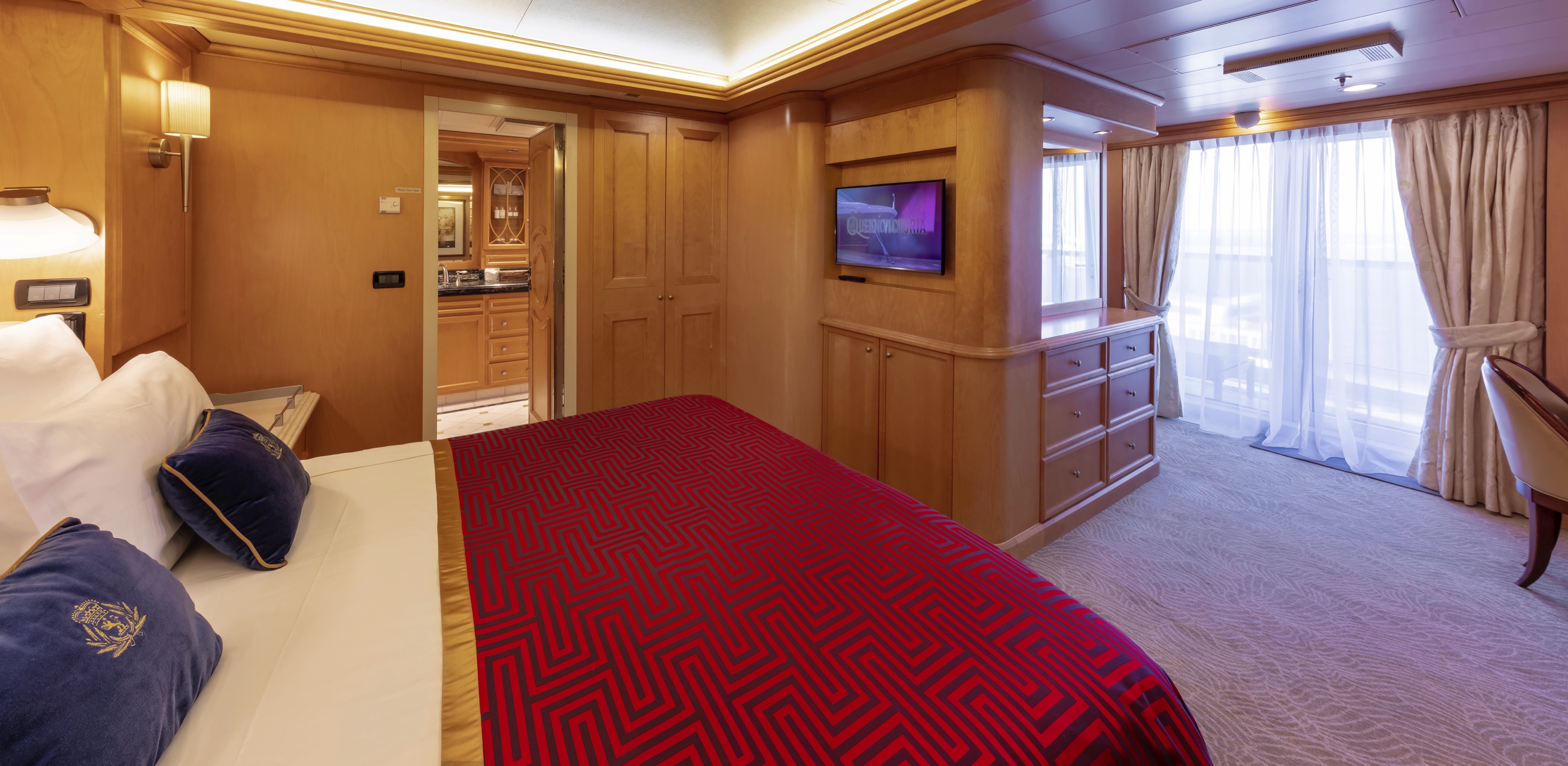
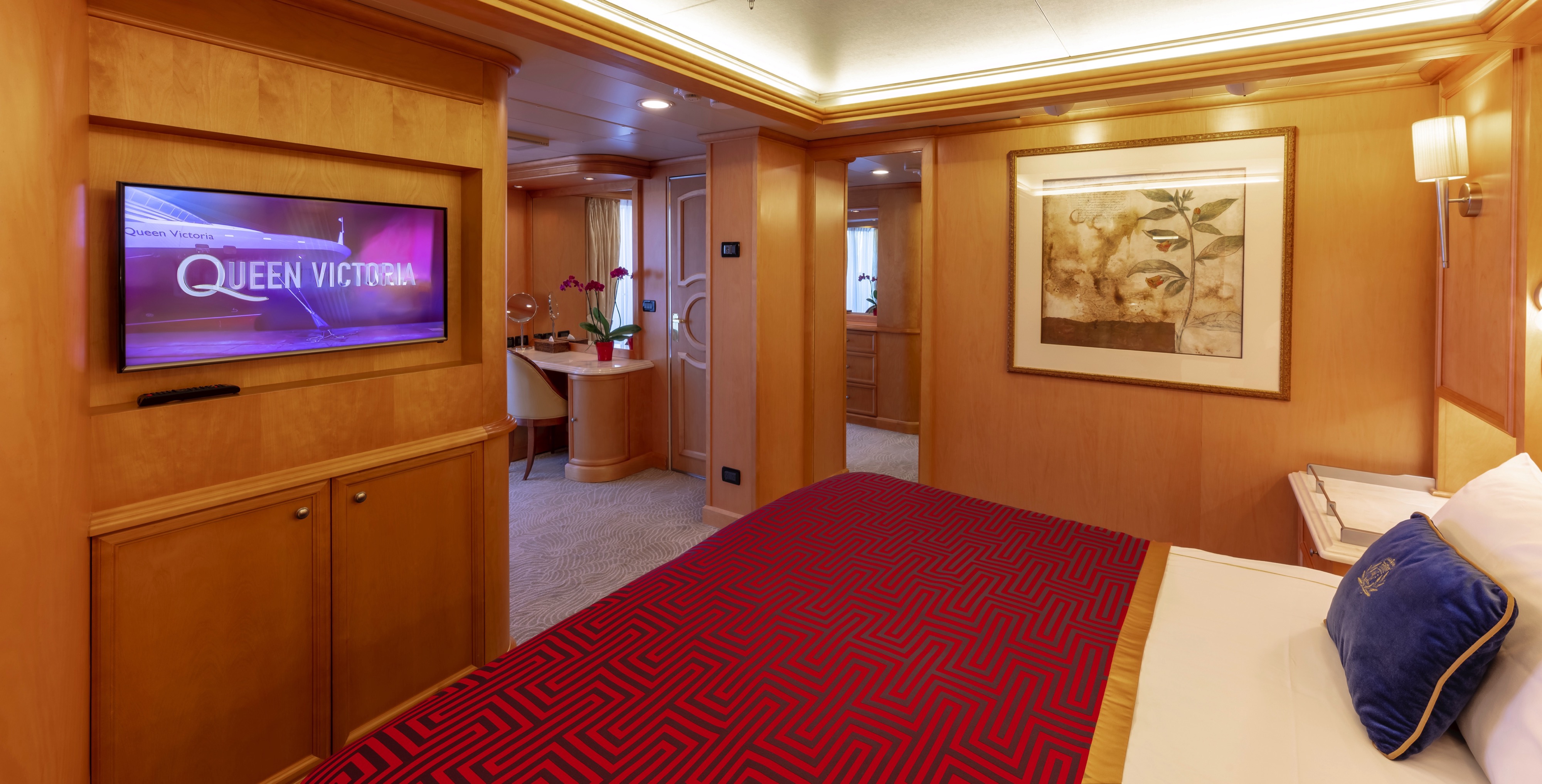
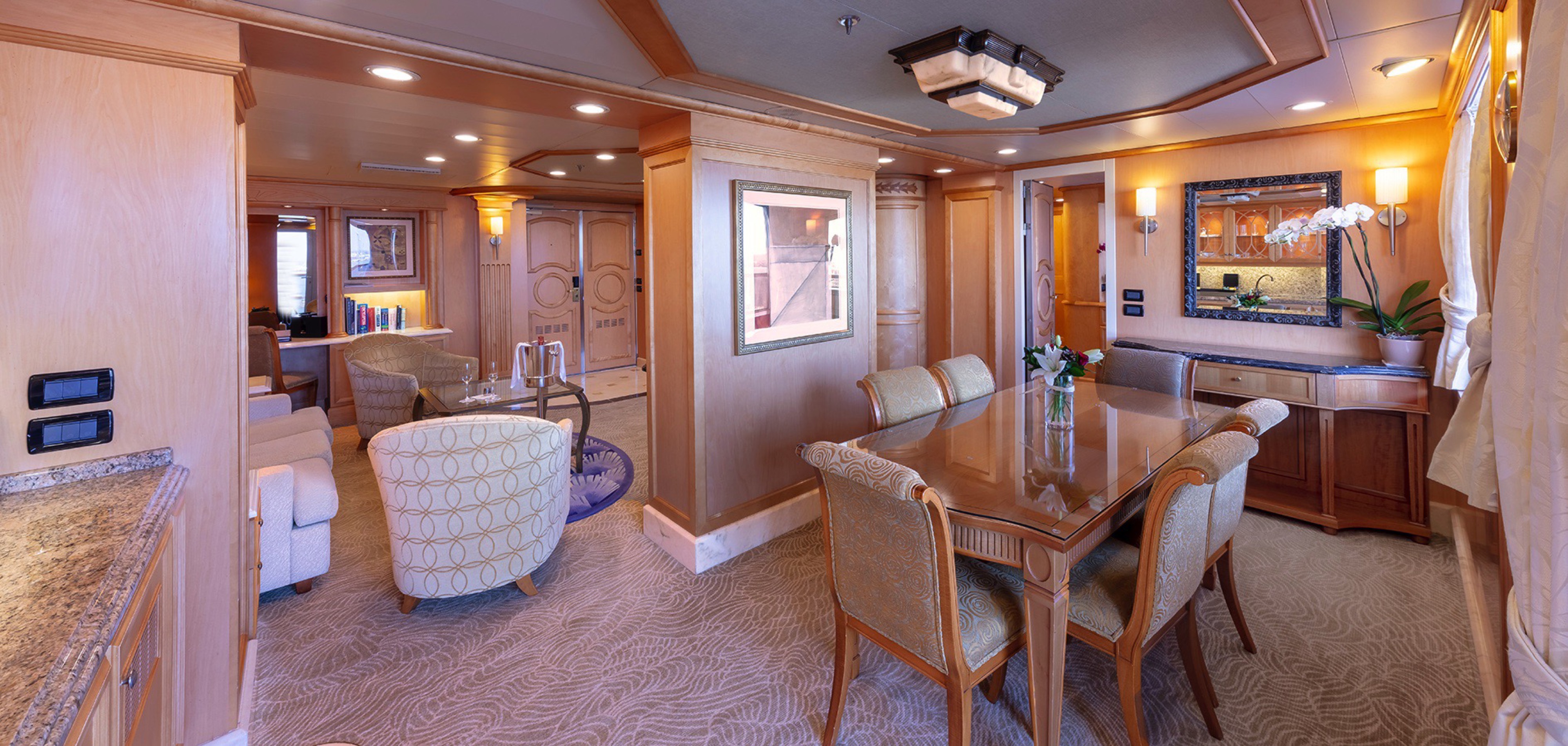
Approximately 484-596 sq. ft.
Retreat to an exclusive world of luxury with your own private residence at sea. Bold Cunard accent colours and thoughtful designs bring each space in your suite to life. An attentive butler is on hand at all times to truly customise your voyage experience.
Each Queens Grill Penthouse Suite includes:
- Access to the exclusive Queens Grill restaurant, where you can dine any time at your reserved table.
- Spacious lounge area with seating.
- Bedroom area with Cunarder bed configurable to king-size or two single beds.
- Pillow concierge menu with a variety of types to choose from.
- Bathroom with bath and shower and separate dressing area.
- Spacious private balcony with seating and sea views.
- Satellite TV with movie and music channels in bedroom and lounge areas.
- Feature vanity and desk with hairdryer.
- Fresh flowers.
- Binoculars and world atlas to track your travels.
- UK, USA and European power sockets.
- Penhaligon's toiletries.
- Luxury bathrobes and slippers.
- Complimentary mini-bar stocked with your choice of beer, wine, spirits and soft drinks.
- Speciality tea and coffee making facilities.
- Daily fresh fruit.
- Pre-dinner canapés.
- Welcome bottle of Champagne.
- Complimentary room service menu.
- Dine in-suite from the exclusive Queens Grill menu.
- Exclusive access to the Grills Lounge and outside Grills Terrace.
- Concierge service for on board reservations and shore experiences.
- A dedicated butler and steward to keep your suite in fine order day and night and host the perfect soirée.
- Priority embarkation and disembarkation
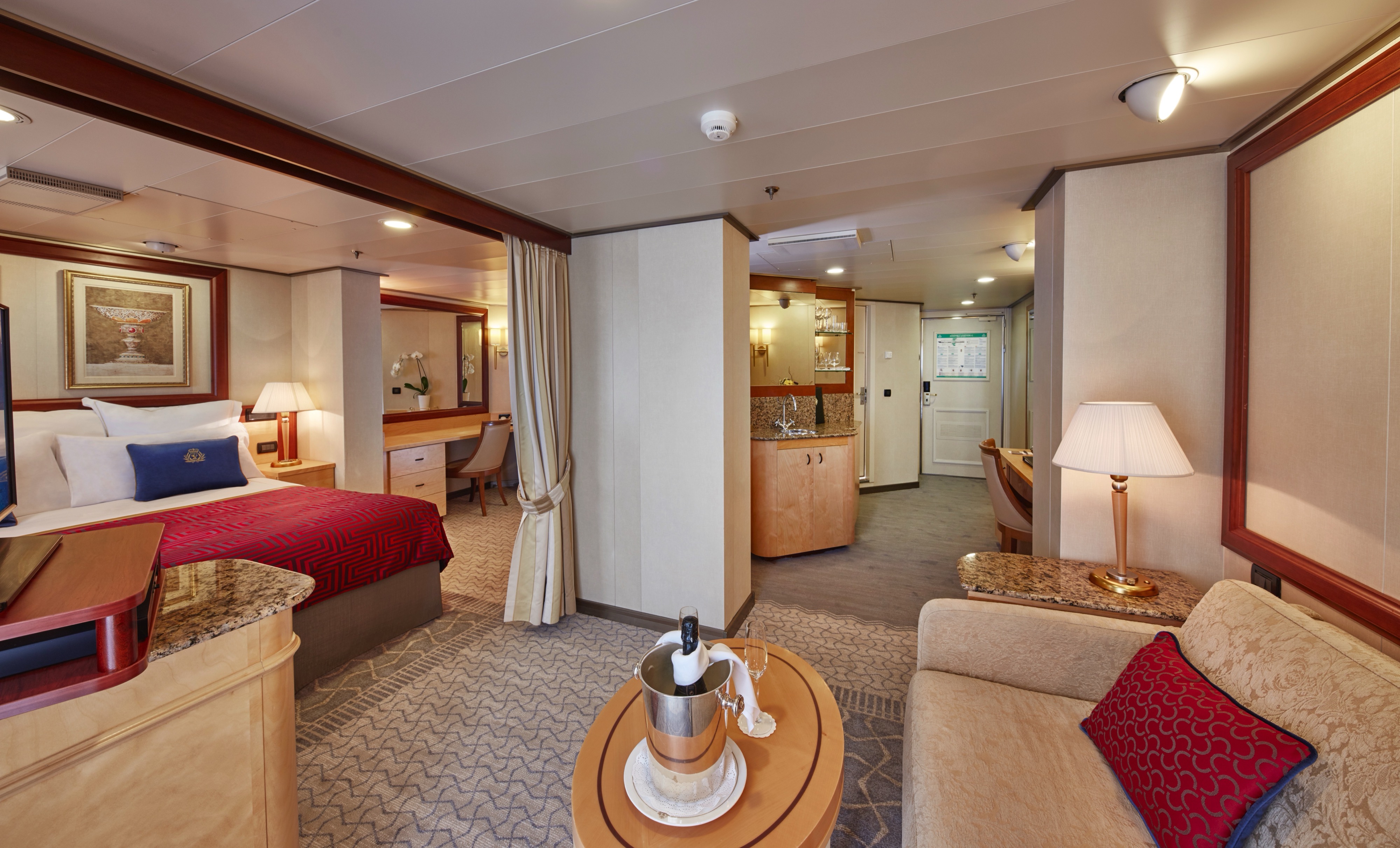
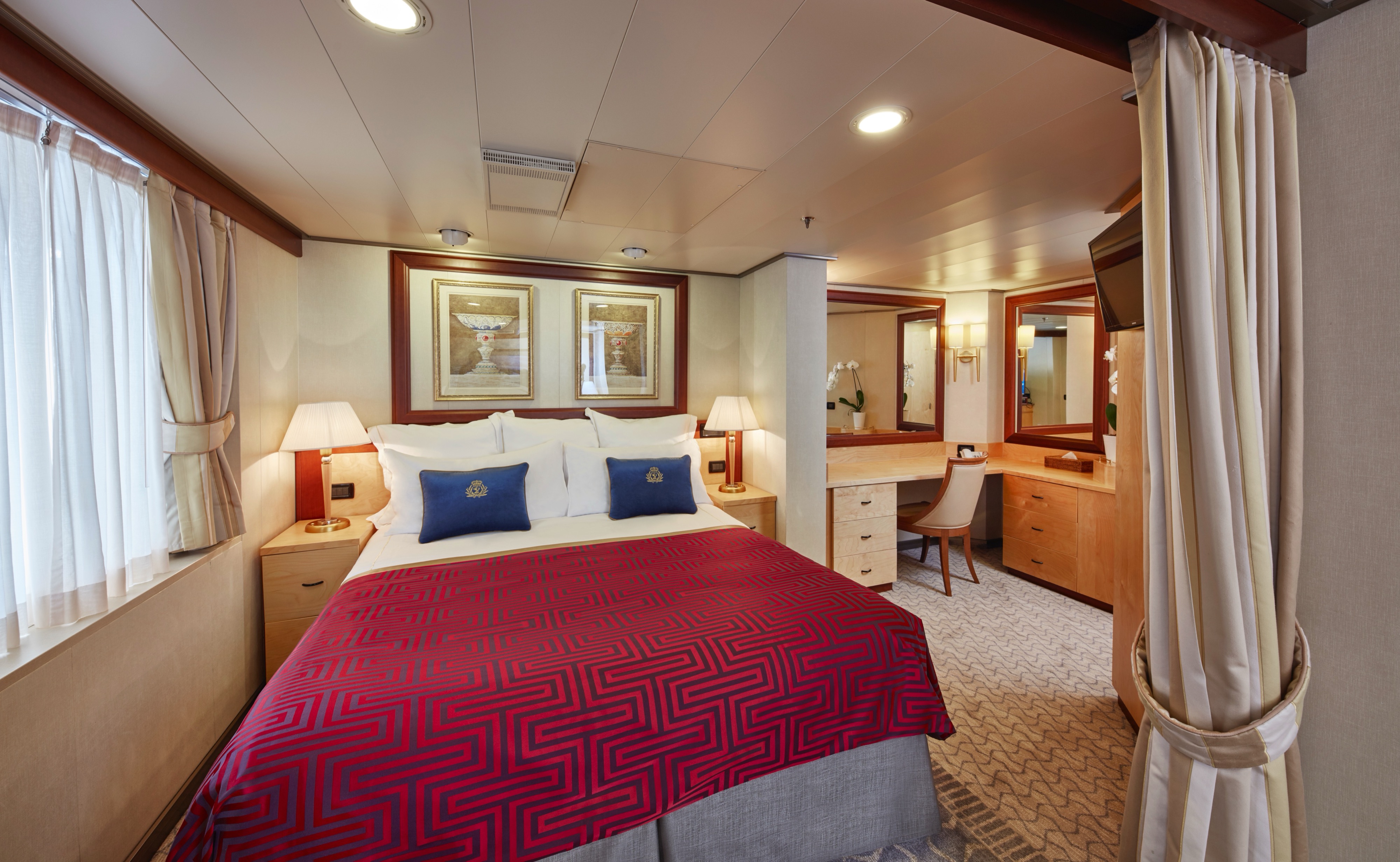
Approximately 484-757 sq. ft.
Retreat to an exclusive world of luxury with your own private residence at sea. Bold Cunard accent colours and thoughtful designs bring each space in your suite to life. An attentive butler is on hand at all times to truly customise your voyage experience.
Each Queens Grill Suite includes:
- Access to the exclusive Queens Grill restaurant, where you can dine any time at your reserved table.
- Spacious lounge area with seating.
- Bedroom area with Cunarder bed configurable to king-size or two single beds.
- Pillow concierge menu with a variety of types to choose from.
- Bathroom with bath and shower and separate dressing area.
- Spacious private balcony with seating and sea views.
- Satellite TV with movie and music channels in bedroom and lounge areas.
- Feature vanity and desk with hairdryer.
- Fresh flowers.
- Binoculars and world atlas to track your travels.
- UK, USA and European power sockets.
- Penhaligon's toiletries.
- Luxury bathrobes and slippers.
- Complimentary mini-bar stocked with your choice of beer, wine, spirits and soft drinks.
- Speciality tea and coffee making facilities.
- Daily fresh fruit.
- Pre-dinner canapés.
- Welcome bottle of Champagne.
- Complimentary room service menu.
- Dine in-suite from the exclusive Queens Grill menu.
- Exclusive access to the Grills Lounge and outside Grills Terrace.
- Concierge service for on board reservations and shore experiences.
- A dedicated butler and steward to keep your suite in fine order day and night and host the perfect soirée.
- Priority embarkation and disembarkation.
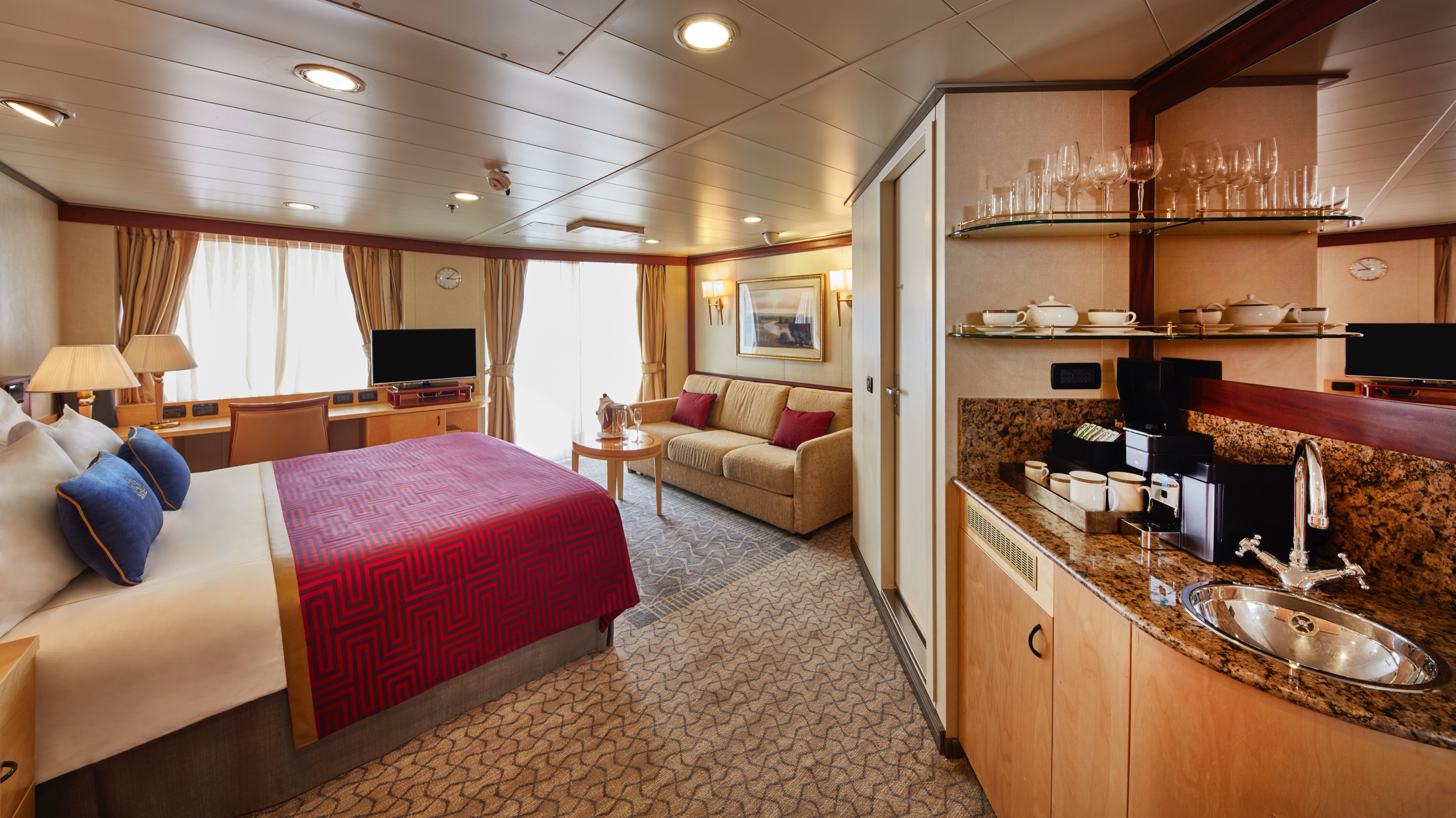
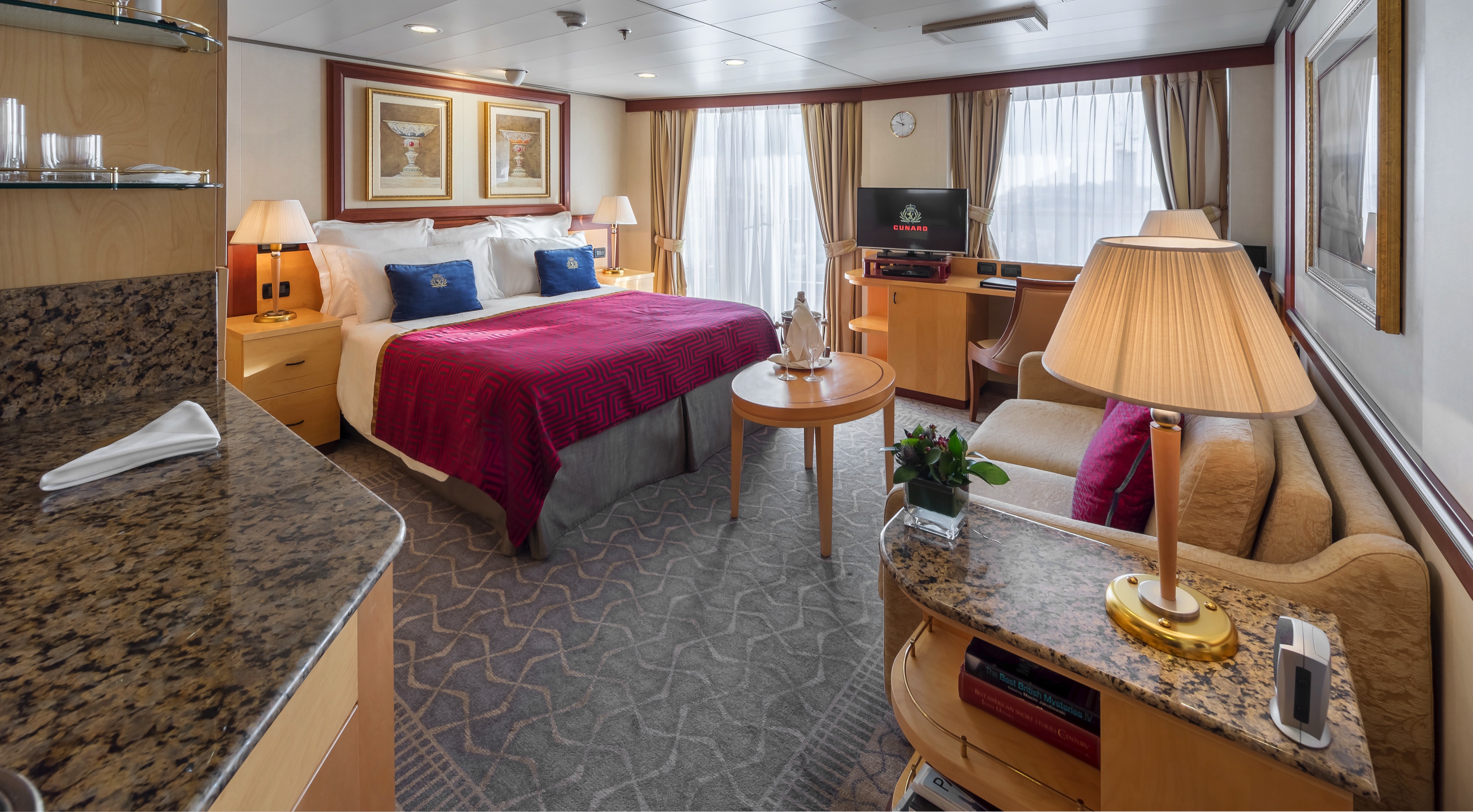
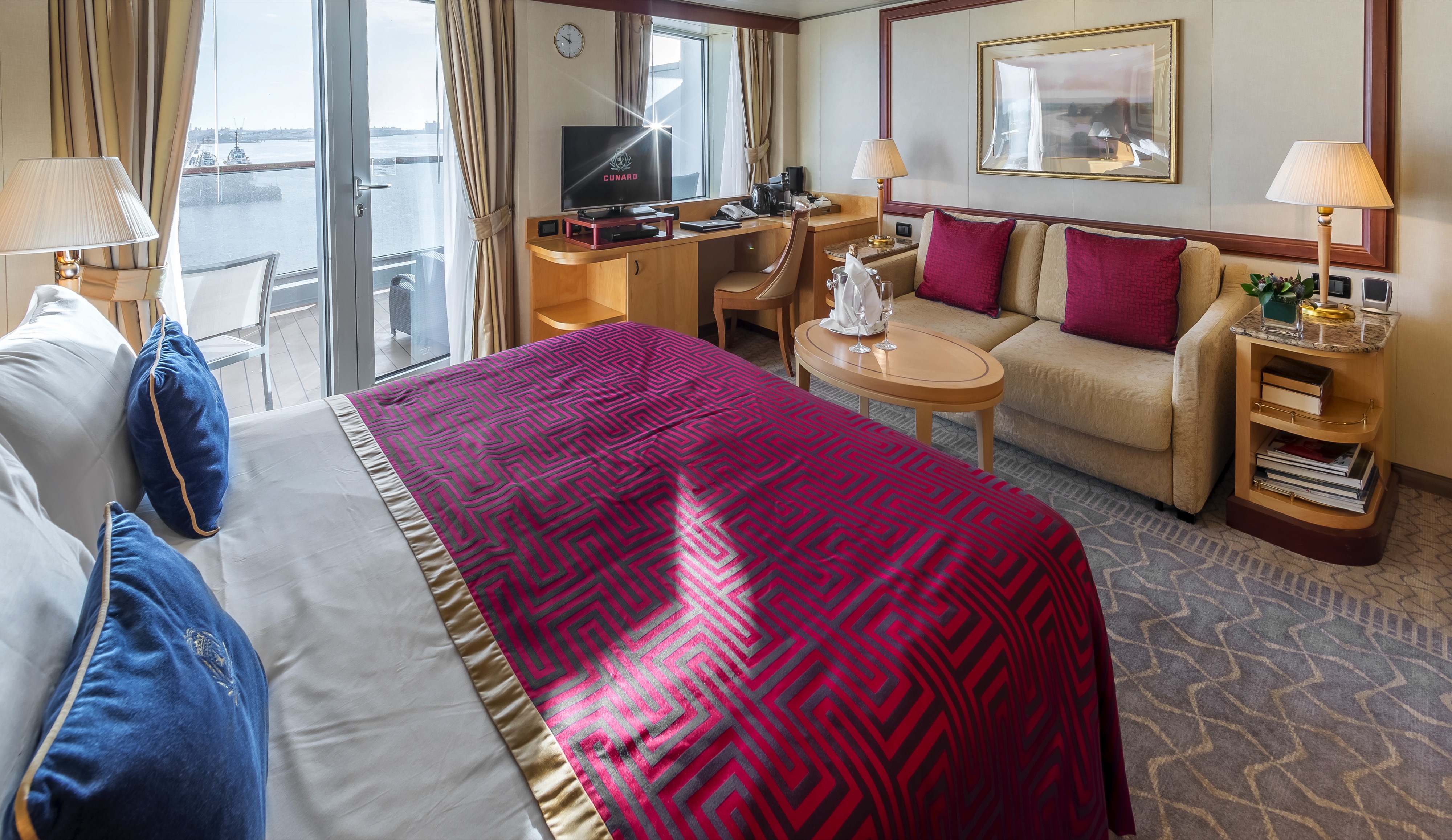
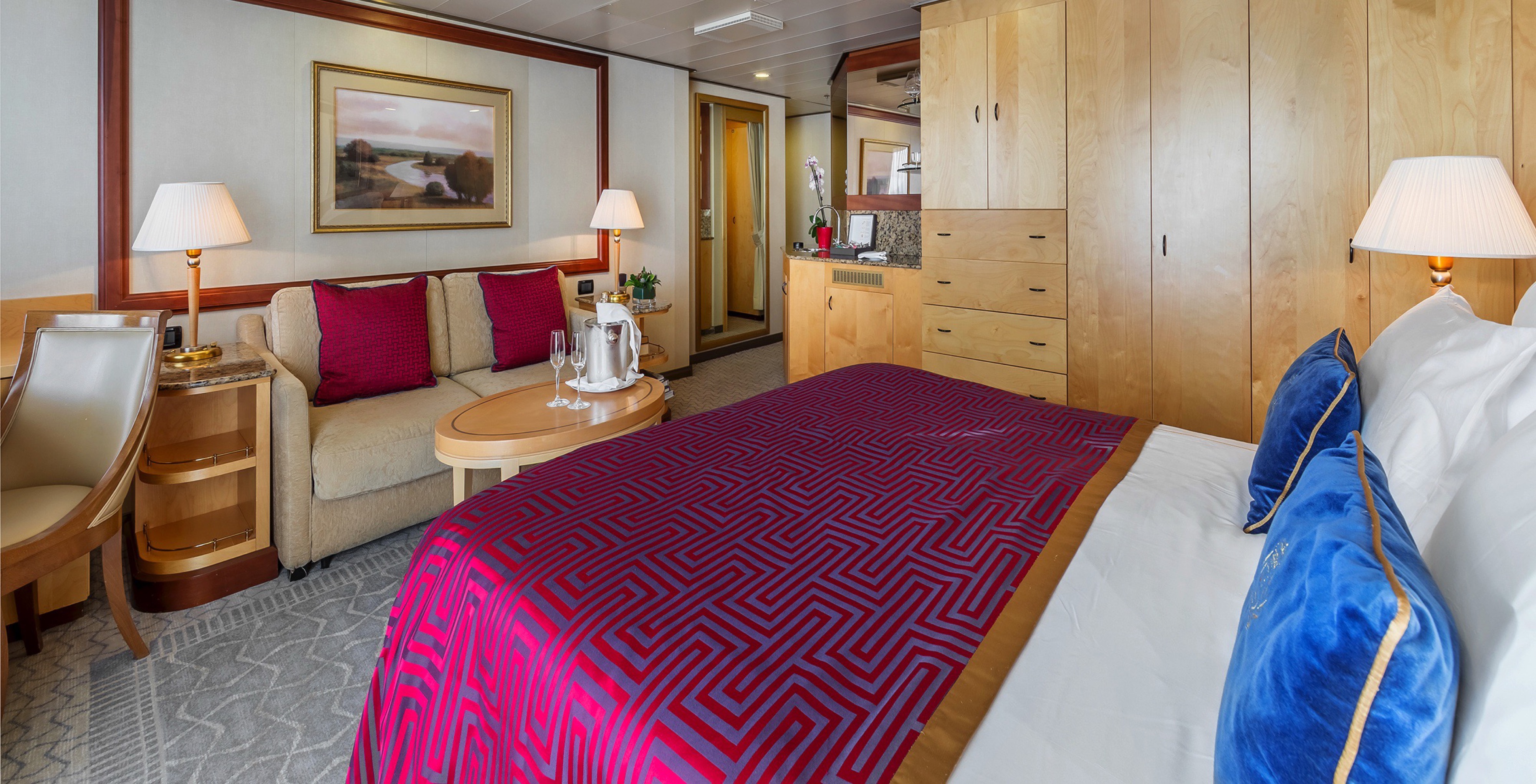
Approximately 335-513 sq. ft.
Delight in a prime location on board with sea views that can be enjoyed from both in and outside your Princess Suite. You’ll find thoughtful features and luxurious amenities, all organised by your dedicated steward to ensure you are always attentively looked after.
Each Princess Grill Suite includes:
- Exclusive access to the Princess Grill restaurant, where you can dine any time at your reserved table.
- Private balcony with seating and sea views.
- Spacious lounge area with seating.
- Bedroom area with Cunarder bed configurable to king-size or two single beds.
- Pillow concierge menu with a variety of types to choose from.
- Bathroom with bath and shower.
- Satellite TV with movie and music channels in lounge and bedroom areas.
- Feature vanity and desk with hairdryer.
- UK, USA and European power sockets.
- Penhaligon's toiletries.
- Luxury bathrobes and slippers.
- Feature mini-bar with speciality tea and coffee making facilities.
- Complimentary spring water replenished throughout your voyage.
- Daily fresh fruit.
- Mini-bar packages available for purchase.
- Welcome bottle of sparkling wine.
- Complimentary room service menu.
- Dine in-suite from the exquisite Princess Grill menu.
- Exclusive access to the Grills Lounge and outside Grills Terrace.
- Concierge service for on board reservations and shore experiences.
- A dedicated steward to keep your suite in fine order day and night.
- Priority embarkation and disembarkation.
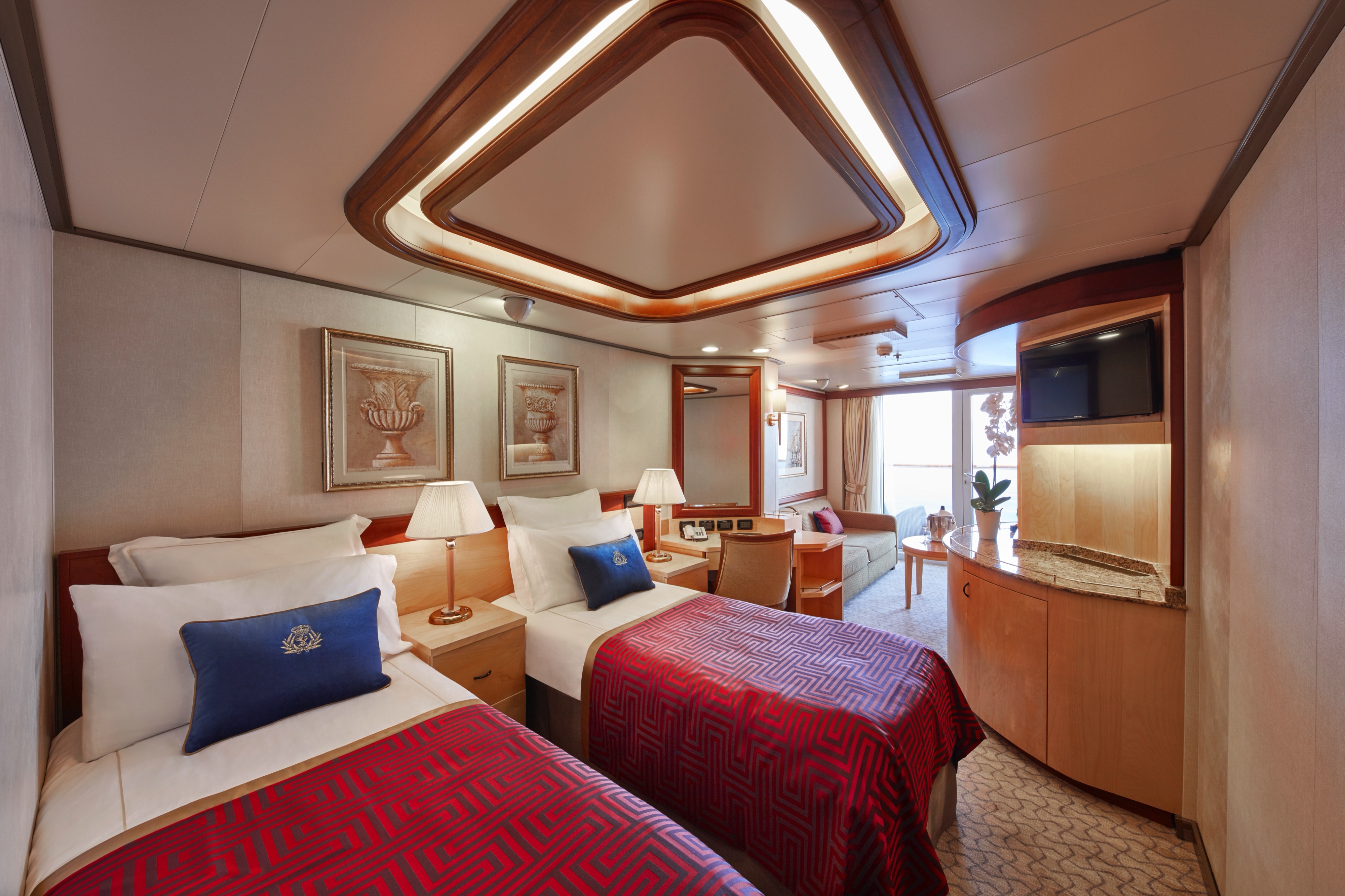
Approximately 254-470 sq. ft.
Take advantage of prime sea views from your own private, outdoor space in one of our Britannia Club Balcony staterooms. You’ll find thoughtful features, luxurious amenities and benefits, all organised by your dedicated steward to ensure you are always attentively looked after.
Each Britannia Club Balcony stateroom includes:
- Access to the intimate Britannia Club restaurant with a reserved table throughout your voyage.
- Private balcony with seating and sea views.
- Lounge area with seating.
- Cunarder bed configurable to king-size or two single beds.
- Bathroom with walk-in shower.
- Satellite TV with movie and music channels.
- Feature vanity and desk with hairdryer.
- UK, USA and European power sockets.
- Pillow concierge menu with a variety of types to choose from.
- Penhaligon's toiletries.
- Bathrobes and slippers.
- Speciality tea and coffee making facilities.
- Complimentary spring water replenished throughout your voyage.
- A welcome bottle of sparkling wine.
- Complimentary room service menu.
- Mini-bar packages available for purchase.
- A dedicated steward to keep your stateroom in fine order day and night.
- Priority embarkation and disembarkation.
Charges apply to room service after 10:00 AM.
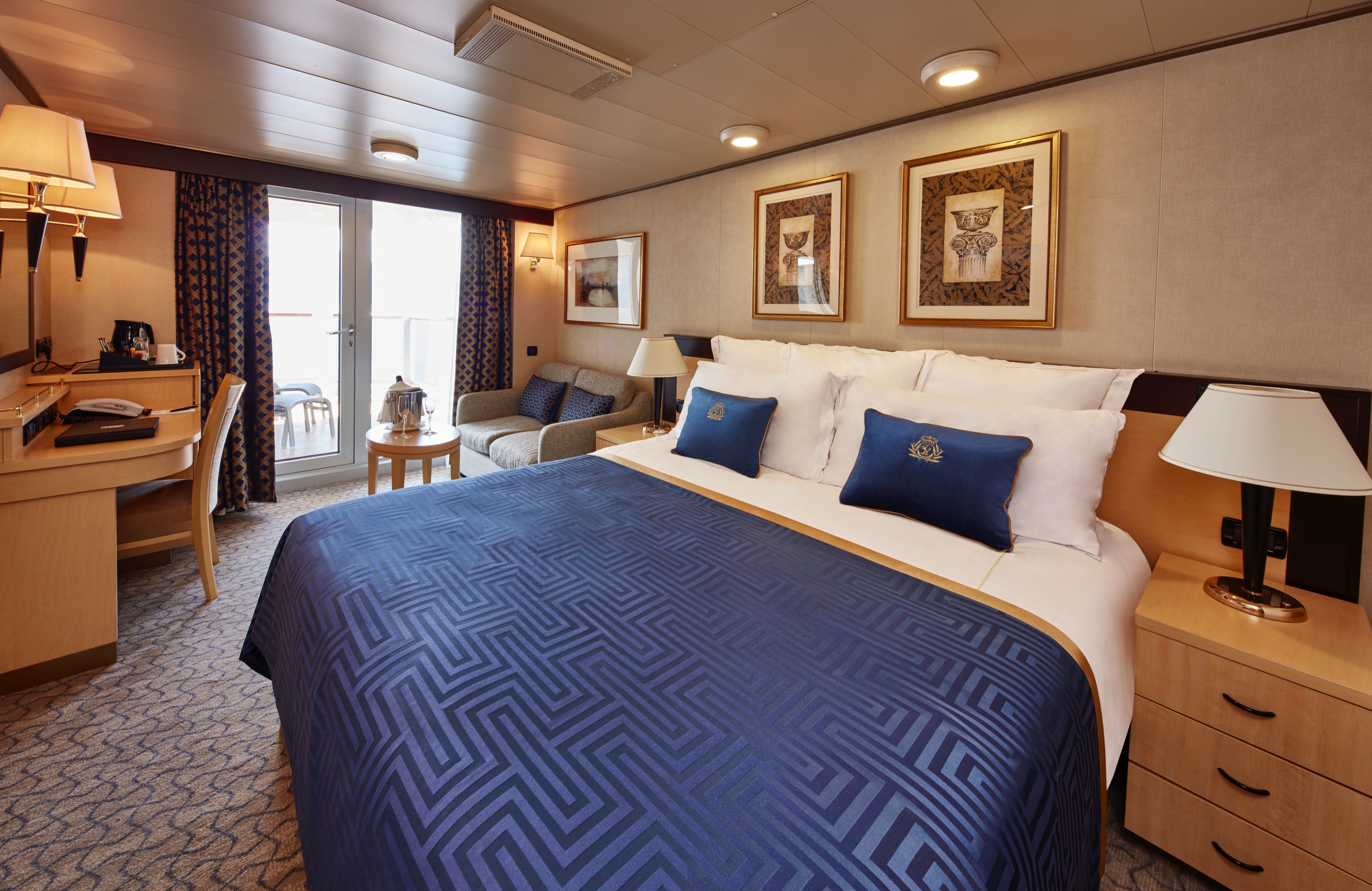
Approximately 228-472 sq. ft.
Drink in sparkling sea views from your own private, outdoor space in one of our Britannia Balcony staterooms. You’ll find thoughtful features and luxurious amenities, all organised by your dedicated steward to ensure you are always attentively looked after.
Each Britannia Balcony stateroom includes:
- Choice of Early, Late, and Open Dining in the Britannia Restaurant.
- Private balcony with seating and sea views.
- Lounge area with seating.
- Cunarder bed configurable to king-size or two single beds.
- Bathroom with walk-in shower.
- Satellite TV with movie and music channels.
- Feature vanity and desk with hairdryer.
- UK, USA and European power sockets.
- Penhaligon's toiletries.
- Bathrobes and slippers.
- Tea and coffee making facilities.
- Welcome sparkling wine.
- Complimentary room service menu.
- Mini-bar packages available for purchase.
- A dedicated steward to keep your stateroom in fine order day and night.
Charges apply to room service after 10:00 AM.
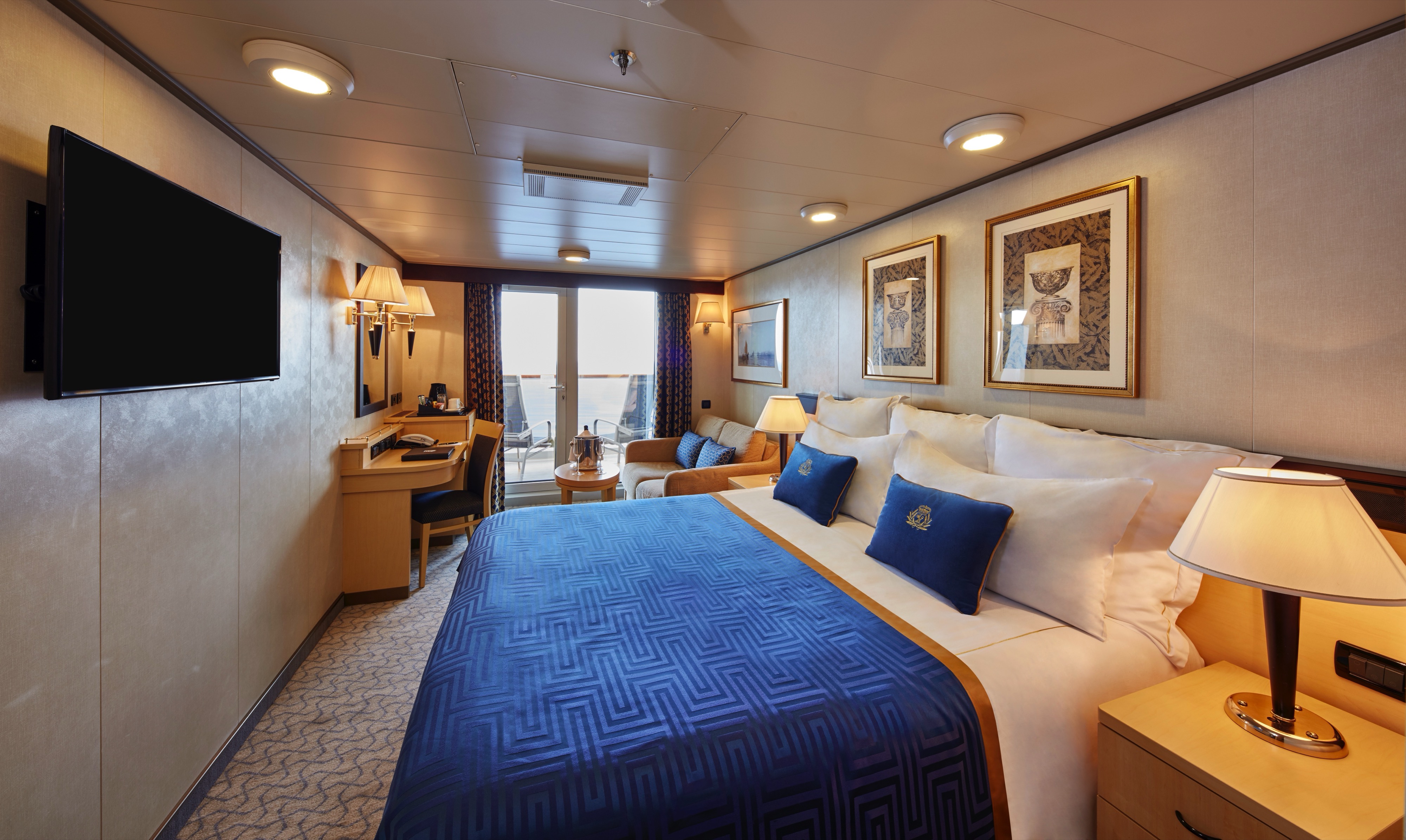
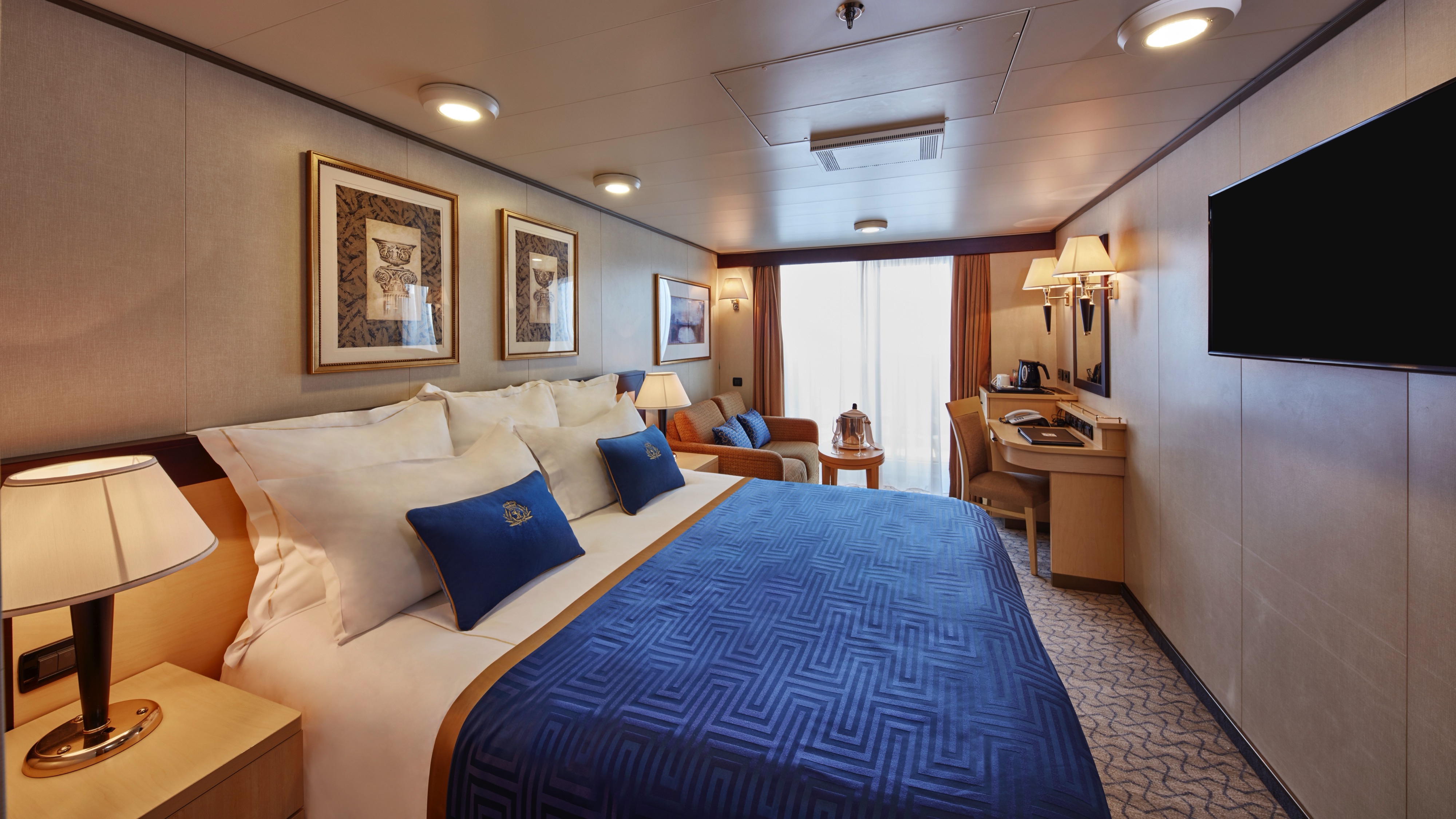
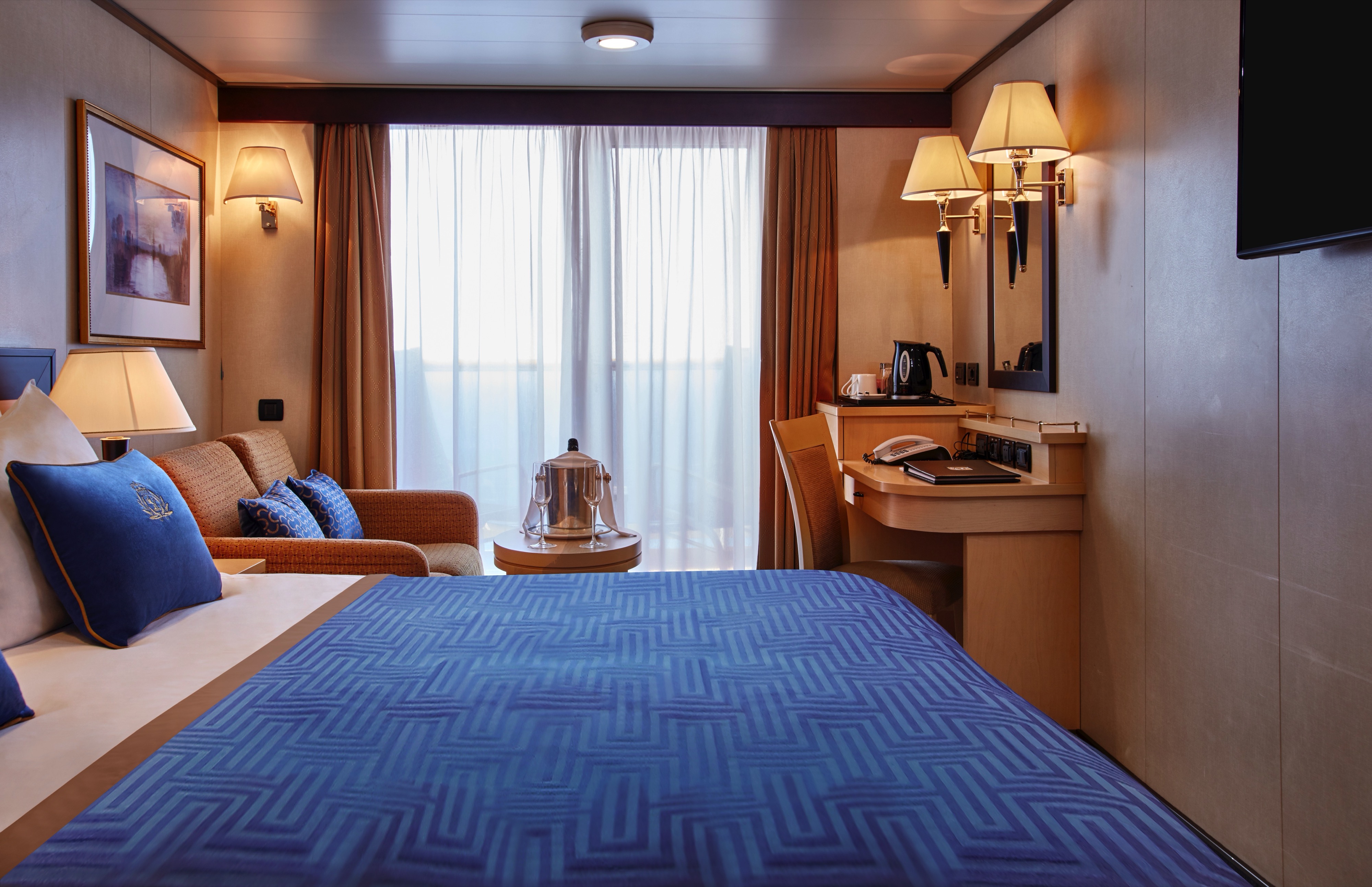
Approximately 228-408 sq. ft.
Enjoy access to private, outdoor space in one of our obstructed view Britannia Balcony staterooms. You’ll find thoughtful features and luxurious amenities, all organised by your dedicated steward to ensure you are always attentively looked after.
Each Britannia Balcony (obstructed view) stateroom includes:
- Choice of Early, Late, and Open Dining in the Britannia Restaurant.
- Private balcony (obstructed view) with seating.
- Lounge area with seating.
- Cunarder bed configurable to king-size or two single beds.
- Bathroom with walk-in shower.
- Satellite TV with movie and music channels.
- Feature vanity and desk with hairdryer.
- UK, USA and European power sockets.
- Penhaligon's toiletries.
- Bathrobes and slippers.
- Tea and coffee making facilities.
- Welcome sparkling wine.
- Complimentary room service menu.
- Mini-bar packages available for purchase.
- A dedicated steward to keep your stateroom in fine order day and night.
Charges apply to room service after 10:00 AM.
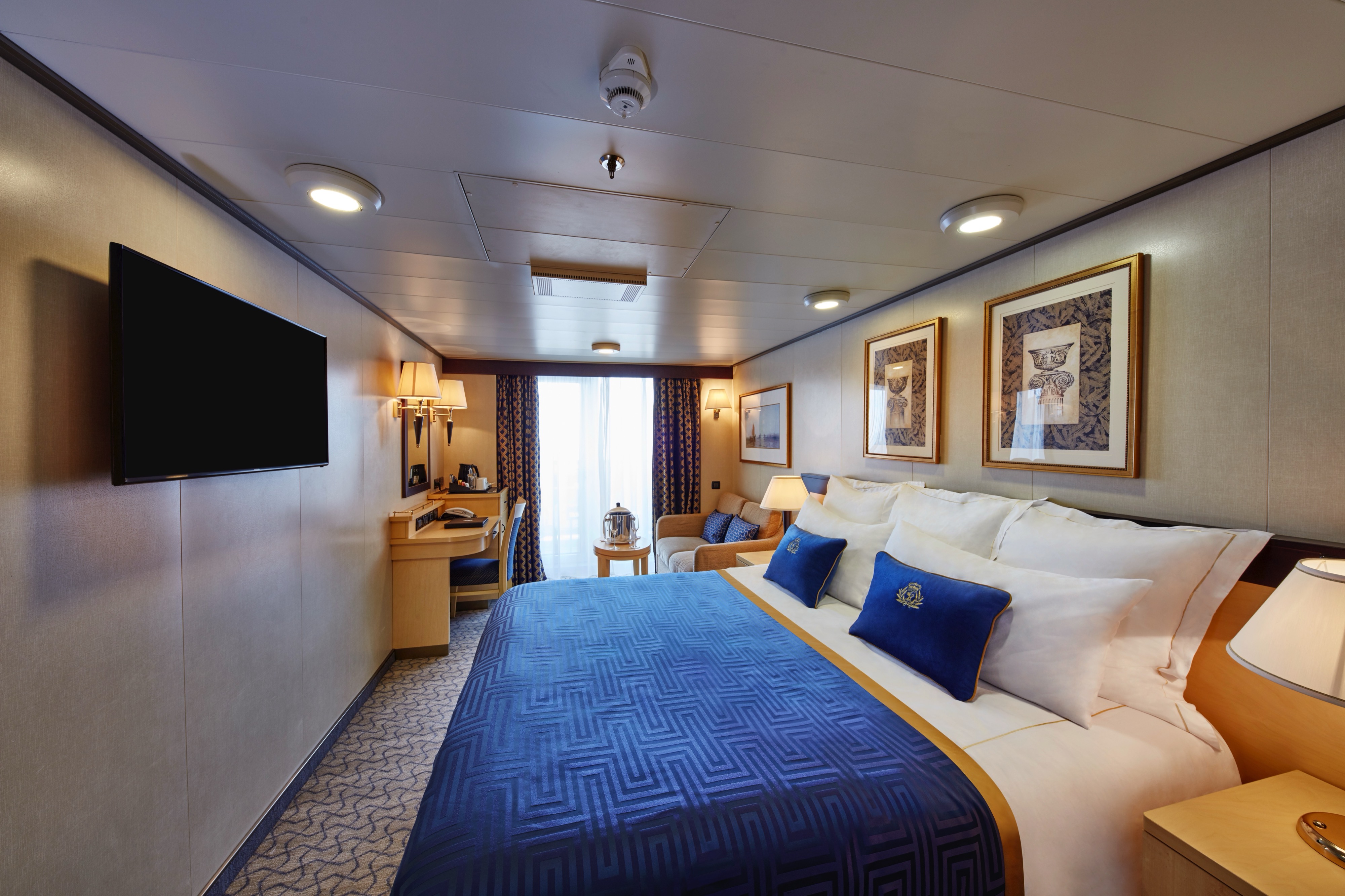
Approximately 228-408 sq. ft.
Enjoy access to private, outdoor space in one of our obstructed view Britannia Balcony staterooms. You’ll find thoughtful features and luxurious amenities, all organised by your dedicated steward to ensure you are always attentively looked after.
- Each Britannia Balcony (obstructed view) stateroom includes:
- Choice of Early, Late, and Open Dining in the Britannia Restaurant.
- Private balcony (obstructed view) with seating.
- Lounge area with seating.
- Cunarder bed configurable to king-size or two single beds.
- Bathroom with walk-in shower.
- Satellite TV with movie and music channels.
- Feature vanity and desk with hairdryer.
- UK, USA and European power sockets.
- Penhaligon's toiletries.
- Bathrobes and slippers.
- Tea and coffee making facilities.
- Welcome sparkling wine.
- Complimentary room service menu.
- Mini-bar packages available for purchase.
- A dedicated steward to keep your stateroom in fine order day and night.
Charges apply to room service after 10:00 AM.
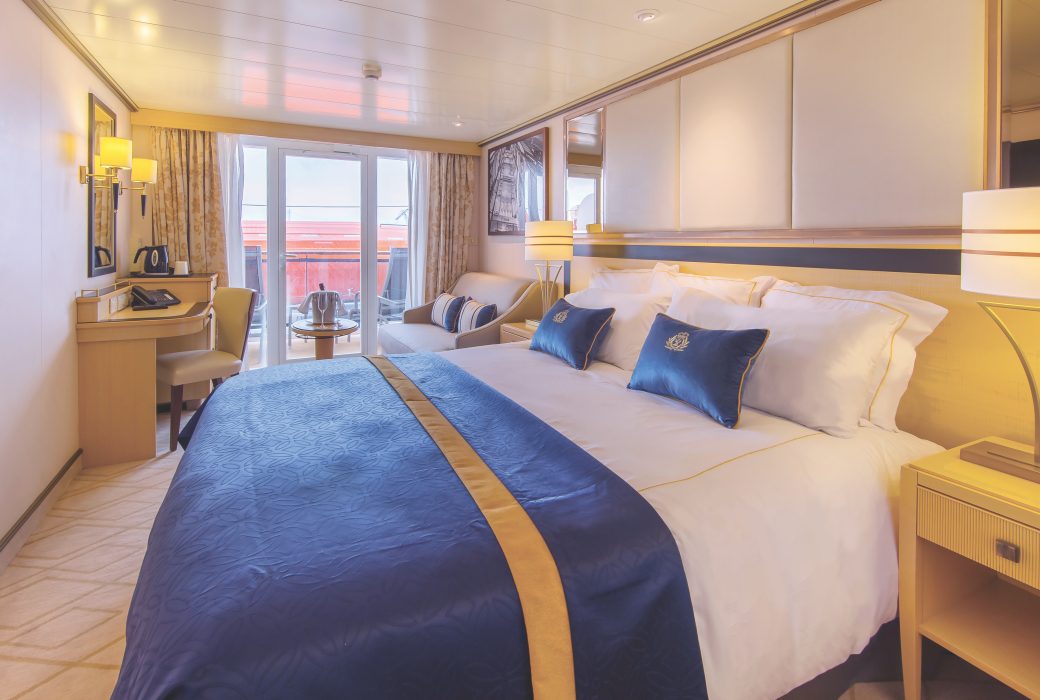
Approximately 228-408 sq. ft.
Enjoy access to private, outdoor space in one of our obstructed view Britannia Balcony staterooms. You’ll find thoughtful features and luxurious amenities, all organised by your dedicated steward to ensure you are always attentively looked after.
Each Britannia Balcony (obstructed view) stateroom includes:
- Choice of Early, Late, and Open Dining in the Britannia Restaurant.
- Private balcony (obstructed view) with seating.
- Lounge area with seating.
- Cunarder bed configurable to king-size or two single beds.
- Bathroom with walk-in shower.
- Satellite TV with movie and music channels.
- Feature vanity and desk with hairdryer.
- UK, USA and European power sockets.
- Penhaligon's toiletries.
- Bathrobes and slippers.
- Tea and coffee making facilities.
- Welcome sparkling wine.
- Complimentary room service menu.
- Mini-bar packages available for purchase.
- A dedicated steward to keep your stateroom in fine order day and night.
Charges apply to room service after 10:00 AM.
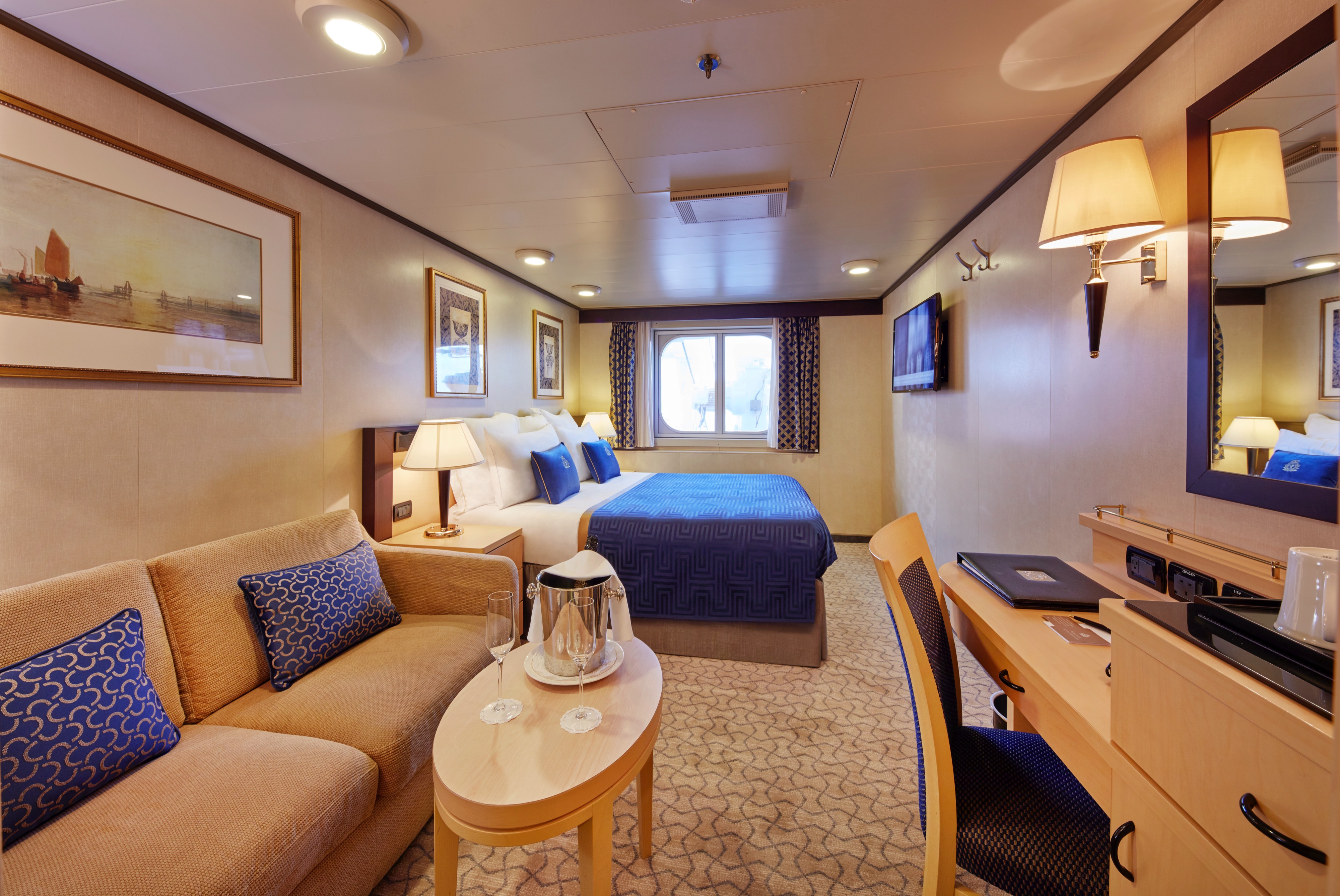
Approximately 197-201 sq. ft.
Positioned to offer sea views, our Britannia Oceanview staterooms provide a private enclave from which to watch the world go by. Perfectly framed views are the backdrop to thoughtful features and luxurious amenities, all organised by your dedicated steward to ensure you are always attentively looked after.
Each Britannia Oceanview stateroom includes:
- Choice of Early, Late, and Open Dining in the Britannia Restaurant.
- Lounge area with seating.
- Cunarder bed configurable to king-size or two single beds.
- Bathroom with a walk-in shower.
- Window with sea view.
- Satellite TV with movie and music channels.
- Feature vanity and desk with hairdryer.
- UK, USA and European power sockets.
- Penhaligon's toiletries.
- Bathrobes and slippers.
- Tea and coffee making facilities.
- Welcome sparkling wine.
- Complimentary room service menu.
- Mini-bar packages available for purchase.
- A dedicated steward to keep your stateroom in fine order day and night.
Charges apply to room service after 10:00 AM.
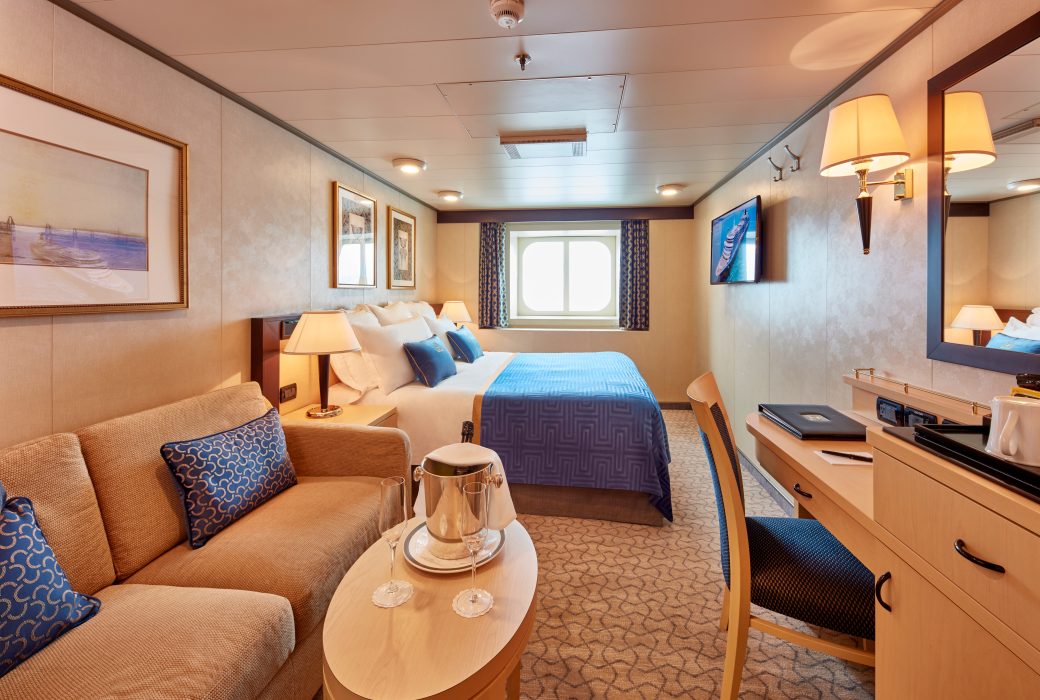
Approximately 152 sq. ft.
With a variety of locations to choose from on board, our well-appointed Britannia Standard Inside staterooms are a haven of comfort and style to enjoy during your voyage. You’ll find thoughtful features and luxurious amenities, all organised by your dedicated steward to ensure you are always attentively looked after.
Each Britannia Standard Inside stateroom includes:
- Choice of Early, Late, and Open Dining in the Britannia Restaurant.
- Cunarder bed configurable to king-size or two single beds.
- Bathroom with a walk-in shower.
- Satellite TV with movie and music channels.
- Feature vanity and desk with hairdryer.
- UK, USA and European power sockets.
- Penhaligon's toiletries.
- Bathrobes and slippers.
- Tea and coffee making facilities.
- Welcome sparkling wine.
- Complimentary room service menu.
- Mini-bar packages available for purchase.
- A dedicated steward to keep your stateroom in fine order day and night.
Charges apply to room service after 10:00 AM.

Approximately 200-243 sq. ft.
With a variety of locations to choose from on board, our spacious Britannia Deluxe Inside staterooms are a haven of comfort and style to enjoy during your voyage. You’ll find thoughtful features and luxurious amenities, all organised by your dedicated steward to ensure you are always attentively looked after.
Each Britannia Deluxe Inside stateroom includes:
- Choice of Early, Late, and Open Dining in the Britannia Restaurant.
- Cunarder bed configurable to king-size or two single beds.
- Bathroom with a walk-in shower.
- Satellite TV with movie and music channels.
- Feature vanity and desk with hairdryer.
- UK, USA and European power sockets.
- Penhaligon's toiletries.
- Bathrobes and slippers.
- Tea and coffee making facilities.
- Welcome sparkling wine.
- Complimentary room service menu.
- Mini-bar packages available for purchase.
- A dedicated steward to keep your stateroom in fine order day and night.
Charges apply to room service after 10:00 AM.
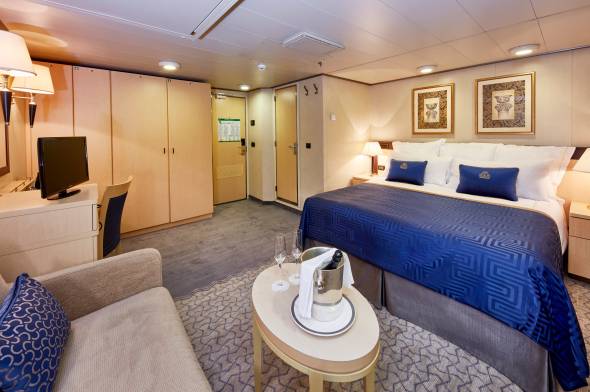
Approximately 159 sq. ft.
Our spacious Britannia Single Inside staterooms are a haven of comfort and style to enjoy during your voyage. You’ll find thoughtful features and luxurious amenities, all organised by your dedicated steward to ensure you are always attentively looked after.
Each Britannia Single Inside stateroom includes:
- Choice of Early, Late, and Open Dining in the Britannia Restaurant.
- A generous width single bed and desk with stationery.
- Bathroom with a walk-in shower.
- Satellite TV with movie and music channels.
- Feature vanity with hairdryer.
- UK, USA and European power sockets.
- Penhaligon's toiletries.
- Bathrobes and slippers.
- Tea and coffee making facilities.
- Welcome sparkling wine.
- Complimentary room service menu.
- Mini-bar packages available for purchase.
- A dedicated steward to keep your stateroom in fine order day and night.
Charges apply to room service after 10:00 AM.
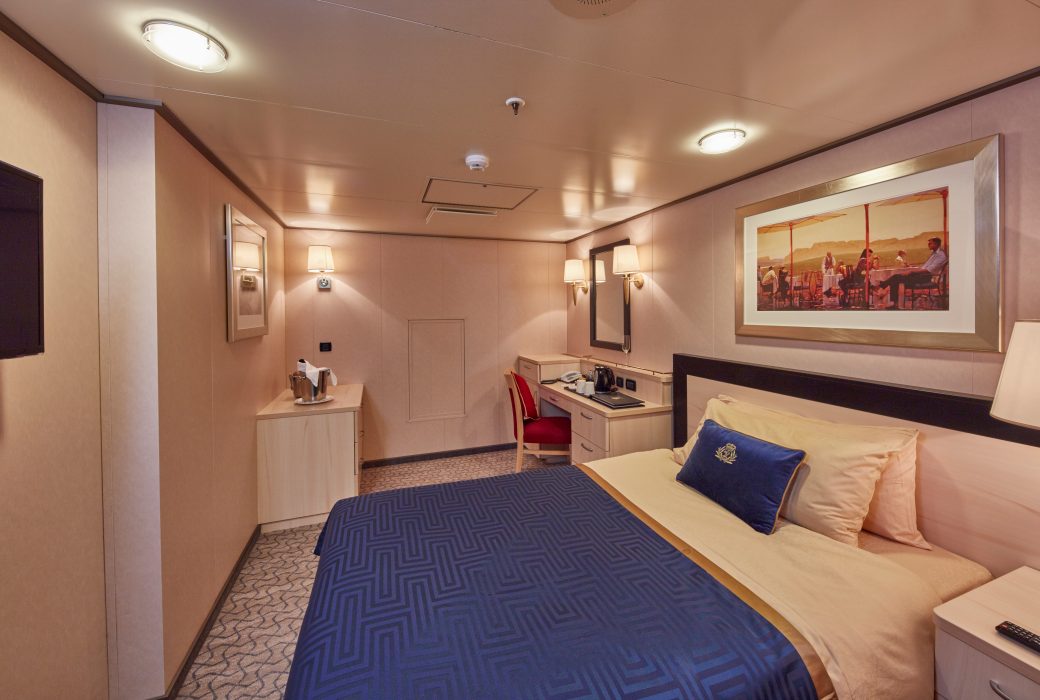
Approximately 133-168 sq. ft.
Positioned to offer sea views, our Britannia Single Oceanview staterooms provide a private enclave from which to watch the world go by. Perfectly framed views are the backdrop to thoughtful features and luxurious amenities, all organised by your dedicated steward to ensure you are always attentively looked after.
Each Britannia Single Oceanview stateroom includes:
- Choice of Early, Late, and Open Dining in the Britannia Restaurant.
- Lounge area with seating.
- Comfortable Cunarder single bed.
- Bathroom with a walk-in shower.
- Window with sea view.
- Satellite TV with movie and music channels.
- Feature vanity and desk with hairdryer.
- UK, USA and European power sockets.
- Penhaligon's toiletries.
- Bathrobes and slippers.
- Tea and coffee making facilities.
- Welcome sparkling wine.
- Complimentary room service menu.
- Mini-bar packages available for purchase.
- A dedicated steward to keep your stateroom in fine order day and night.
Charges apply to room service after 10:00 AM.
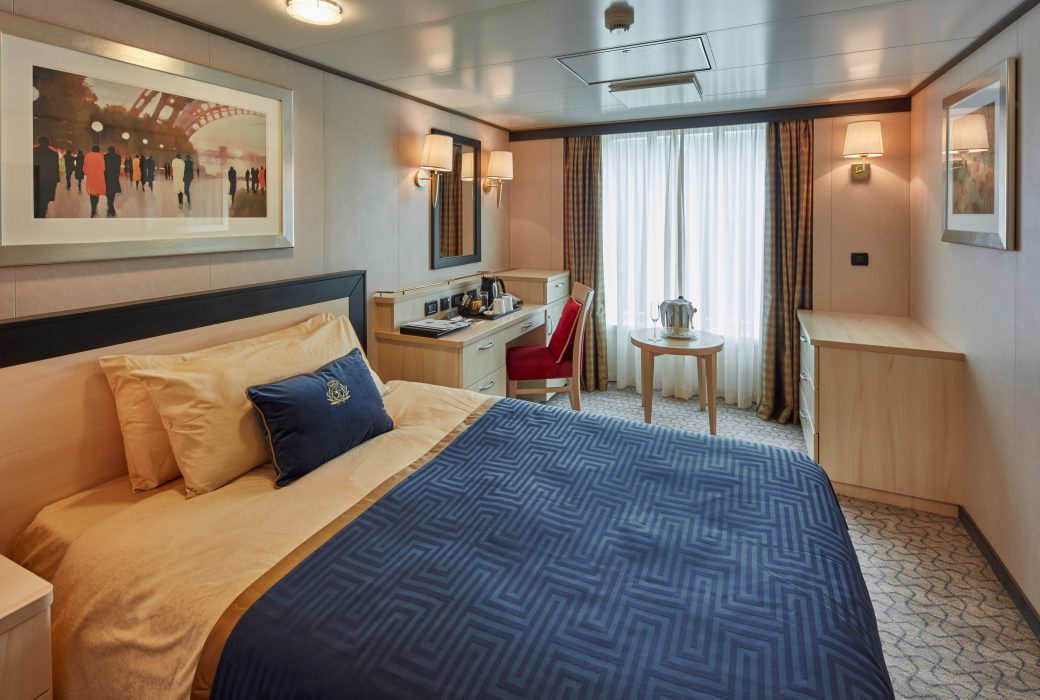
Queen Victoria
Queen Victoria will delight you with her special appeal, where elegance and unique features combine seamlessly with outstanding hospitality. You’ll discover an extraordinary way to see the world.
From the moment you step on board, you're immersed in an enchanting world of pleasure and escapism. Pass leisurely days soaking up the sunshine or gazing out at the tranquil ocean from her light-filled Winter Garden. Learn something new with our Cunard Insights speakers, or simply unwind with a good read. As evening falls, choose from a delectable array of dining options, and enjoy world-class entertainment in the Royal Court Theatre. On Queen Victoria the freedom to create your perfect trip is all yours.
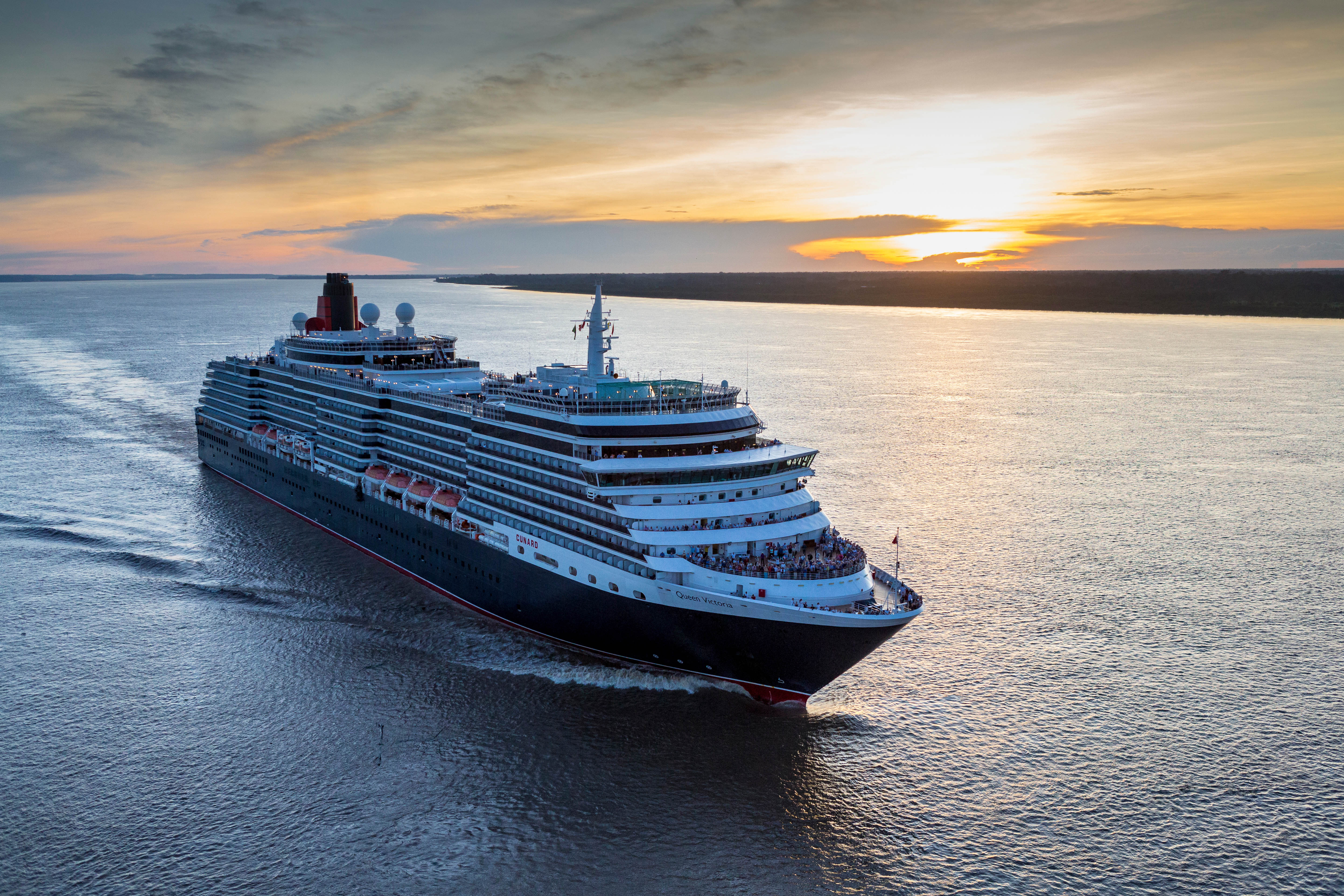
Ship Facts
| Launch Year | 2007 | ||||||||
| Refit Year | 2017 | ||||||||
| Language | en | ||||||||
| Gross Tonnage | 90049 | ||||||||
| Length | 294 | ||||||||
| Width | 32.3 | ||||||||
| Currency | USD | ||||||||
| Speed | 18 | ||||||||
| Capacity | 2061 | ||||||||
| Crew Count | 913 | ||||||||
| Deck Count | 12 | ||||||||
| Cabin Count | 1007 | ||||||||
| Large Cabin Count | N/A | ||||||||
| Wheelchair Cabin Count | 20 | ||||||||
| Electrical Plugs |
|
Deck 12
- The Grill's Upper Terrace

Deck 11
- Sports Deck
- The Terrace
- The Grills Lounge
- The Courtyard
- Queens Grill
- Princess Grill

Deck 10
- The Commodore Club
- Royal Spa & Fitness Centre (Upper)
- Churchills Lounge
- Admirals Lounge
- Yatch Club
- Children's Outdoor Area
- Teens Outdoor Area
- The Play Zone
- The Zone

Deck 9
- Royal Spa
- Fitness Centre
- Aerobic Area
- Spa Reception
- Hair Salon
- Thermal Suites
- Pavilion Bar
- Hydropool
- Pavilion Bar
- Pavilion Pool
- Winter Garden
- The Lido Restaurant
- Lido Pool Grill
- Stage
- Lido Pool Bar
- Lido Pool
- Whirpools

Deck 8
- Royal Suites
- Queens Suites
- Princess Suites
- Staterooms
- Laundrette

Deck 7
- Grand Master
- Queen Suites
- Princess Suites
- Penthouses

Deck 6
- Grand Suites
- Penthouses
- Princess Suites
- Staterooms

Deck 5
- Penthouses
- Queens Suites
- Princess Suites
- Staterooms

Deck 4
- Penthouses
- Queen Suites
- Princess Suites
- Staterooms

Deck 3
- Royal Court Theatre (Upper)
- Promenade Deck
- Shops
- Royal Arcade
- Art Gallery
- Connexions
- Cunardia Gallery
- Library (Upper)
- Grand Lobby
- The Book Shop
- The Alcove
- Midship's Lounge
- Britannia Restaurant (Upper)

Deck 2
- Royal Court Theatre (Middle)
- Stateroom
- Golden Lion Pub
- Queens Room
- Queens Arcade
- Voyage Sales Office
- Cunardia
- Library (Lower)
- The Verandah Restaurant
- Chart Room
- Britannia Restaurant (Lower)
- Britannia Club

Deck 1
- Staterooms
- Royal Court Theatre (Lower)
- Connexions
- Grand Lobby
- Pursers Office
- Tour Office

From casual bites to haute cuisine, each day on Queen Victoria unlocks a new culinary adventure. Enjoy the timeless elegance of her fine dining restaurants, the array of dishes at her Lido buffet, or the chance to indulge in hearty pub fare at the Golden Lion pub. Where will you eat first?
As with all Cunard ships, Queen Victoria operates a stateroom-affiliated dining system, whereby your main dining room corresponds to your stateroom grade: Britannia, Britannia Club, Princess Grill or Queens Grill. Guests can dine in their main dining room for all meals of the day, and it's all included in the cruise fare. However these are just the beginnings of what your tastebuds can discover on board Queen Victoria. Read on as we introduce six of our favourite culinary experiences available to guests on Queen Victoria, wherever she sails.
Queen's Grill
The pinnacle of fine dining at sea, exclusively for guests staying in our Queens Grill Suites.
Drawing inspiration from the world’s finest kitchens, the Queens Grill restaurant offers a true taste of fine dining on board, elevated by a front of house team for whom nothing is too much trouble.
Open for breakfast, lunch and dinner daily, with a Grills Afternoon Tea served separately in the Grills Lounge, a visit to the Queens Grill always feels like a special occasion.
You’ll be dining among your fellow Queens Grill guests, with a table reserved for your exclusive use throughout your voyage. There’s no need to book. Simply arrive whenever you’re ready and your table will be waiting. You may even choose to take your meal in your suite, should you wish.
Each day introduces a coveted line-up of à la carte dishes, complemented by an ‘always-available’ menu of appetisers, entrees, and desserts, executed with exemplary flair and finesse.
Alternatively, opt for one of our chef’s speciality sharing dishes (orderable in advance at breakfast or lunchtimes). From beef wellington to rack of lamb, the choice is truly indulgent. Each dish (along with select offerings on our menu) is finished and presented to you table-side, only heightening the sense of theatre that’s a signature of Queens Grill dining.
Dining at the Queens Grill restaurant is exclusive to Queens Grill guests and included within your Cunard fare. The restaurant operates relaxed dress by day and smart attire (jacket optional) for dinner service after 6.00pm, except on Gala Evenings when we invite you to dress in black tie.
Princess Grill
Imaginative cooking and flawless service create a dining experience fit for royalty.
For the exclusive use of guests in our Princess Grill Suites, this exquisite restaurant offers à la carte dining at an elevated level.
With a dining room to rival the world’s most luxurious hotels and a menu that showcases classical flavour pairings, creatively reimagined, the Princess Grill restaurant is among the most prestigious of our on board dining experiences. Discreet but attentive service and a raft of personal touches make every meal special.
You’ll find a comprehensive selection of continental and cooked dishes ready to rouse you each morning, whilst lunchtimes introduce a delicious four course menu alongside lighter options.
Evenings are a particularly grand affair, with the theatre of tableside serving inspiring a greater sense of occasion. Your table for dinner is reserved throughout your voyage, with no need to book; simply take your seat whenever you wish, between 6.30pm and 9.00pm.
Dining at the Princess Grill restaurant is included in your fare if you’re staying in one of our Princess Grill Suites. Relaxed dress is welcomed at breakfast and lunch, and smart attire (jacket optional) after 6.00pm, except on Gala Evenings when we invite you to dress in black tie.
Britannia Restaurant
This grand two-tiered restaurant is the main dining room for guests staying in Queen Victoria’s Britannia Staterooms. Welcoming diners for breakfast, lunch, and dinner, taking your seat at the linen-dressed tables, always feels like an event. You’ll find a new a la carte lunch and dinner menu to temp you each day of your cruise, always with a choice of meat, fish, and vegan options. Breakfast at the Britannia Restaurant offers a mix of continental and cooked favourites, such as eggs benedict, fresh fruit, and our chef’s signature English breakfast.
Steakhouse at The Verandah
If you find yourself seeking an elevated gourmet experience on board Queen Victoria, look no further than The Verandah. This intimate dining venue offers an extraordinary gastronomic experience led by the simplicity of exceptional ingredients. From tiered platters of fruit de mer, laden with oysters, lobster, and crab, to succulent Black Angus and Wagyu steaks, accompanied by your choice of steak knife, each mouthful at The Verandah is a culinary masterpiece. Feast on a symphony of the finest ingredients sourced from land and sea. Will you make this gastronomic discovery a destination on your next Queen Victoria cruise?
The Lido
When you're in the mood for a more informal dining experience, The Lido buffet is sure to appeal. This casual but considered dining spot offers a relaxed approach to dining, with self-service food stations showcasing an array of culinary delights. Whether you're craving something quintessentially British or a dish inspired by the ports on your cruise, you’ll find it here. Hot dishes are updated daily, while fresh hand-rolled sushi and salads are always available at lunchtime. From 3pm, the Lido tempts you with Afternoon Tea favourites, including finger sandwiches, scones, and cakes. Towards the end of the evening, the Lido offers a late-night buffet, where you can indulge in one final culinary adventure before retiring to bed.
A journey of sophistication and indulgence awaits you at Queen Victoria’s bars and lounges. From classic cocktails and fine wines to global beers and spirits, here’s nine places to raise a glass on board our legendary vessel.
Chart Room
Resplendent with its brushed gold accents, the Chart Room’s symmetrical interiors offer a timeless nod to the romance and geometry of Art Deco design. You’ll find this striking bar directly off the Grand Lobby, opposite Steakhouse at The Verandah on Deck 2. It’s a wonderful venue to visit on Gala Evenings when the sight of tuxedo-attired gentlemen and women in evening gowns evokes the spirit of a bygone era. The signature drink selection includes a range of custom cocktails inspired by the Zodiac. Ask the bartender to mix you up your birth sign or defy convention and let your tastebuds choose.
Commodore Club
For a Queen Victoria bar with the best sea views, look no further than the Commodore Club. A sophisticated lounge with picture height windows, the Commodore Club offers ocean panoramas like nowhere else on board. You’ll find this popular bar at the bow of Deck 10, above the Bridge. While a full drinks service is offered, the speciality here is a selection of Commodore cocktails, inspired by seven of our fleet’s most decorated Captains. Canapés are served on early evening visits and the atmosphere here is always one of elegance, with soothing background music courtesy of a live pianist.
Yacht Club
When the rest of the ship is winding down, Queen Victoria’s Yacht Club can always be counted on to keep the party going. Open for Insights talks, choir rehearsals, and dance classes during the day, this nautical themed lounge-bar takes on a whole new persona come nightfall. The home of karaoke and late-night DJs on board, you’ll find the decks spinning at the Yacht Club long after our other bars and lounges have called it a night. Sink into one of the low-slung sofas and tap along to the sounds filling the air or join your fellow revellers on the dance floor, putting all inhibitions aside in true holiday spirit.
Golden Lion
You’ll find all the warmth and conviviality of a traditional English pub at Queen Victoria’s Golden Lion. With hearty food and beers on draught, a visit here feels just as welcoming as stepping into your local. Relaxed dress is welcome at all times of day, even on Gala Evenings, and there’s live music and pub quizzes to keep you entertained. Well, who doesn’t love a bit of friendly competition? A complimentary menu featuring fish and chips, pie and mash, and our signature Cunard Ploughman’s is available at lunchtimes, while the drinks selection includes a range of Cunard own-brand ales and a choice of Bloody Marys.